
- About
- Library
-
Essays
Eric Dinerstein William C. Young
- Plants
- Birds
FIELD NOTES FOR PANAMA
October 4 - 26, 2012
William Young
October 4
My plane from Dulles Airport landed in Panama City at 2:30. I was met by someone from Canopy Tower, and we wended our way through heavy traffic, and we arrived at Canopy Tower at 4. The traffic allowed me to look at birds along the way. The first birds I had seen in Panama were Cattle Egrets on one of the airport runways. Outside the airport, Great-tailed Grackles were everywhere. I saw a lot of Brown Pelicans, many Neotropic Cormorants, some Anhingas, many Great Egrets and Laughing Gulls, a couple of Magnificent Frigatebirds, a Black-necked Stilt, and some Southern Lapwings. There were a great many shorebirds I could not identify from the moving vehicle with rain on the windows, but I saw that some were Dowitchers. There were a lot of Black Vultures, some of them perched. In a park, I saw Ruddy Ground Doves feeding on the ground, with a Variable Seedeater mixed in. A Social Flycatcher perched on a wire.
Canopy Tower is a magical place, even in the rain at 4 o'clock. The first bird I saw was an Eastern Wood-Pewee, and the first warblers I saw were a Blackburnian in fall plumage and a male American Redstart in breeding plumage. I heard the mournful call of a Great Tinamou coming from the forest. Tropical Gnatcatchers are like our Blue-gray, but with a black cap. In the trees, I saw three Golden-hooded Tanagers, all close to each other. There were Palm Tanagers and a Plain-colored Tanager, who looks a bit like a large junco. The male Blue Dacnis is a brilliant blue, and I saw a pair of Green Honeycreepers. There was a Fulvous-vented Euphonia. With the species of euphonias Canopy Tower and Canopy Lodge, three fieldmarks are important — the throat, the cap, and the vent. The Fulvous-vented is the only one with a brownish vent.
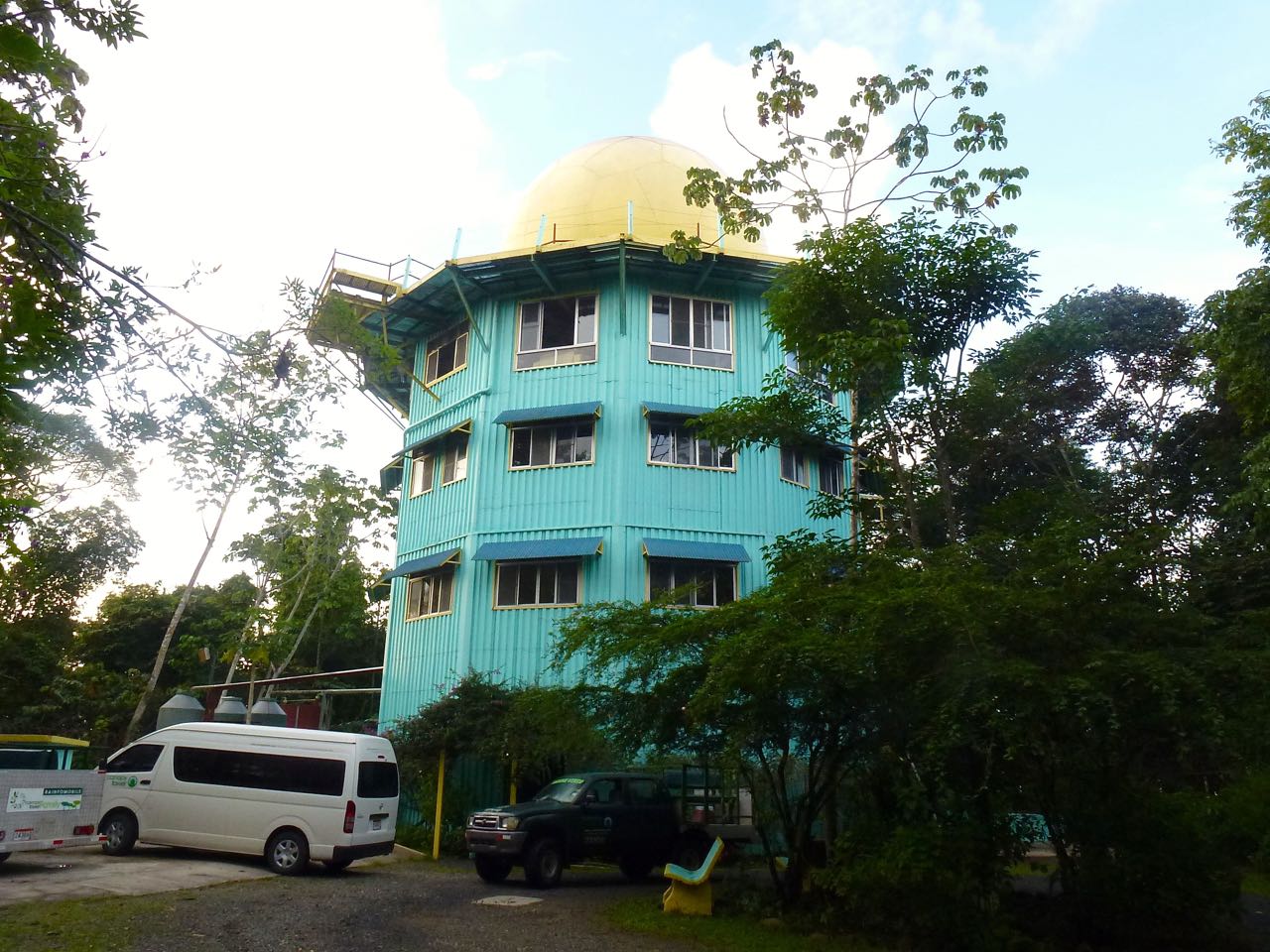 Canopy Tower - Photo by William Young
Canopy Tower - Photo by William YoungMy two favorite sightings involved mammals. I saw a pair of Mantled Howler Monkeys, and one had a baby clinging to her as she climbed through the trees. I previously had heard the howlers. And right outside one of the windows in the library was a bedraggled Brown-throated Three-toed Sloth. Sloths are cooperative photo subjects, because they do not move much. I still have trouble understanding why sloth is one of the seven deadly sins. This one looked like Rodin's The Thinker.
October 5
Alexis, a guide for Canopy Tower, took me and a New Zealand naturalist named Tony to the Achiote Road, the town of Achiote, the town of Providencia, the Gatun Locks of the Panama Canal, the mangroves on Fort Sherman Road, and Fort San Lorenzo. This entire area is on the Caribbean side of the canal, near Colon. We left at 5:35 and did not get home until 6:20. The morning was rainy, and we birded for much of it under umbrellas. Despite the bad weather, I saw more than 110 bird species, as well as many other forms of wildlife.
The first area where we stopped on the way to the Achiote Road had a lot of Barn Swallows, who are migratory, as well as resident Gray-breasted Martins. These two species were the most common members of their family I saw throughout my trip. Later in the day, we saw migrant Northern Rough-winged Swallows as well as one Mangrove Swallow. I saw Red-breasted Blackbirds in the fields. These birds are mostly black, with a bright red breast. A Pale-vented Pigeon perched on a tree. The Canopy Tower checklist says this species is abundant, but throughout my trip, I did not see many. One of the most common raptors is the Yellow-headed Caracara. We saw one this morning eating roadkill, and I saw the buff wing patches when it flew.
When we got to the Achiote Road, we saw a family of Spot-crowned Barbets. They are closely related to toucans, but much smaller. They have a relatively large gray bill, but it is not close to the size of a toucan's. We scoped a White-headed Wren perched high in a tree. This species, who is in the same genus as the Cactus Wren, neither looks nor acts like any of the other Central Panama wren species. Its tail and wings are brown, but the rest of it is white, and it is larger than most tanager species. Skulking in the bushes was a Bay Wren, who is a rich bay color, with a light throat and barred underparts. A House Wren was nesting in a crevice in the bus shelter at Providencia, flying in and out to feed young. I saw the Plain Wren, who like a lot of the wrens here is loud and skulks; it finally popped out. We heard a Buff-breasted Wren, but did not see it.
We saw a female Blue Cotinga, who is brown and spotty. Some Purple-throated Fruitcrows were in the area. They are in the cotinga family, and only the males have the reddish-purple throat. They are chunky black birds who are much smaller than American Crows. The only corvids in this part of Panama are Black-chested Jays, who are big and raucous. We saw a group of them in Providencia, and their yellow eye stands out on their black face. We saw both Yellow-rumped and Scarlet-rumped Caciques. Each species is predominantly black, except for the rump, and they both have blue eyes. Some of the Scarlet-rumped appeared to be all black. They build hanging nests, and we saw one nest hanging from a utility wire. A Scarlet-rumped Cacique nest hangs near the front entrance to Canopy Tower. The caciques are in the blackbird family, as is the male Yellow-backed Oriole we saw. This species is yellow, with black wings, tail, and face. We saw a smaller Orchard Oriole, who looked like a male with faded plumage. The oropendolas are in the same family, but about twice the size. The Crested Oropendola is the larger and less common of the two we saw. Its tail is almost all yellow, with a bit of black in the middle. The smaller and more common Chestnut-headed Oropendola has yellow only on the outer tail feathers. Seeing the chestnut head was difficult on wet birds in bad light, but I saw it later in the trip on oropendolas perched in sunshine. The name "oropendola" comes from Latin, meaning "gold feather". I saw a lot of anis. The Common Ani has a bump on its upper mandible. The Greater Ani is bigger, with a bigger tail, a yellow eye, and no bump.
While riding along the Achiote Road, we saw a Rufescent Tiger-Heron in a field. In another field was a Wattled Jacana, which we saw both on the ground and in flight; it had yellow on its open wings. A little farther on, we saw a Limpkin in a field where cattle were grazing. The bird flew to a branch of a tree about 15 feet off the ground. Its yellowish bill had a dark tip, and its feathers were a rich brown.
We saw a lot of Keel-billed Toucans. The only Chestnut-mandibled Toucans were a pair in flight. Toucans in flight look like flying sickles, with their large curved bill held at an odd angle. There were quite a few Collared Aracaris, who seem to be aggressive. Of the four woodpeckers we saw, the Red-crowned looks like a Red-bellied, and the Black-cheeked sounds like one. The Lineated looks like a Pileated and is in the same genus. The Crimson-crested is another large woodpecker and is in the same genus as the Ivory-billed.
On the Achiote Road, I had a nice scope view of a Mealy Parrot, who is large and has a big white eyering. We saw a lot of Red-lored Parrots in flight. They have a slow and shallow wingbeat. We had a scope view of a distant Blue-headed Parrot in the rain, and we could make out the blue on its head. We had scope views of chunky Orange-chinned Parakeets near the locks. The only Ruddy Ground-Dove we saw was in a tree.
We saw 4 trogon species. We saw a female Slaty-tailed on the Achiote Road and the similar Black-tailed in the mangroves – the latter has a yellow bill, while the former’s bill is red. Both are large. We had nice looks at a pair of White-tailed Trogons. And we saw a female Gartered Trogon, who used to be called the Violaceous Trogon before being split.
The Ringed Kingfisher was the most common kingfisher species. It looks much larger than the Belted, whom we saw at distance at the locks. In Providencia, we saw a Green Kingfisher, who has a loud piping call. We saw a tiny Pied Puffbird and had a better look at the larger Black-breasted Puffbird, perched on a wire. The only antbird was a Pacific Antwren, who looks like a misproportioned Black-and-white Warbler. There were a couple of Thick-billed Euphonias. The males do not have a dark throat, and they have a yellow crown.
The only ovenbird we saw was a Plain Xenops, hanging from a branch. We saw three species of woodcreepers. The Straight-billed Woodcreeper was in the mangroves. We saw a pair, with an older and younger bird, and the younger one had a darker bill. The Streak-headed Woodcreeper was also in the mangroves, as was a Cocoa. Identifying woodcreepers is a challenge. A couple are significantly smaller, but most are about the same size, shape, and color. One needs to look at subtle differences in plumage on the breast, throat, head, and back. Bill size and shape is important.
A lot of swifts flew near the bus stop at the entrance to Providencia. Among them were Lesser Swallow-tailed Swifts, who are long and narrow, showing white on the neck and body. The Short-tailed Swifts have short tails. Some swifts appeared to have somewhat longer tails, and they could have been Chimney Swifts. Swifts are difficult to identify, because one seldom gets prolonged looks at them as they whiz by.
We scoped a perched Rufous-tailed Hummingbird. A Scaly-breasted Hummingbird was perched near a coffee plantation before we ate lunch. We saw a tiny Stripe-throated Hermit, who looked little larger than a locust. We had long looks at a female Sapphire-throated Hummingbird at the fort, and a fleeting glimpse of the male. We also saw a female Violet-bellied Hummingbird on the Achiote Road.
Panama has a great variety of flycatchers. The best flycatchers of the day were a pair of Long-tailed Tyrants. The male is a monochrome bird with a tail almost as long as his body. The tail splits in the middle. The female does not have a long tail. We saw a pair of migrant Eastern Kingbirds to go along with the very common Tropical Kingbirds. There was an Eastern Wood Pewee and a Great Crested Flycatcher. We saw the similar Social and Gray-headed Flycatchers. The Gray-headed has a head that is noticeably lighter than the Social's. We saw both Great and Lesser Kiskadees. The latter has a smaller bill and a two-note song. The Great Kiskadee is raucous, with a variety of calls, one of which is the basis of its name. At Fort San Lorenzo, we saw a Yellow-bellied Elaenia who seemed to be glued to its perch.
We saw a pair of White-shouldered Tanagers — the males are mostly black. There were Palm and Blue-gray Tanagers, as well as a Crimson-backed Tanager. I saw a female Scarlet Tanager. The star was a male Flame-rumped (or Lemon-rumped) Tanager, who has a bright yellow rump on a jet black body. I saw four species of warblers. A few Tennessee Warblers were in the mangrove swamp. Also in the swamp were Prothonotary Warblers — a habitat similar to where one generally sees them up north. We saw a couple of Yellow Warblers, who were not the Mangrove Yellows, even though we saw them in mangroves. We saw a couple of Northern Waterthrushes in Providencia, and in addition to hearing their chip notes, I heard one sing. A Bananaquit was in a palm tree. At Providencia, we saw a Thick-billed Seed-Finch, a small black bird the size of a sparrow, but with a bill the size of a grosbeak. There were some Variable Seedeaters. A young Black-striped Sparrow looked a bit like a faded adult.
We saw a few raptors. Near the locks was a pair of American Kestrels. We saw a light-phase Short-tailed Hawk and about five Common Black Hawks, including an immature. We saw a flyover Great Blue Heron and quite a few Little Blue Herons; both species are migrants. A couple of Snowy Egrets were at the locks, a lot of Cattle Egrets were with cattle, and a few Green Herons flew over; all three species are residents. We saw Brown Pelicans near the fort and a Magnificent Frigatebird near the locks. From the fort, we scoped a Willet. In the same area, we saw large flocks of Blue-winged Teals in flight; we also saw some near the locks. Spotted Sandpipers were in a number of places.
As for non-bird species, we saw a lot of Common Morpho butterflies as well as a Banded Peacock. A River Otter crossed the road in front of us in the mangrove swamp. A White-nosed Coati was at the entrance to the fort, showing its long tail. We saw quite a few Central American Agoutis, who look like giant guinea pigs. We saw a group of White-faced Capuchin monkeys as well as a pair of Geoffroy's Tamarins grooming each other.
The dogs here are surprisingly docile. When we stopped to eat lunch, one came to the place where we were eating, hoping for a handout. It appeared to have a lot of scars on its head, and it followed our every move. As we were preparing to leave, Alexis threw a sandwich onto the ground, which the appreciative dog gobbled up.
October 6
Today was the first day I saw sunshine, although it was raining by midday. It was also the first day I went to the observation platform at the top of Canopy Tower at dawn. The first bird I heard was a Rufous Motmot. I saw two Red-lored Parrots in a tree. They have black on their primaries which you can see when the birds are perched. A surprise was seeing two Glossy Ibises fly by — the only two I would see in Panama. After breakfast, as we were preparing to get into a vehicle, I saw another Eastern Wood Pewee. They seem to be everywhere. I saw a male Green Honeycreeper and a Palm Tanager. In a tree near the observation platform across from the front door was an Olivaceous Woodcreeper, one of the few woodcreepers who is not difficult to identify because of its small size and small bill. A Long-billed Hermit streaked in. I saw a Mantled Howler monkey in a tree, stretching as if he had just awakened.
Alexis took me and four other people to the Metropolitan Park in Panama City. It is the only large forested park in any Latin American capital city, and it has more than 470 acres of dry lowland pacific forest. To get there, one drives along the canal and through parts of Panama City. On the way, I saw Whimbrels in a field at the domestic airport. I also saw Great Egrets and Tropical Kingbirds.
At the park, we saw a Big Belly Tree, which Alexis said is the national tree of Panama. A friend who works for the Smithsonian later told me that these trees are related to cacao trees. He said the tree is in genus Sterculia, which is named after the Roman god of fertilization and manure. A Hoffmann's Two-toed Sloth was sleeping in a tree, looking like the end of a wet mop. We saw another one later, as well as a couple of Brown-throated Three-toed Sloths. They are the ultimate tree-huggers. The Crimson-backed Tanager is stunning, with crimson-and-black plumage and a silver beak. The tiny Southern Bentbills have a bent upper mandible, and they make a noise that sounds like a joy buzzer. I saw a Northern Waterthrush. The White-vented Plumeleteer is a big hummingbird, with a white vent and a long tail. A Rufous-breasted Wren was cooperative, with a black-checkered throat and a striped tail. The Rufous-and-white Wren and Black-bellied Wren were singing, but we did not see them. A Zone-tailed Hawk flew over; it has a long tail, and the shape is only slightly different from a Turkey Vulture.
We saw a very yellow Acadian Flycatcher. We also had a nice look at a Veery on the ground, who was first misidentified as a Gray-cheeked Thrush. We saw a couple of Swainson's Thrushes, and I heard the whit note many times. There was a female Summer Tanager. I saw a male Black-and-white Warbler foraging in hanging vines, and I did not get on a Worm-eating Warbler that some people saw, because I was looking at a pair of Red-crowned Ant-tanagers. The male looks a bit like a slightly washed-out male Summer Tanager.
I saw a male Rosy Thrush-Tanager, who has a dark back, a rosy breast, and a white eyeline. Nobody else in our group saw it, and I did not realize how difficult they are to see. They skulk on the ground, persistently singing a loud three-note song. We heard others, but never saw them. Most of the other people saw a female and young male Lance-tailed Manakin, but I did not get on either. We saw a perched Streaked Flycatcher, who has a rufous tail and a streaked body, and a Yellow-Olive Flycatcher. I saw a Western Slaty Antshrike, who is dark gray with white dots on his wing. We had a nice scope view of a Keel-billed Toucan.
Along one of the paths were Ortiga plants, which have huge leaves and cause an allergic reaction similar to poison ivy. We saw a Cuipa tree, which is tall and thick. Alexis said native people use them for canoes. There were Heliconia flowers in many places, and I saw a Heart-spotted Heliconia butterfly. There were Common Morphos, and I saw an Owl butterfly. It was large and brown, with an eyespot on the underwing. The top of the wings are a beautiful blue in front and gold on the back. A lot of leafcutter ants were working industriously. Some crawled up and down the wooden barrier to one of the footpaths.
One of the two highlights of the trip was seeing a group of three Panamanian Night Monkeys perched on the rim of a hole. The two young were on top of the adult. They have sweet faces and tiny hands. The other was seeing a Common Potoo, who a ranger pointed out in a tree at the entrance to the park. From one angle, the potoo looked exactly like the continuation of the branch it was resting on. It looks like a somewhat fatter version of the Australian frogmouths. On the ride back to the Tower, we saw a Savanna Hawk in a field at the airport. It is large and rufous. A sign on the way back to Canopy Tower said Access a diablo.
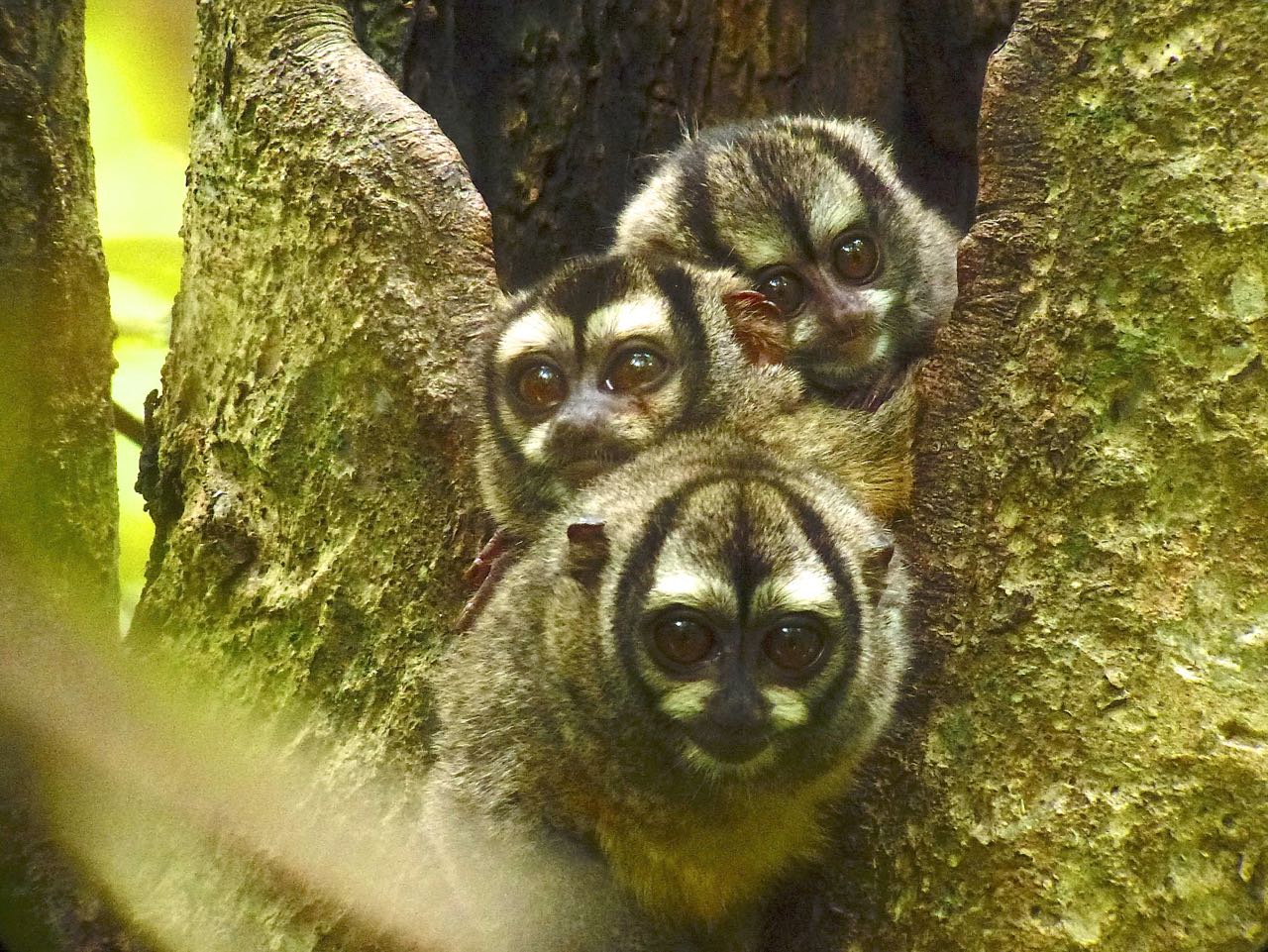 Panamanian Night Monkeys - Photo by William Young
Panamanian Night Monkeys - Photo by William YoungBack at the Tower, I had a great look at a Blue-chested Hummingbird from the window of my room. I had seen one earlier at ground level, and it looked dingy, but the one from my window showed a beautiful blue sheen on the side of its throat and breast and an iridescent green back. Before lunch, I saw a perched Black-breasted Puffbird from the window near the dining table.
After lunch, a guide named Michael Castro took me and Tony to the Summit Ponds on Old Gamboa Road. Shortly after we arrived, it started to rain fairly hard, so we did not stay long. Two of the first birds we saw were a pair of Bat Falcons perched on top of a water tower, looking like two ornaments on the supporting poles. I saw the face pattern and the rufous leggings on these small falcons. There was a perched Yellow-bellied Elaenia, showing a ruffled crest. A little further on, we saw two distant Boat-billed Herons in the scope. One had its back to us, and the other was on a nest, with its bill pointed down to about 7 o'clock. We did not see them well.
Among the migrants we saw were a Prothonotary Warbler in good plumage, another Northern Waterthrush, and a Baltimore Oriole. As with many other places, there were Eastern Wood Pewees. We also added two new mammals: two Red-tailed Squirrels and a Variegated Squirrel. The squirrels here seem to have bushier tails than Gray Squirrel.
October 7
Alexis, Tony, and I left Canopy Tower at 5:30 to go into the highlands by way of Panama City. It was the first day I did not see any rain, and the weather in the highlands was cooler and less humid. Our first stop was at Cerro Jefe at 3,300 feet. We found a Blue-black Grassquit near the entrance to the path we walked up, and we saw a group of Gray-headed Chachalacas in the trees, forgetting that they are not songbirds.
The first special bird we saw was a female Yellow-eared Toucanet. She did not have a yellow earpatch like the male, but otherwise looked the same, with a two-toned bill attached to a mostly black-and-green body. We saw a female American Redstart and a Northern Waterthrush. A couple of Lineated Woodpeckers were in the trees. Five Mealy Parrots flew over, using a similar short, shallow wingbeat as the Red-lored Parrots.
We found two White-vented Euphonias. They have a yellow cap and a black bib. We had close looks at a Thrushlike Schiffornis, who is about the size of a Swainson's Thrush. We saw the olive-brown race, who is olive, with brown wings and a slightly lighter throat. They stay around the forest floor and can be difficult to find, but this one behaved as if we were not there, popping into plain view. It kept dipping its head as if looking for something, and when it vocalized, we could see the inside of its mouth, which is red.
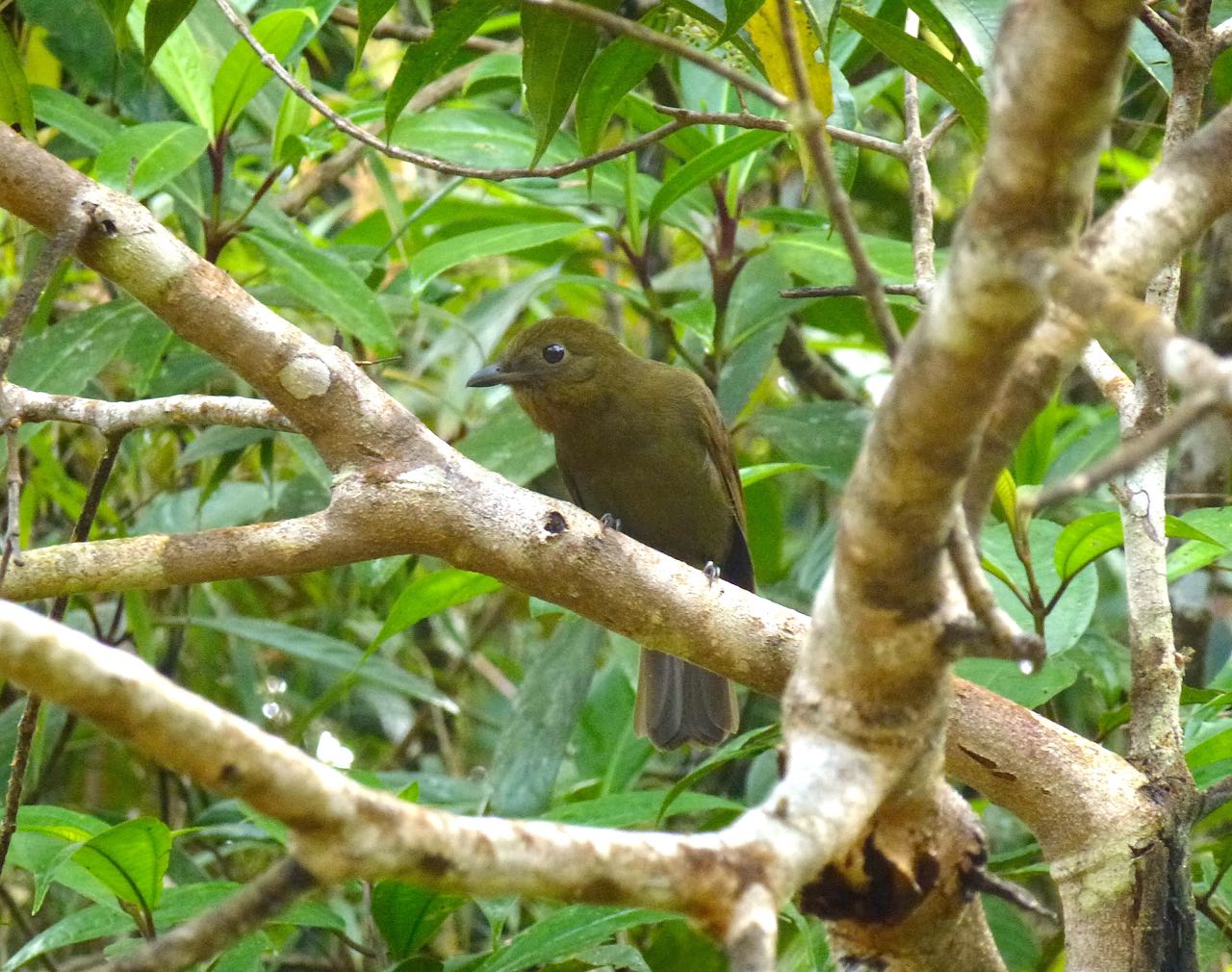 Thrushlike Schiffornis - Photo by William Young
Thrushlike Schiffornis - Photo by William YoungWe had a scope view of a Black-and-yellow Tanager, which is bright yellow, with black wings. I got a quick look at a Rufous-winged Tanager in a tree. I could see the brownish head and green body, but its wings were concealed behind a leaf before it flew. The nest of a Bay Wren was next to the path; it is a leafy ball. When we got back to the entrance, a half dozen Blue-fronted Parrotlets flew across the road, but I did not see any of the fieldmarks. A conifer near the entrance had a bunch of Tennessee Warblers and one Blackburnian Warbler.
 Bay Wren Nest - Photo by William Young
Bay Wren Nest - Photo by William YoungWe then drove toward Cerro Azul, which is at 2,500 feet. We entered an enormous gated community, and we had to pay to enter. We tried to find a Scaly-breasted Wren, who was calling nearby. A House Wren hopped on a steep roof. We drove past a lot of chicken farms, which had many birds confined into small spaces.
We then went to the Kaufmann House, which is owned by the American Karl Kaufmann and Rosabel Miro, who is Panamanian and the executive director of Panama Audubon. In the back of the house is a patio surrounded by eight hummingbird feeders. Many flowering bushes and trees are in front of the patio, and beyond these is a spectacular view of the valley. Take this beautiful setting and mix in more than a hundred manic hummingbirds of 13 species and you have the recipe for an overwhelming experience. It is hummingbird heaven, but a challenge if you are trying to do an eBird count. Sitting and watching this profusion of hummers can be exhausting. After a while, I could identify most of them, with the only challenges coming on some of the females. The hummers seem to have a pecking order that is not based on size. Some of the smaller hummers drive away the large ones. The hummers also drive away other birds. We saw them buzz a Tennessee Warbler and a Baltimore Oriole. The Bananaquits come to the hummer feeders, but they warily approach before drinking. Red-legged Honeycreepers came to the feeders, as well as Yellow-faced Grassquits.
One of the common hummers is the Snowy-bellied Hummingbird. It looks like a Rufous-tailed Hummingbird with a white belly. Rufous-tailed Hummingbirds were at the feeders. The Green Hermit is big, with a long curved red bill and a tail with a couple of feathers extending beyond the end, making it look even bigger. It is one of the big hummers that sometimes is driven away by the smaller ones. It is greenish, and there were also a couple of Long-billed Hermits, who are brownish on the back instead of green like the Green Hermit. The White-necked Jacobin is another large hummer who sometimes is bullied by the smaller ones. The males have a narrow strip of white between their purple head and green body. The tail of both the male and female has a lot of white in it, which along with the size is a way to identify the female. She is plainer, with a scaly breast and no purple on the head. The Bronze-tailed Plumeleteer looks a lot like the White-vented Plumeleteer, except that it has less white on the vent and red feet instead of black. There were Blue-chested Hummingbirds, who are common around Canopy Tower.
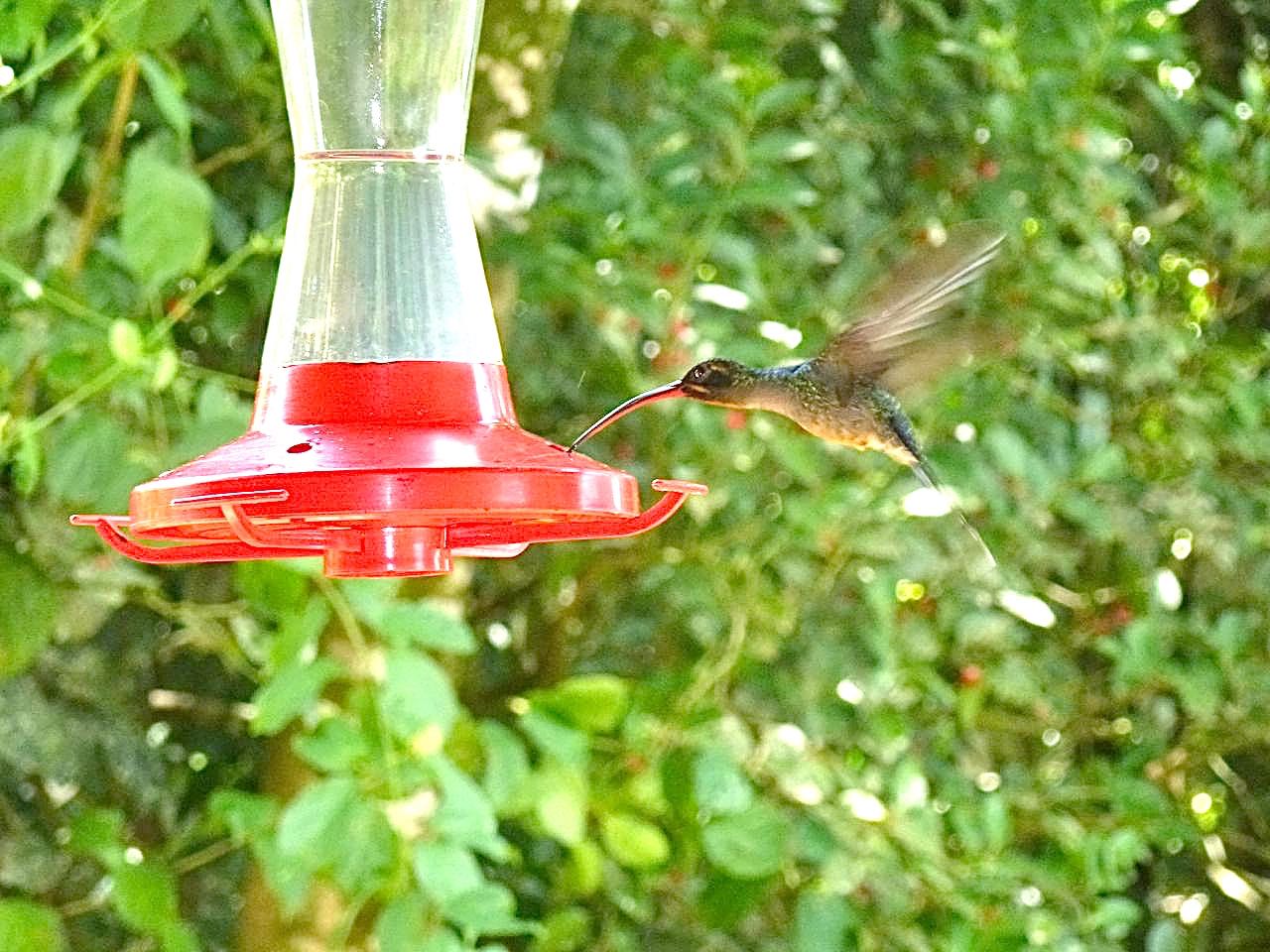 Green Hermit - Photo by William Young
Green Hermit - Photo by William YoungA lot of hummers have "purple" or "violet" in their name, which can be confusing. The Violet-headed Hummingbird is small and does not come to the feeders, preferring to stay in the nearby flowers. The male has a purple head and a white spot behind its eye that makes it look like the birds in a lot of my bird photos — the bird equivalent of "red eye" in many photos is "white eye". The Violet-capped Hummingbird is electric green, with a violet cap. The Violet-crowned Woodnymph is larger than the previous two, with the male combining a brilliant green throat with a purple cap. His vocalizations sound like the horn on a clown car. The Purple-crowned Fairy was one of my favorites. It is longer than the woodnymph and much sleeker and delicate looking. It is green on the back and white underneath. It spread its tail more than the other hummers. It also is bullied by the smaller hummers. The Brown Violetear is harder to find but easy to identify. Because it is mostly brown, it looks like none of the other hummers at the house. It has a pale malar stripe and a purple patch by the ear, One was up in a tree, contorting its body to sun itself.
We saw a couple of notable hummingbird species. One was a female Green Thorntail. She does not have the long forked tail of the male, but she is still striking. She is mostly green, with a white malar stripe, a white band above her tail, and some white patches on her sides. But the really special one we saw was a White-tipped Sicklebill. We hiked down a steep path to reach some large heliconia flowers — one of the types the bird likes. Each blossom is big and red, and each stalk has about 20 blossoms — imagine a stalk with 20 male Northern Cardinals pecking at it, ten on each side. The sicklebill prefers the ones in the shade. We waited near some of these plants, and one of the sicklebills appeared briefly. Even with a brief look, the profile was unmistakable. It is much broader than most hummingbirds, and its bill is huge and curves downward, almost forming a semicircle. After it left, we waited a bit and then left to have lunch. On the way back up the hill, we saw a female Checker-throated Antwren, a tiny bird who did not have much checkering on her throat. There was a Western Slaty Antshrike, who seems to be the most common of the antbirds. We saw an adult male and young male Black-throated Trogon. The adult male is the only trogon in Panama who is green on the back and yellow underneath. At one point, I had the male Black-throated Trogon in the same binocular field as a female Slaty-tailed Trogon.
We had a nice view of a male Hepatic Tanager. It is slightly darker than a Summer Tanager, with a dark bill instead of a light one like the Summer Tanager. We saw other Hepatics during various parts of the day. There was a Canada Warbler in fall plumage in the nearby bushes. It had only a faint necklace. Pink-cheeked Heliconian butterflies were in the area, along with a species of clearwing and a yellow Julia. An ameiva lizard ran along a path near the patio.
We had some good sightings from the lawn as we looked into the valley. About seven Mississippi Kites in various plumages flew over, not far from us. Way down in the valley, we scoped a pair of White Hawks, who were wafting in the breeze. They have a short white tail with a black terminal band. Their underwings are mostly white, but their upperwings have a lot of black on them. We also saw a soaring King Vulture. It was too far away to see detail on the head, but we could see the dirty white body (darker than a White Hawk) and the black feathers on the underwing. We saw in the distance a kettle of hundreds of Broad-winged Hawks, with some vultures mixed in.
After lunch, we left the Kaufmann House to look for a Stripe-cheeked Woodpecker, a Panama endemic. At our first stop, we found a pair. The male has a red cap and a red malar stripe, with a buffy stripe above it. His back is green, and he is mottled below. The female lacks the red malar stripe. They woodpeckers are about the size of a Hairy Woodpecker. We had a great look at a Carmiol's Tanager, which is also called an Olive Tanager. It is a nondescript tanager who is almost entirely olive.
What happened next was one of the most memorable birding experiences I have had in a long time. We stopped at the administration office to pay our fee for coming into the area. As we were about to leave, a wave of about 10,000 Broad-winged Hawks started to fly toward us. We were on a mountain ridge, and this is a migratory path for the hawks. I have heard about the waves of hawks that fly through places such as Veracruz, Mexico, but I had never actually seen a wave like this.
We drove down the road, and I had a fleeting glimpse of a Buff-rumped Warbler as it flew into a stream in a ravine. Streams are its preferred habitat. We then stopped at an area to look for a White-ruffed Manakin. We found a female, but no male. The female is a small, round green bird with a dark tail. On the way down, we saw a Scale-crested Pygmy-Tyrant, a tiny bird with a pale eye and a slightly misshapen head. We also saw another Blackburnian Warbler. On the way back to our vehicle, we saw a tiger beetle crawling through the grass.
Our final stop was at the home of an American ex-pat named Bill Arden. He calls his home Casa Colibri, and it has almost as much hummingbird activity as the Kaufmann House. It also has tables with fruit, which gives it an added dimension. Above one of the hummingbird feeders is a basket for fruit, and at one point, it contained three Tennessee Warblers. A feeding table on the deck had a Black-cheeked Woodpecker. I had missed a couple of Bay-headed Tanagers earlier in the day, but one was at a feeding table near where I was standing. It has a bay head, a green back, and deep turquoise underparts. A female Hepatic Tanager came to eat, along with Thick-billed Euphonias in various plumages. The male euphonia has a yellow cap, but no dark bib. Alexis freed a Bronze-tailed Plumeleteer who had become tangled in a string was used to support a feeder that had been taken down for repairs. We could see the tiny red feet which help to distinguish this species from the White-vented Plumeleteer.
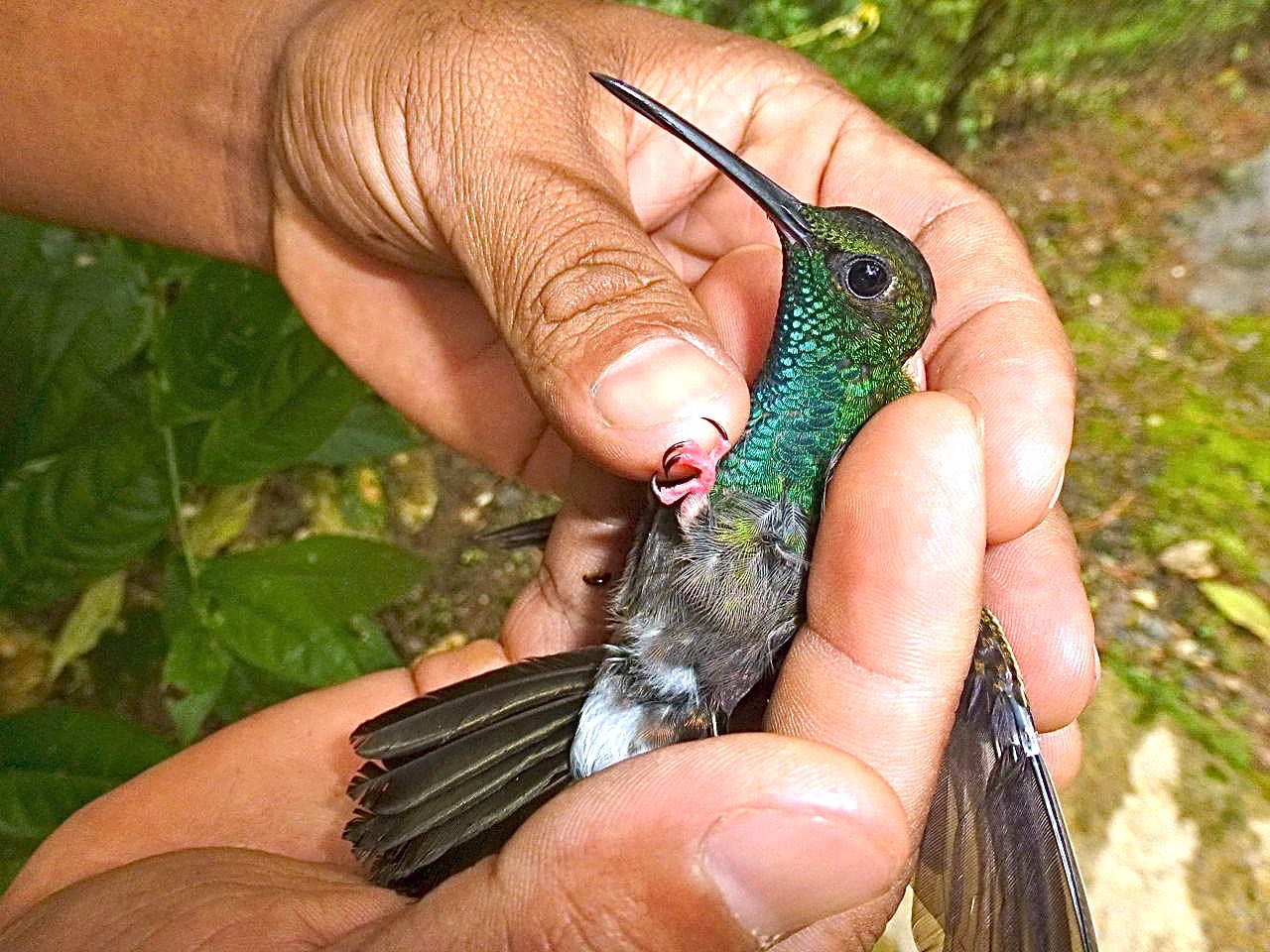 Bronze-tailed Plumeleteer - Photo by William Young
Bronze-tailed Plumeleteer - Photo by William YoungThe two hummers we came to see were a Rufous Coquette and a Long-billed Starthroat. The coquette is a beautiful, tiny hummer who frequents flowers rather than feeders. We did not see one, but we saw a starthroat. It is a large hummer with a bill that is so long that it has trouble drinking and standing on a perch at the feeder at the same time. The only way it can do it is to shove the bill halfway in so that it can get close enough to stand on the perch. It is also distinguished by its white malar stripe. It would frequently be chased from its favorite feeder by the Jacobins.
October 8
Today was another good weather day, so I am beginning to dry out a bit even if my clothes are not. At 6 a.m., I went to the observation deck. There was a perched Tropical Pewee, who is slightly smaller than the more plentiful and vocal Eastern Wood-Pewees. Three Collared Aracaris were nearby, and I could see a lot of the detail on their plumage and enormous bills. Some Keel-billed Toucans were mixed in. Alexis scoped a pair of Scaled Pigeons perched on top of a tree; they are scaly below and have a two-toned red-and-yellow bill. Some Band-rumped Swifts flew close to the Tower, and on a few I could see the band on the rump. Some Lesser Swallow-tailed Swifts were mixed in; they are one of the easier swift to identify because of their elongated bodies and the white on the throat and sides.
Scarlet, Plain-colored, and Golden-hooded Tanagers flitted in the trees with Green Honeycreepers and a pair of Blue Dacnises. The female dacnis is green, with a blue cap. I saw a Gray Kingbird, who does not have the white terminal tailband of the Eastern Kingbird. Alexis scoped a Crane Hawk. It had its back toward us, so all I saw was a dark gray back. We heard Great Tinamous and saw flying Mealy Parrots. A Golden-winged Warbler was in the branches, and I saw it just as it was flying. I could see the golden patches on the wings, but I did not see the face. A Tennessee Warbler foraged in a nearby tree.
After breakfast, Michael took me and four others to the Plantation Road at the base of Semaphore Hill road (which leads to Canopy Tower). On the way down, we saw a Red-tailed Squirrel and a Broad-billed Motmot. This was the first motmot I saw on the trip, even though I have regularly heard the Rufous Motmot. The Broad-billed looks like a small Rufous, with a large bill and a small patch of subtle green feathering on the throat that can be difficult to see. On the Plantation Road trail, we saw a pair of Spotted Antbirds in a ravine; the female has a more complex pattern on her back, but the male has a crisper band of black spots going across his white breast. A cooperative female Blue-crowned Manakin perched near us, looking like a little green bird from a Fernando Botero painting — puffy and round. I later saw a male Red-capped Manakin. I was looking at him on the ground in a ravine, so I did not see his yellow pants, but I saw the bright red cap on his jet black body.
Michael saw an ovenbird called the Scaly-throated Leaftosser, and even though it is one of my favorite bird names, I did not manage to see it. I did see a bizarre species called a Streak-chested Antpitta. Imagine a Swainson’s Thrush with very long legs and virtually no tail and you will get a rough idea of the plumage. It has vertical streaks on the breast rather than spots. This bird is somewhat rotund, and when it calls from a log on the forest floor, its entire body inflates. I have never seen any other bird species do this.
We found a Tamandua in a tree. It is a type of anteater, with coloration similar to a Giant Panda. Its head is tan with a long snout. It snuffled down the tree and walked away. At one spot, we saw three Panamanian Night Monkeys in a tree, but we did not get as good a view as we had on Saturday at the Metro Park. We found some Jaguar poo, but there was no jaguar. The Jaguar had apparently recently eaten a peccary or an agouti, because the poo had bits of hair in it.
We saw both a two-toed and a three-toed sloth. I found the two-toed in a tree, seemingly waving his arms. There was a couple on the walk named Marcella and Scott, and when Marcella saw it, she excitedly called to Scott (who was down the trail taking photos) to hurry and come see it before she realized that you don’t have to hurry to see a sloth. This one did not look like the end of a wet mop, having dried out after the rains. It looked shaggier than other sloths I have seen and not as bedraggled.
We had a great look at a male White-whiskered Puffbird. It is puffy and sat still in a tree. In the scope, I could see a touch of white near the base of its bill. We saw a female Black-throated Trogon, who is brown on back, yellow underneath, and has barring on her undertail. We found a male Slaty-tailed Trogon, who looked as if he had just bathed; he was vigorously preening on a high branch. When he finished, he came down lower and lower until he was only about 12 feet off the ground. I saw a Plain Xenops. It is a small brown bird with two white facial stripes. Even when backlit, it can be identified by the way it behaves, hanging on branches and leaves in awkward positions.
I saw some new birds for the trip. One was a Ruddy-tailed Flycatcher, a small flycatcher with a ruddy breast and tail. The Olivaceous Flatbill is olive, with a larger bill than many other flycatchers. There was a family of Dot-winged Antwrens. The male is all dark, with dots on his wings and a wingbar, and the female is rufous below; at one point, the male fed the female. I saw a Golden-crowned Spadebill, a small flycatcher who makes a Golden-crowned Kinglet look big. It has a distinct facial pattern, with an earpatch, and I saw the gold in its crown. I saw a couple of White-breasted Wood-Wrens. They have short tails, which makes them look chunky, and a complex black-and-white cheek pattern. They are loud and active.
After lunch, a small kettle with about 30 Broad-winged Hawks flew over. There were huge numbers of Gray-breasted Martins in the sky; I later saw more huge martin flocks. Today, I probably saw a couple of thousand martins. I had to remind myself to keep looking into the sky at this time of year. I walked down the road that leads to Canopy Tower, and on the way, I saw a Black-breasted Puffbird perched close to the road. Michael came by to pick me up a bit before three, and we went to the Ammo Dump ponds just past Gamboa, a short ride from the Tower.
One of the first birds we saw was a Yellow-billed Cuckoo. Other North American migrants were a few Yellow Warblers, a Prothonotary Warbler, and a Northern Waterthrush. All of these birds were in a habitat similar to where they can be seen in the north. I saw another Gray Kingbird, as well as Social Flycatchers and Lesser and Great Kiskadees. Some of the Great Kiskadees were raucous and uttered a two-note call rather than their usual three-note Kis-ka-dee vocalization. We saw a Boat-billed Flycatcher, who looks like a Kiskadee with a larger bill.
Michael found a Nine-banded Armadillo in the grass near the road. It eventually came out and snuffled around, seemingly oblivious to us. While we observed it at close range, we had a great look at a Gray-necked Wood-Rail. This rail is big, with a brownish body and a gray neck. In the same area was a big Green Iguana on a branch a little above eye level. We later saw a female Purple Gallinule, who is brownish, with a lot of white in a tail, which she frequently cocked. She uttered a lot of little chink notes, like a Rose-breasted Grosbeak, and would occasionally let out a loud squawk. We heard a White-throated Crake calling, but this tiny rail would not show itself. As we waited for the crake, a lot of Orange-chinned Parakeets were in a trees above us, occasionally squabbling with each other. One of the trees with the parakeets also had Thick-billed Euphonias, one of the most common euphonias here. Across the street were a Ruddy Ground Dove, in bright ruddy plumage, and a pair of Ruddy-breasted Seedeaters. The male seedeater was in ratty plumage, but the female looked as if she had spent more time on her appearance. Way up in the sky was a Plumbeous Kite, which Michael identified by shape. I saw a Common Tody-Flycatcher, who is tiny, with a black back and yellow underparts. The first Osprey of my trip flew over.
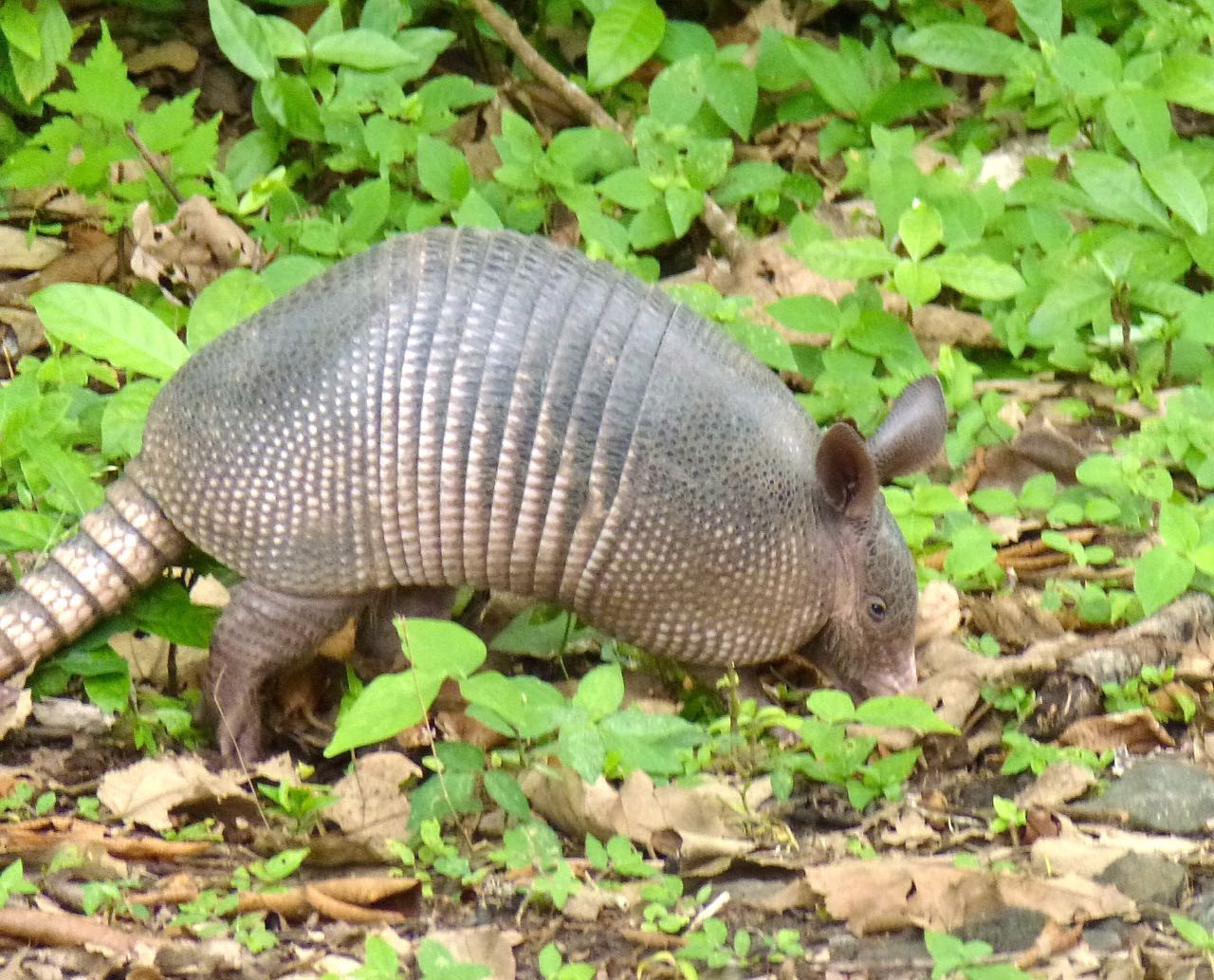 Nine-banded Armadillo - Photo by William Young
Nine-banded Armadillo - Photo by William Young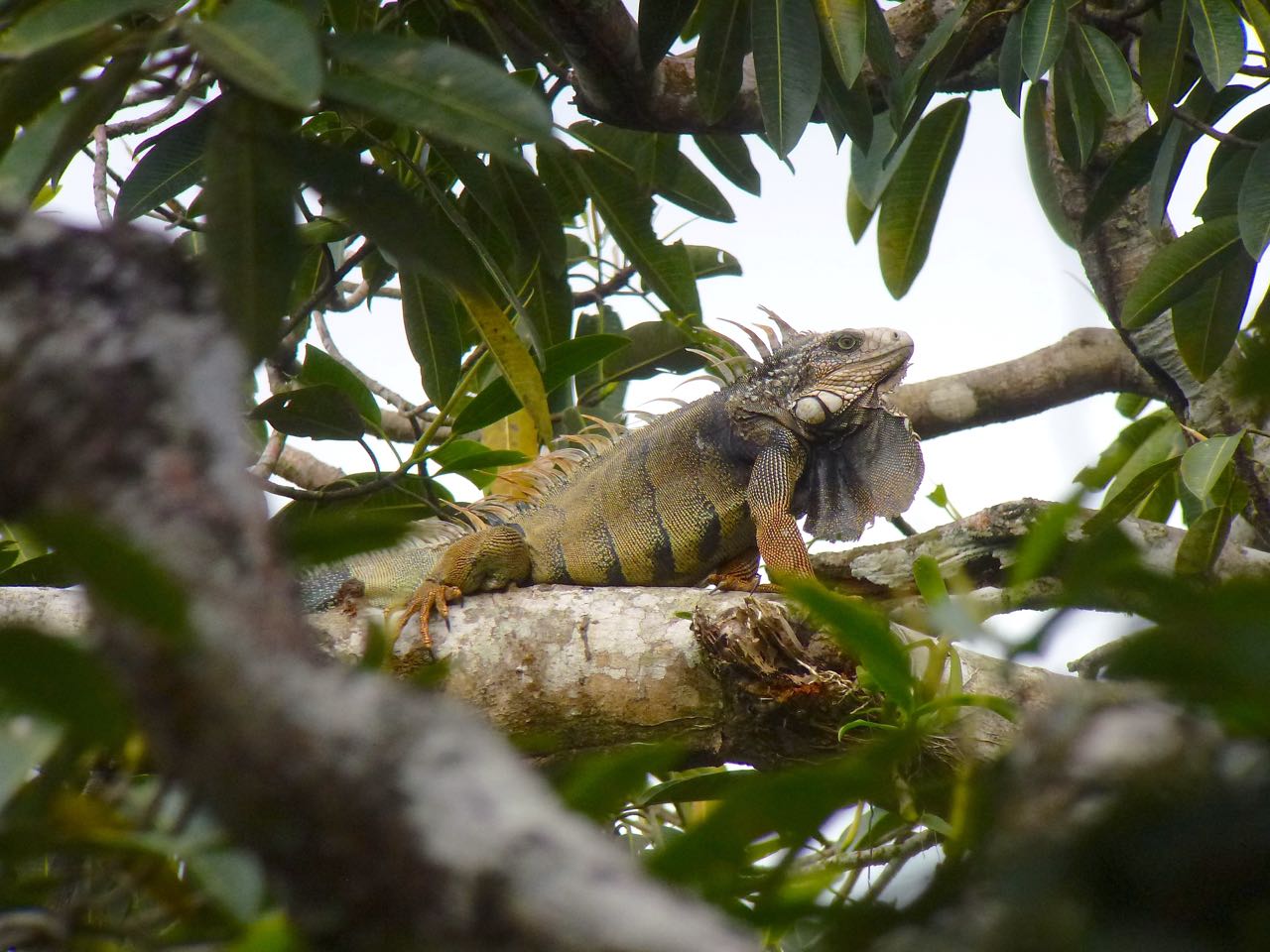 Green Iguana - Photo by William Young
Green Iguana - Photo by William YoungWe saw a female Barred Antshrike, who has a large light eye that makes her look like a character from Sesame Street. I later heard a Barred Antshrike vocalizing in a way that sounded like an American Crow. There were both Northern and Southern Rough-winged Swallows. The Southerns have a buff throat. We saw some fly over one of the ponds and drink without landing. They would hit the water with considerable force, which did not seem to bother them. A Green Heron flew across one of the ponds, and a Rufescent Tiger-Heron was sitting on a nest. In the same area was a solitary Black-bellied Whistling Duck, sitting in a tree. The colors on this beautiful duck seemed bright.
The day ended with two entertaining events. A female Yellow-headed Caracara was in the top of a tree. A male flew in to mate with her and landed on top of her rather than on the tree before mounting her. I have seen male Ospreys do this also. The two caracaras let out a few post-coital screams before flying away. We then went to the town of Gamboa where a Fork-tailed Flycatcher in the top of a bare tree. Another one was on a different tree nearby. The first bird occasionally left the perch to flycatch. It flew high into the air, spreading its remarkably long tail, looking like a little Swallow-tailed Kite. The two sides to the tail are kept together when the bird is perched. We watched it for about fifteen minutes. This bird provided a wonderful ending to another remarkable day.
October 9
I went to the observation deck before sunrise. Fog covered almost everything around the canal and toward Panama City, but the area around the top of the Tower was clear. Howler Monkeys vocalized in the background as the sun rose. I saw four species of tanagers in one tree — Scarlet, Golden-hooded, Palm, and Plain-colored. Fulvous-vented Euphonias and Green Honeycreepers were mixed in. I have been pleasantly surprised by the Plain-colored Tanager. Instead of being dull gray as shown in the field guide, it is a striking gray-and-black. It always looks angry. I saw a young male White-shouldered tanager, whose tail feathers were brownish instead of black. A lot of plumages of many species are not pictured in the field guide. On birds who look similar, such as young or female tanagers, identifying them can be difficult.
One of the best birds of the morning was a Green Shrike-Vireo, who is a canopy specialist. An advantage to being on the observation deck above the canopy is that one can observe the entire body of canopy birds rather than only the underside. This bird is a lovely green, with yellow on the throat and a strip of blue on its neck. It has a loud, persistent three-note call. In the same tree were a Red-eyed Vireo and a Tennessee Warbler, which provided a good comparison between the two. I saw the front of a Streaked Flycatcher; previously, I had seen the species only from behind. I saw the lines on its head and streaked breast. I also had a much closer look at a Scaled Pigeon and saw the scaling and the two-toned bill. I saw a Squirrel Cuckoo, with its long rufous body, very long tail, and yellow bill. It sometimes appears to be moving through the trees like a squirrel. I saw a Forest Elaenia, which is one of many little green flycatchers. While we were on the platform, a Bat Falcon sped past. Band-rumped Swifts flew close to the Tower, showing the band on their rump.
This morning, I was the only guest using a guide – in fact, for most of the day, I was the only guest here. Michael and I walked down Semaphore Hill Road. We saw an Ochre-bellied Flycatcher. We soon found a pair of perched Broad-billed Motmots. They have long tails with racquet tips, and one of them swung its tail back and forth like a pendulum. We saw a Dusky Flycatcher, who is a slightly smaller version of the Great Crested, and a Canada Warbler in the same tree. We found a Plain Brown Woodcreeper. This species lacks the head and breast markings of many other species of woodcreepers. It has a short, dark straight bill.
A star bird of the morning was a Semiplumbeous Hawk. It is lead-colored on the back and white below. It has red feet, a black-tipped red bill, a red cere, and a yellow eye. We watched one in the scope for awhile. Its call is a loud ker-WEE. It is a very pretty hawk. Michael said he had not seen one in about a year. They are not rare so much as difficult to find.
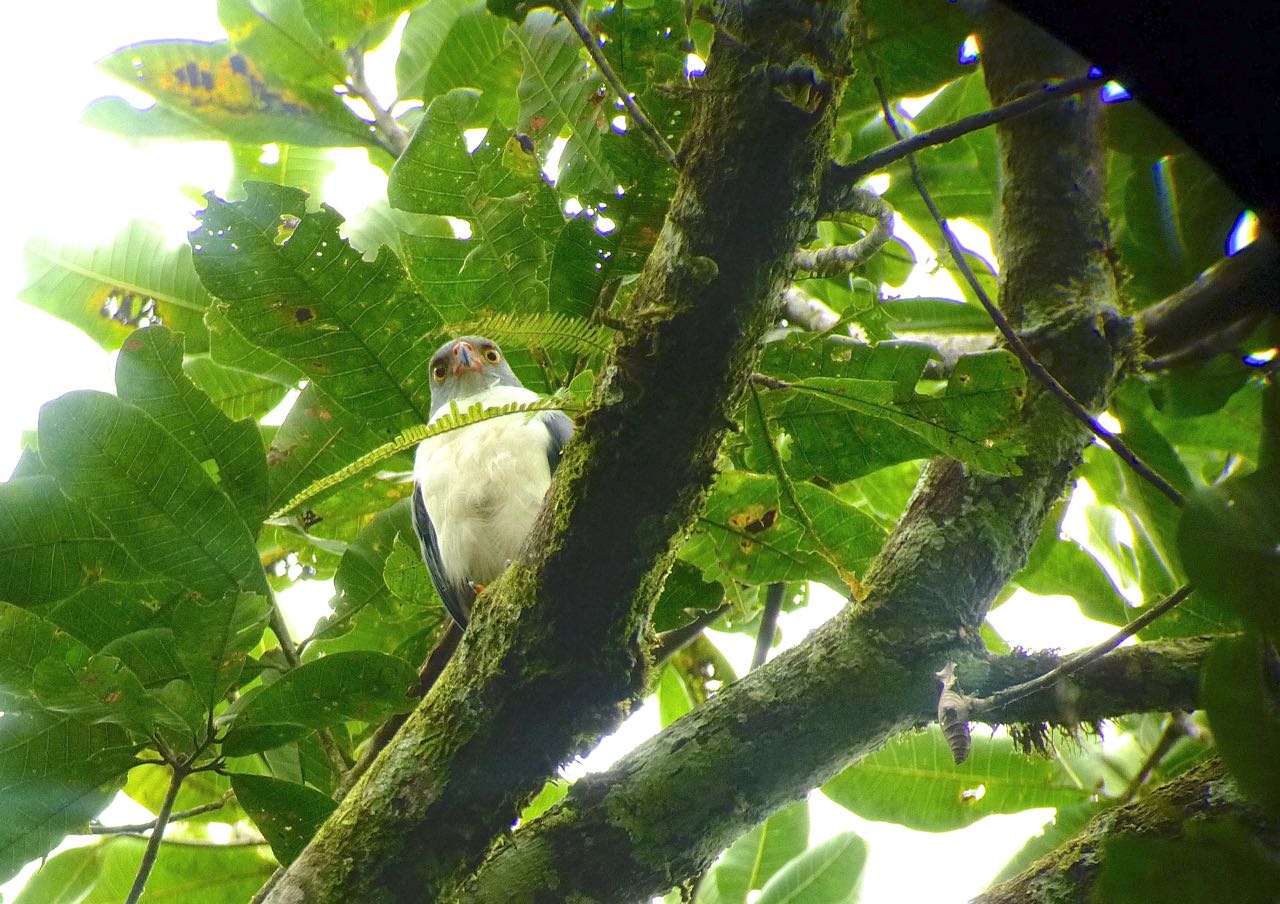 Semiplumbeous Hawk - Photo by William Young
Semiplumbeous Hawk - Photo by William YoungI had a nice look at a tiny Golden-crowned Spadebill. And I had a better look at an Olivaceous Flatbill, who has a bill like a Boat-billed Flycatcher. I saw a lot of antbirds. The Bicolored Antbird is brown below, white above, and has bare skin around the eye. The Checker-throated Antwren is a tiny brown bird with markings on its throat. The male Dot-winged Antwren is one of many slaty-gray antbirds with dots on its wings. He also has white edges on his black tail. The White-flanked Antwren is a bit different, with a distinct white mark on its flank. The Chestnut-backed Antbird flicks its tail a lot. A male Fasciated Antshrike was sitting on a nest. He has a red eye, and his streaks are closer together than on the male Barred Antshrike. Part of the bottom of his bill was white. I saw a Western Slaty-Antshrike, who seems to be the most common antbird here. We heard the loud call of the Bright-rumped Attila, but did not see it.
 Fasciated Antshrike Male - Photo by William Young
Fasciated Antshrike Male - Photo by William YoungWe saw a couple more White-whiskered Puffbirds. One sat right in front of us, and we could see the little tan speckles on his back and some dirt on his bill, probably from some recent excavation. If you find one of these birds, you can watch it for a long time, because they don't move much. There are other birds such as motmots and trogons who behave the same way. We saw an agouti, chewing loudly on palm nuts. We walked to a spot where a Great Potoo has been hanging out, but it was not around. In the woods along the main road, we found an area with a family of Yellow-margined Flycatchers. The yellow margins on its wings at times look like vertical stripes. In the same area was a vireo with yellow flanks, probably a Philadelphia. Michael looked at two hawks way up in the sky and called them a Gray-headed Kite and a Swainson's hawk, The Gray-headed Kite has broad wings. Later, a kettle of about 500 Broad-winged Hawks passed through.
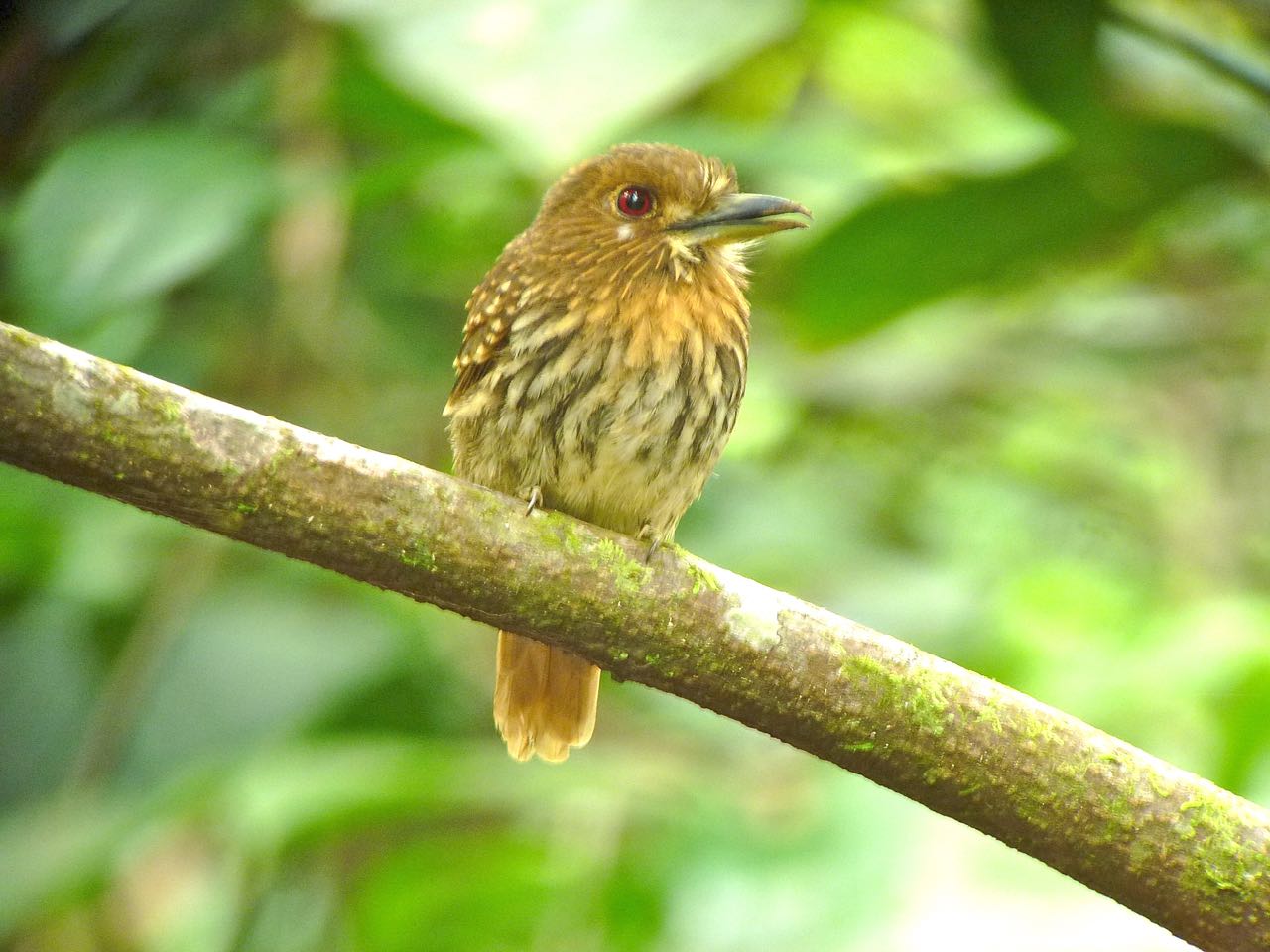 White-whiskered Puffbird - Photo by William Young
White-whiskered Puffbird - Photo by William YoungAnother good bird was a young male Cinnamon Woodpecker. It has a hammerhead look. I saw red near the chin, and the breast has little black semicircles. The back is a rich cinnamon. It picked a spot and stayed there, giving us long looks. In the same area was a Masked Tityra whose vocalization sounds like an old man saying Eh?
When we got back to the Tower, I discovered that all of my belongings had been taken up one floor. I had started in a small single room with no bathroom and shower. My new room has both, is more spacious, is closer to the Wi-Fi signal, and has a better view of the canopy. I ate lunch alone, because no other guests were here. A birder from England named Martin arrived this evening. The name of my new room is Collared Forest-Falcon, while Martin is in the Masked Tityra room.
After lunch, Michael and I hopped into a vehicle. As we were going down Semaphore Hill Road, Michael spotted a Rufous Motmot. It is larger than the similar Broad-billed Motmot, but it has no green on the throat. Like the Broad-billed, it moved its long tail back-and-forth. We then went to the Gamboa Rainforest Resort at the Panama Canal. We crossed a one-lane bridge, with the canal on one side and the Chagres River on the other. The resort runs along the Chagres. Near the entrance, Michael found a Whooping Motmot, which used to be called the Blue-crowned. The blue on its head forms a jagged circle and looks like a crown that a king would wear.
I saw two new woodcreepers for the trip. The Streak-headed Woodcreeper is smallish and has a streaked head and breast. The Northern Barred Woodcreeper is rufous, and we could see the barring on its front and back. The barring is so fine that it almost gives the appearance of ruffled feathers. We once again heard the White-throated Crake, but did not see it. A pair of Yellow-crowned Euphonias was in a tree. I saw the female, but missed the male. I briefly saw a Buff-breasted Wren skulking in the marsh. It was near a spot where we had a wonderfully close look at a Rufescent Tiger-Heron. Among the North American migrants were a Prothonotary Warbler, a bunch of Yellow Warblers (including a male with red streaks), and a Northern Waterthrush, which I saw while Michael was off getting our vehicle as a rainstorm was rapidly approaching.
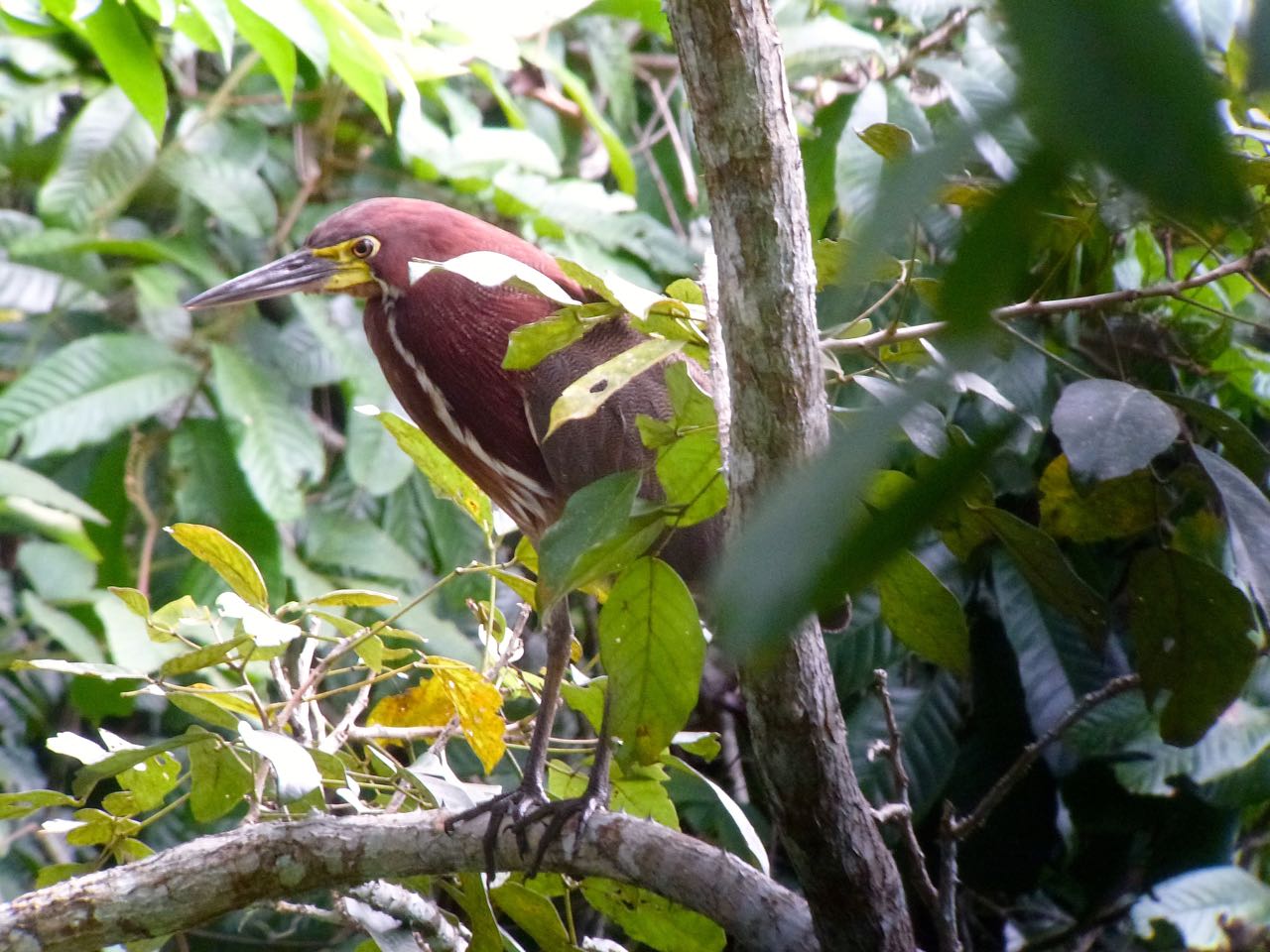 Rufescent Tiger-Heron - Photo by William Young
Rufescent Tiger-Heron - Photo by William YoungDuring the rainstorm, we stood under an awning. There were two Common Moorhens in the river. Mangrove Swallows were perched nearby, and I had a much closer look at the white rump than I had previously. A Spotted Sandpiper landed on one of the docks. Across the river, we saw a group of birds that included Great Egrets and Little Blue Herons. I also had a chance to experiment with my camera and discovered that I can digiscope with video. Before March, I had never owned a camera, and before a few days ago, I had never tried to digiscope. The guides here encourage digiscoping. I practiced video digiscoping on one of the Great Kiskadees who perched near us. I could see the yellow on top of his wet head.
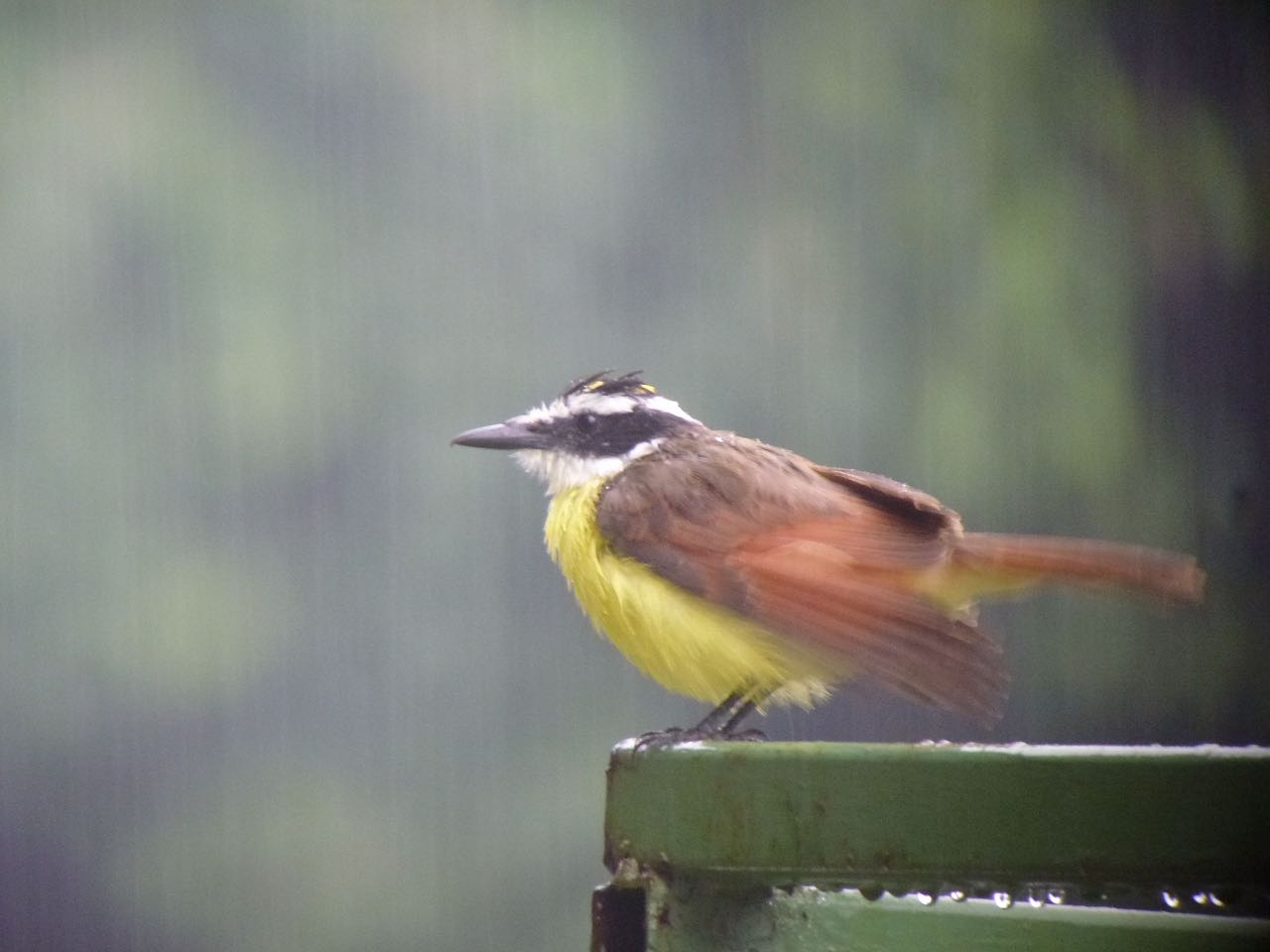 Great Kiskadee - Photo by William Young
Great Kiskadee - Photo by William YoungWhen the rain let up a bit, we saw two male Purple Gallinules and a youngster. The behavior of one of the males was strange. This beautiful bird with the two-toned bill would suddenly would let out a chink note and violently raise his wings as if he had just received an electric shock. It was not evident why he kept doing this, but it was funny nonetheless.
 Purple Gallinule - Photo by William Young
Purple Gallinule - Photo by William YoungBefore we left, we walked through a grassy area, where we saw a Yellow-bellied Elaenia in a tree. It has a crest and wingbars. We also saw a small group of Smooth-billed Anis and a Grey-headed Chachalaca. In a nearby grassy area, we saw eight Lesser Capybaras, who are lesser in name only. These critters are big and heavy. Regarding other mammals, we saw a lot of Central American Agoutis at the resort. Back at the Tower after dinner, Michael spotted a Kinkajou. As for reptiles, we saw the front end of a Narrow-snouted Spectacled Caiman, who was probably about ten feet long.
October 10
Today was grueling, but rewarding. Michael took Martin and me to the Pipeline Road, which is one of the best places in Central Panama to find forest birds. We got off to a difficult start. We left the tower at 6:30, but on the way down Semaphore Hill Road, we encountered a downed tree blocking the road. Michael and another man took about 30 minutes to clear it away with a machete and an axe. When we arrived at the Pipeline Road, it was muddy and rutted. At times, riding on it felt like being in a blender set at low speed. But the birding was fantastic.
One of the highlights was a Great Tinamou. This secretive bird is the first one listed in the field guide. This bird mostly walks around on the forest floor, and its plumage blends in with its surroundings. It is 17 inches long, but actually looks bigger because of its short tail. Michael found one next to the path, and we watched it for at least ten minutes. It did not seem at all wary about us as it pecked around for food. I have heard a Great Tinamou calling almost every day I have been in Panama, but I had not seen one.
A much more uncommon sighting was a pair of Marbled Wood-Quails, who are listed as rare in this part of Panama. Martin and I saw a bird run across the path. It has a brown body, and its face looks red. Michael later got the scope on one, while another one called. The call is loud and sounds like a squeaky wheel on a hospital trolley. The red I saw was actually bare skin around the eye. We then went down the road to do more birding, but one of the wood-quails seemed to be following us. It walked in the same direction we were going, fairly close to the path, calling intermittently.
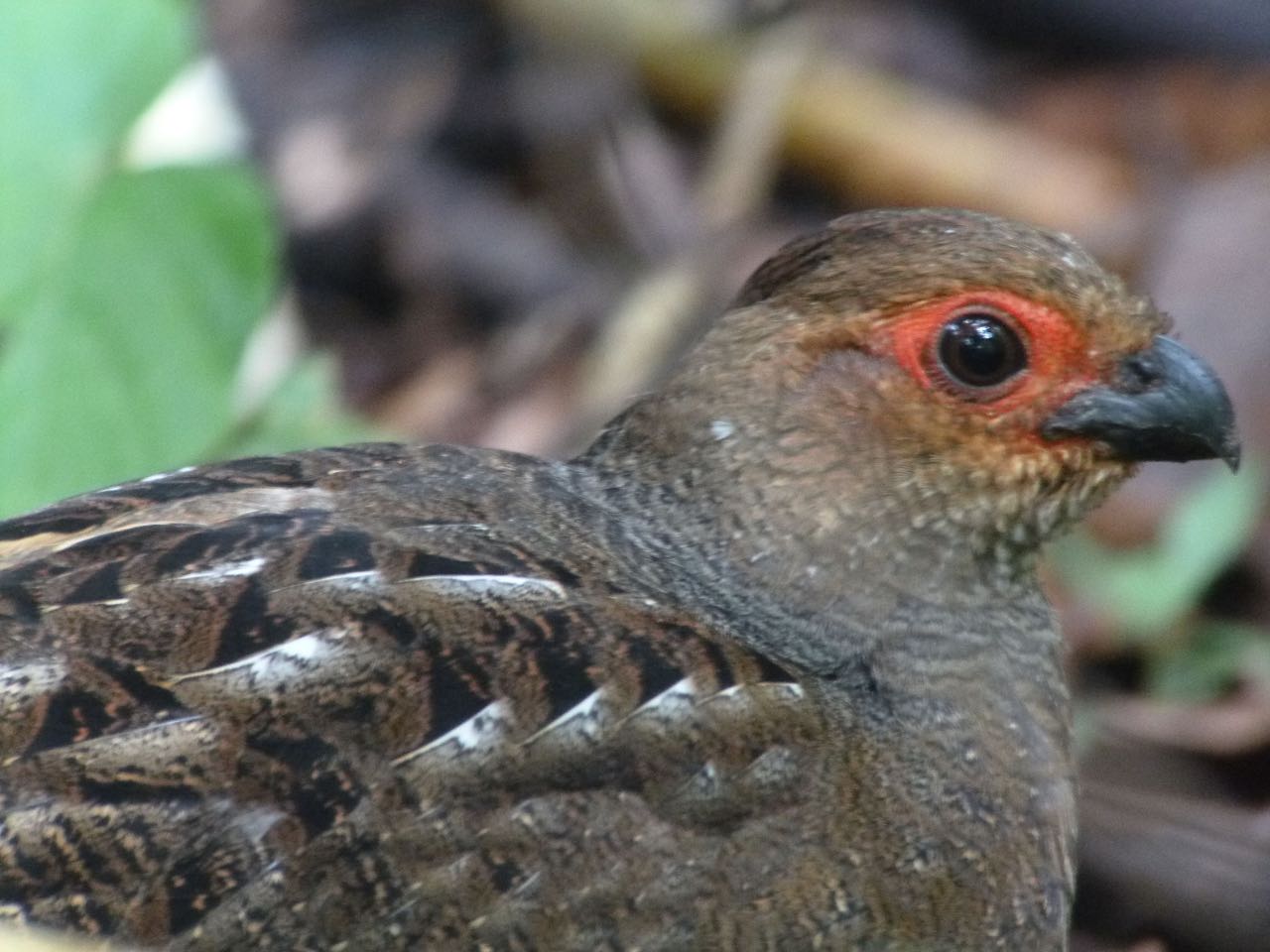 Marbled Wood-Quail - Photo by William Young
Marbled Wood-Quail - Photo by William YoungA lot of Mantled Howlers were screaming. Some were in the trees over our heads, and we had to be careful when they started to drop poo down on us. It mostly hit the leaves. Every minute or so, a gang would all howl at the same time, sounding as if they were cheering at a sporting event. One of the effects of their moving through the treetops was that they disturbed a Choco Screech-Owl, who landed in a branch at eye level, right near where we were standing.
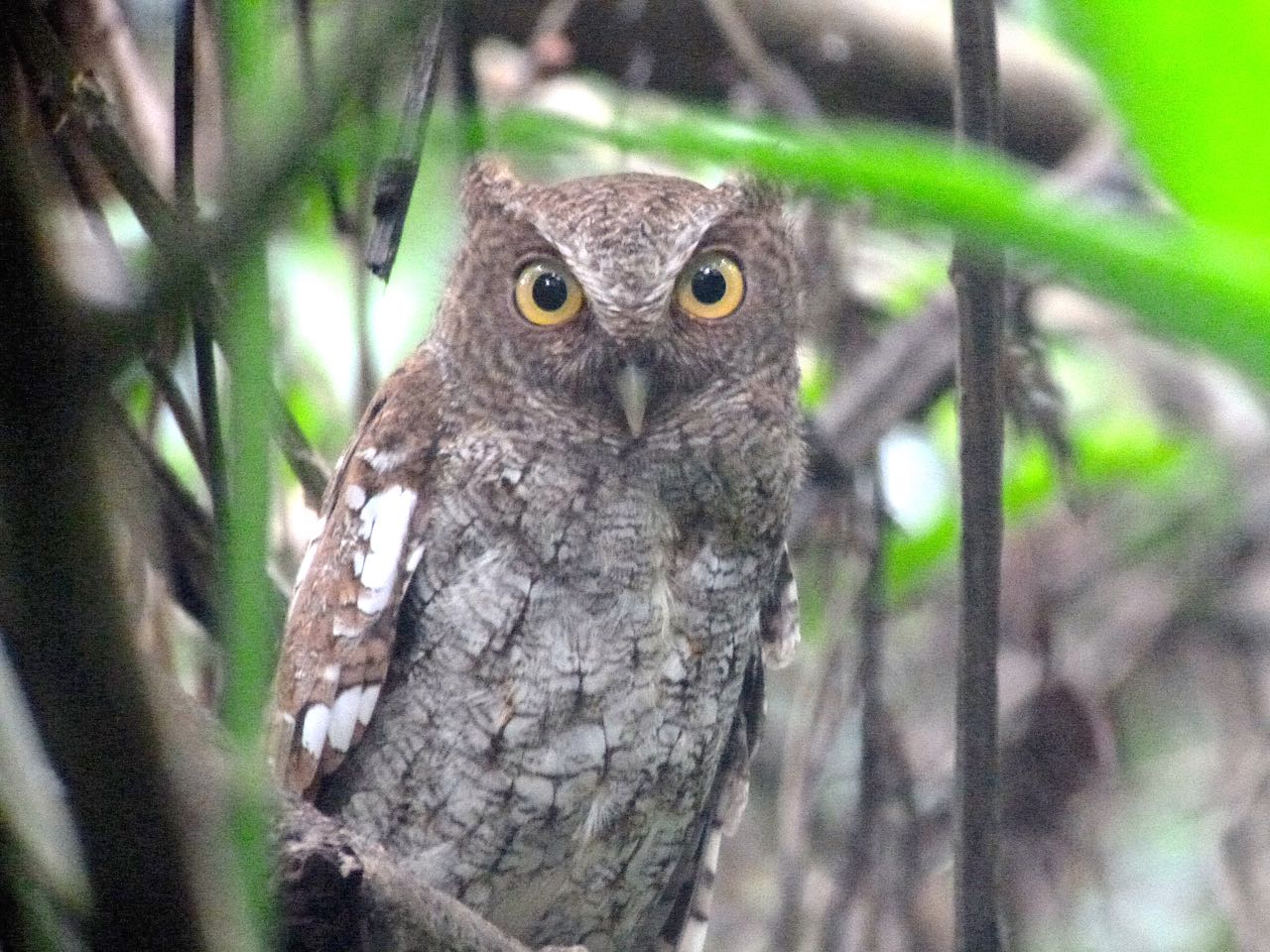 Choco Screech-Owl - Photo by William Young
Choco Screech-Owl - Photo by William YoungWe had wonderful views of two species of manakins. The male Blue-crowned Manakin is jet-black, with an electric-blue crown, while the male Red-capped Manakin is jet-black, with a red cap. These birds are only 3 inches long, and they move around quickly. We found a female Golden-collared Manakin, who is slightly larger and mostly olive-colored.
When we arrived at the Pipeline Road, we had a nice look at a Slaty-tailed Trogon. A Ruddy-tailed Flycatcher came into view, as did two Chestnut-mandibled Toucans. We heard a Black-faced Antthrush, but did not see it. Purple-throated Fruitcrows were in the trees, along with a couple of Yellow-rumped Caciques. I saw a Black-striped Woodcreeper, who has streaking on its back as well as its front. The streaking on the back features a few vertical black stripes. I had a much closer look at a Cinnamon Woodpecker than I had yesterday — a male with a lot of red on his cheek. On the forest floor, I saw a female White-bellied Antbird, who is brown on the back and has a dark cheek. I had a fleeting glimpse of a Black-bellied Wren, who has a rufous back. Both of the antbird and the wren are loud skulkers. A Stripe-throated Hermit flew across the path; it is much smaller than the other hermits. We had nice looks a Rufous Motmot. We heard a calling Collared Forest-Falcon, but never saw it; I wanted to see it, because I am in the Collared Forest-Falcon room at the Tower. Blue Morpho butterflies were everywhere. Their flight is fast and bouncy, which makes them difficult to photograph.
At about 1:30, there was a heavy rainstorm. We broke for lunch and then had to wait until the rain ended. The wait was worth it, because we found an ant swarm. Many birds look for swarms of army ants, who stir up insects and other prey for the birds to eat. These birds who usually skulk on the dark forest floor often forage in the open around an ant swarm. We had amazing looks at a Spotted Antbird, who perched too close for me to focus my binoculars. A pair of Bicolored Antbirds were also there. They are brown on top and white below, with blue skin around the eye. The Chestnut-backed Antbird, a brownish bird with a chestnut back and blue skin around the eye, also joined in the feeding activity.
A Gray-headed Tanager came in; it is yellow below and olive above, with a gray head. It is larger and brighter than the female White-shouldered Tanager, whom we earlier had seen along with her mate. We saw a Plain Brown Woodcreeper, who has a dark malar stripe, and a Northern Barred Woodcreeper. A Red-capped Manakin popped in, along with a Checker-throated Antwren. My favorite bird in the flock was the Song Wren, a small dark wren with a blue orbital patch. We heard this wren’s song, which the field guide describes as sounding like a haywire cuckoo clock.
Other birds we saw included the tiny Tawny-faced Gnatwren, who has a shorter bill than the Long-billed Gnatwren. We saw a Spot-crowned Antvireo, who has little spots on top of his head. A Moustached Antwren foraged in a treetop. Its plumage resembles a Black-and-white Warbler. Throughout the day, the only warblers we saw were about a dozen Northern Waterthrushes. They enjoy feeding near the myriad puddles.
The rains made parts of the Pipeline Road impassable, so we decided to visit the Ammo Ponds. Almost as soon as we arrived, a really heavy thunderstorm blew in. We decided to go back to the Tower, but not before we once again heard the call of the White-throated Crake, which I had heard during the previous two days. When we got back to the Tower, I stayed outside and tried to clean some of the mud off of me, especially one of my shoes that had sunk into the mud on the Pipeline Road. But today was worth getting wet and muddy for.
October 11
This morning got off to a foggy and windy start. At 6 a.m., there was not much action around the Tower. We saw a White-tailed Kite fly by — a white raptor with long pointed wings. We also saw a Mantled Howler breaking off fruits in a tree — these monkeys are vegetarians.
By the time we were ready to leave at 7, the fog had burned off, and the sun was shining. Michael took me and Martin to the Gamboa resort. It is the same place I had gone a couple of days ago, but this time, we went to a different section of the complex. We had a good look at a Buff-breasted Wren, who is a skulker. In terms of volume, this bird sounds at least twice as loud as our Carolina Wren. Many other species here are louder than northern species, especially many of the antbirds. Both male and female birds vocalize here throughout the year. The migrants who come here are usually quiet.
We saw a Common Tody Flycatcher. In a tree in the parking area was a Scrub Greenlet, a small vireo, with a pale bill and a pale eye. It has a gray head, with an olive back and yellow underparts. We later saw a Golden-fronted Greenlet, who has a brownish cap. We saw two Wattled Jacanas squabbling near the water. I saw the giant feet on one of them. Their flight involves flapping twice and gliding, and they have a lot of yellow on their wings. For shorter flights, they fly with their landing gear halfway down. A Giant Cowbird flew by, looking almost as large as a crow.
I saw Great Antshrikes, who like many antbirds, tend to stay in the undergrowth. The male has a black back, white wingbars, and is white underneath. The adult has a red eye, and we also saw a younger male with a dark eye. We saw a male and female Red-throated Ant-Tanager, who are large tanagers with long tails. The male is dark brown with a red throat, and the female is lighter brown with no red on the throat. A pair of Flame-rumped Tanagers was near our vehicle.
We saw a few Cinnamon Becards, who are bright cinnamon. I saw a Yellow-billed Cacique, who has yellow eyes that stand out on its black plumage as much as its large yellow bill. These birds hop a lot through the trees, and apparently, they do not fly well. They can be difficult to find, so we were lucky to see one.
I saw a White-necked Puffbird; the back of its neck has a white band, like some kingfishers. Puffbird and kingfishers tend to sit in the same place for long periods, and the line on the neck breaks up the shape of the bird so that from a distance, a predator would see two shapes rather than an entire bird profile.
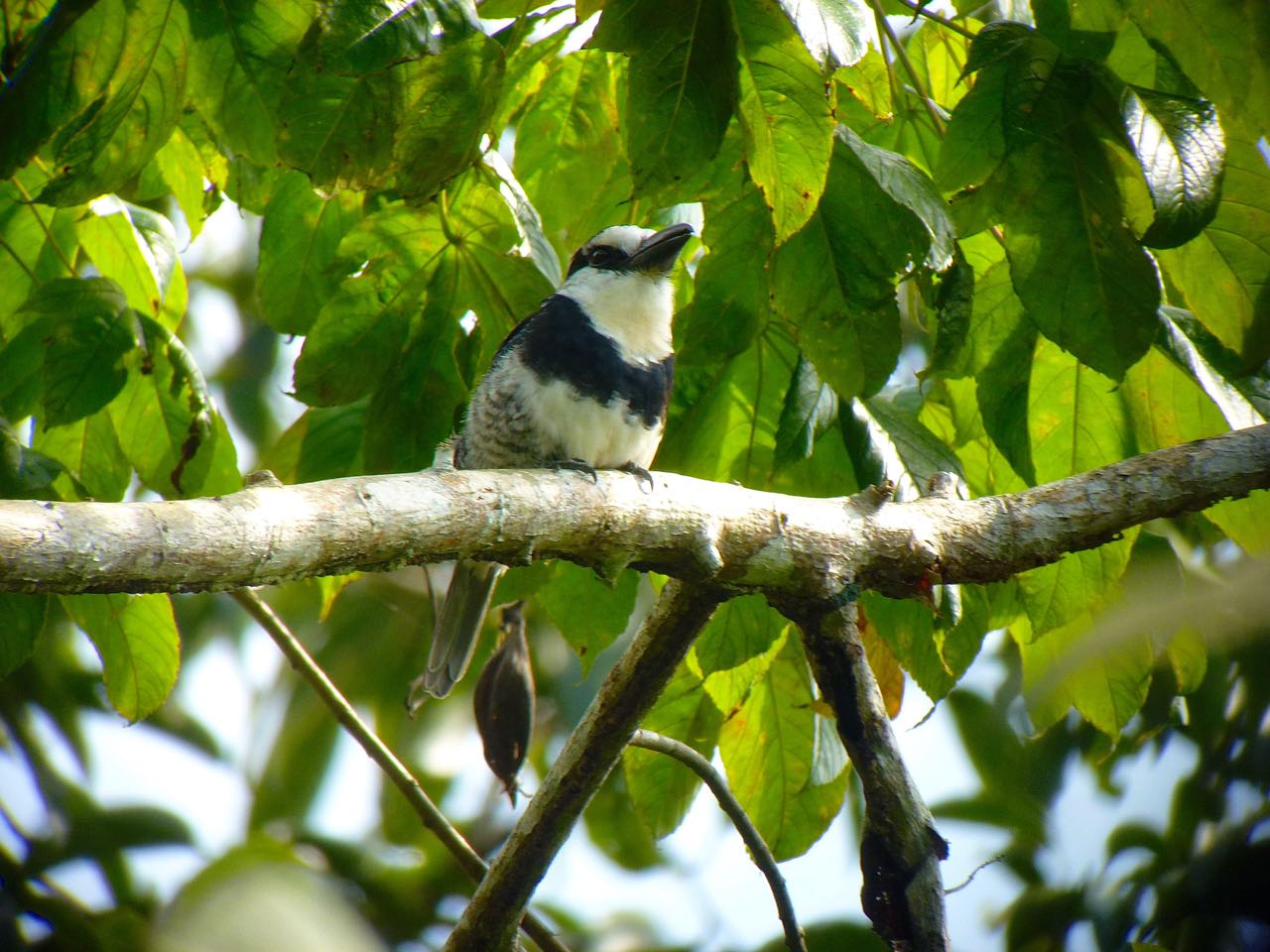 White-necked Puffbird - Photo by William Young
White-necked Puffbird - Photo by William YoungWe did well on the North American migrants. I saw an adult male Mourning Warbler foraging in a low bush. Michael saw a female Chestnut-sided Warbler. I saw a Great Crested Flycatcher and two Baltimore Orioles. Mixed in were a few Red-eyed Vireos. Regarding woodpeckers, we saw Red-crowned, the most common species around here, and a Crimson-crested, we heard a Lineated Woodpecker. There was a Southern Beardless Tyrannulet, who resembles a lot of other flycatchers. I was not able to get on a couple of other tyrannulets.
A highlight of the morning was seeing a Collared Forest-Falcon, which is the name of my room. This bird was an immature, with a barred breast and a brownish back. We saw the bird fly, and it was large and elongated, showing a lot of brown. We then had good looks at it perched in a tree.
Just after we got back to the Tower for lunch, the rains came. After lunch, the rain intensified. Some bolts of lightning hit close to the Tower. As the thunder crashed, so did I, taking my first nap since I arrived. I woke up a little before three, which was when we were supposed to leave on another outing. I quickly got dressed and went outside just as the rain was stopping. A lot of people don't like to visit Panama during the rainy season, and I am not sure why. Martin and I have the place all to ourselves, and there are not many occasions when the rain stops us from birding. The guides tend not to use raincoats or umbrellas, even during driving rain. You basically accept that you are going to get wet and deal with it. The Panamanian children think that heavy rain is funny, and I see them laughing as they walk through it. Often, the birds take cover during the rain, so when it ends, there can be a lot of activity, which was the case today. The rain tends to cool things off, while during the dry season, the heat can become oppressive. The birds at this time of year are more abundant than in most parts of the dry season, because mixed among the residents are a lot of migrants.
Michael had gone home after lunch, and Alexis was back as our guide. We went to the Ammo Ponds and the nearby paths. The third time was the charm for finding the White-throated Crake. This bird is about the size of a Black Rail. We saw a young bird who looked mostly rufous, with a greenish bill and white on the throat. As we were looking down, I had to back up to see it through my binoculars, which close focus to ten feet. Around the same area, we saw two Tropical Mockingbirds, who look like a slightly larger version of the Northern Mockingbird, but lack the white on the wings. They have white on the tail and a yellow eye. Their movements seem more elegant than the Northern Mockingbird.
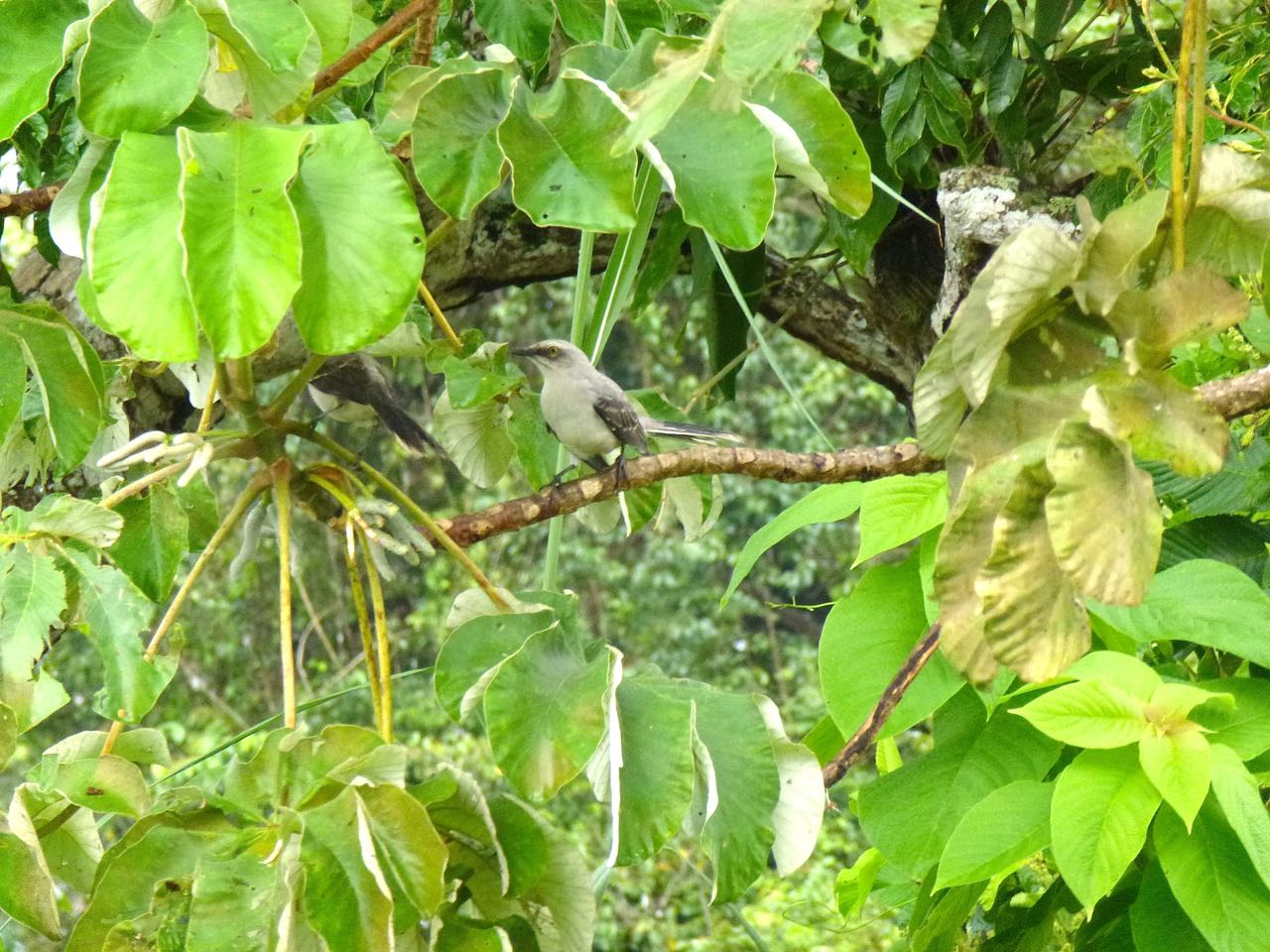 Tropical Mockingbird - Photo by William Young
Tropical Mockingbird - Photo by William YoungTwo Black-bellied Whistling Ducks whistled as they flew over. Their wings show a lot of white. We saw an immature Rufescent Tiger-Heron, who has barred plumage and a narrow strip ran down the middle of its breast. A young Green Heron was also present. Black Vultures, who are common here, perched on utility polls with their wings stretched out like a cormorant, presumably to dry after the heavy rain. A lot of swallows were around. There were a few Cliff Swallows mixed in with the Barn Swallows, Northern and Southern Rough-winged Swallows, and Gray-breasted Martins. A pair of Yellow-headed Caracaras flew over — I don't know if they were the same two who had mated nearby the other day. Earlier in the day, we saw some caracaras eating roadkill.
Near where we saw the crake, we saw what were probably the same four Smooth-billed Anis who were there two days ago. Two of them were on the branch of a tree snuggling against one another. Most birds don't perch so close together. We saw three finches in the reeds. The male Ruddy-breasted Seedeater has a lovely ruddy breast and a slightly darker back. Variable Seedeaters are quite common, and the Thick-billed Seed-Finch is all dark, with a massive dark bill. We scoped one of the seed-finches, who sang from a nearby reed. Later, we saw a female Blue-black Grosbeak, who is solid chocolate-brown rather than either of the colors in her name. Around the same place, a Black-tailed Flycatcher whizzed by. I did not see much other than the yellow rump, but I never remember seeing a flycatcher fly that fast. Most flycatchers are built for maneuverability rather than speed.
We saw a pair of Dusky Antbirds. The male is dusky all over, with wings that are a bit darker. The female is tawny underneath, with an olive back. We found a pair of Buff-throated Saltators, who have big bills and a black semicircle enclosing its tan throat. Chestnut-mandibled Toucans were making their six-syllable call repeatedly in the background, and Mantled Howlers roared from a distance.
We found a nice mixed feeding flock. Among the North American migrants were a Chestnut-sided Warbler, Tennessee Warbler, and Summer Tanager. We saw both male and female Fasciated Antshrikes, who have finely-barred plumage. They also have a large bill, and the male came down below eye level to hunt insects. The female has a russet cap to go along with her barred plumage. Crimson-backed Tanagers were foraging, as was a pair of White-shouldered Tanagers. The female White-shouldered looks like a smaller, duller version of the Gray-headed Tanager. A Bright-rumped Attila was in the same tree, but the light did not enable us to see the bright yellow rump.
As we were preparing to get into our vehicle to go back to the Tower, we saw an adult Rufescent Tiger-Heron standing in the middle of the road where we were parked. As I walked in its direction, it began to walk across the road. It hunched its shoulders and leaned forward as it walked, looking like Groucho Marx.
October 12
This morning, I got up early to look at photos in albums in the dining area. They feature people who have visited Canopy Tower, including Jimmy and Rosalynn Carter, who came in January, 2000, right after the Canal had been turned over to Panama, and Martha Stewart. I also looked at photos showing the process by which Canopy Tower was converted from a military facility to a tourist facility. As I was about to carry one of the albums to a sofa, I noticed a small House Gecko. These little guys are surprisingly loud, and they frequently vocalize around the Tower. I later went to the observation deck, but I did not see much. We had only fifteen minutes before breakfast, and the sun was not all the way up. I saw a Chestnut-sided Warbler. While we waited for our vehicle to leave, I noticed that Blue-chested Hummingbirds sound like electrical sparks when they are around the feeders.
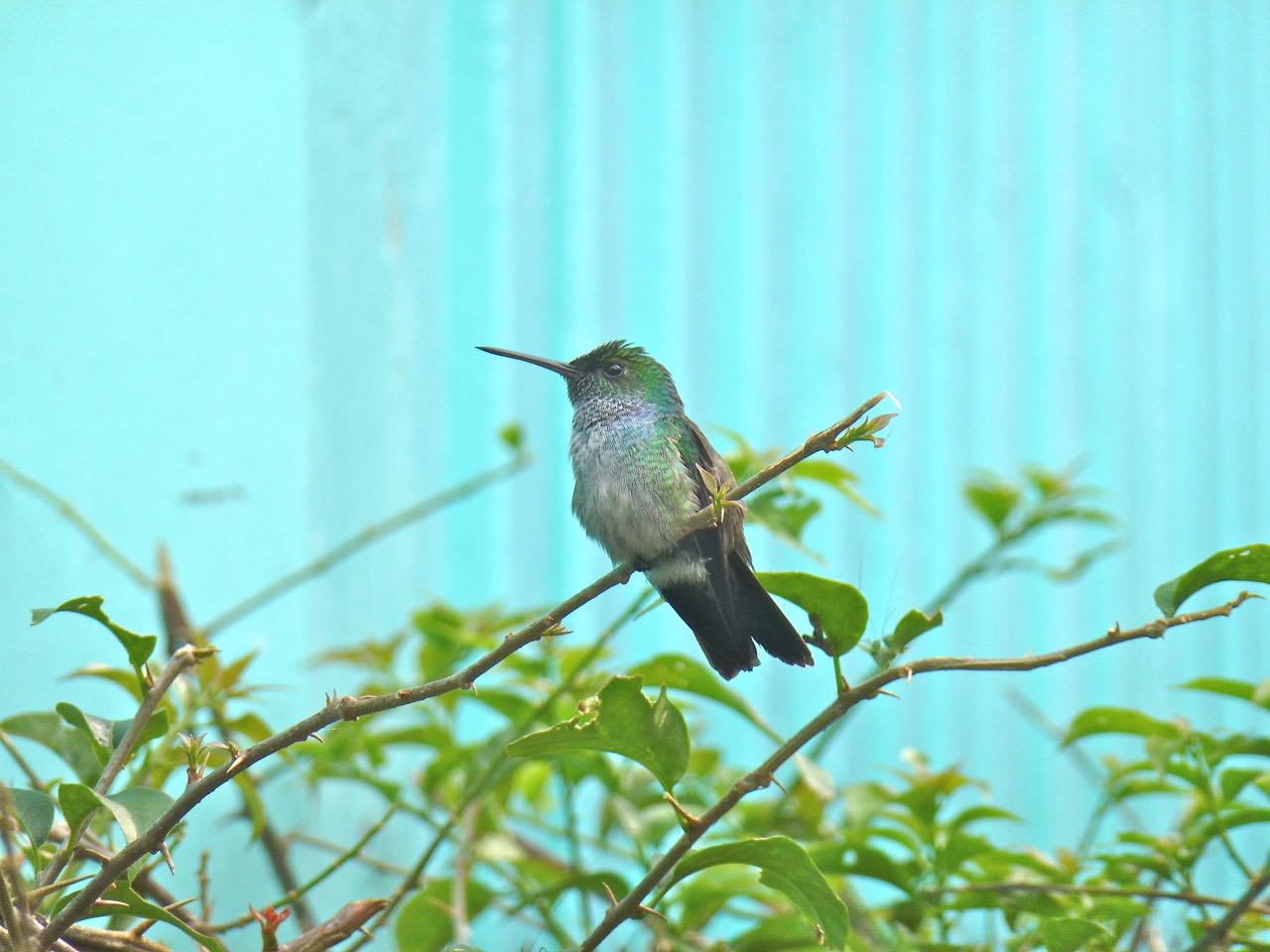 Blue-chested Hummingbirds - Photo by William Young
Blue-chested Hummingbirds - Photo by William YoungThis morning, Alexis took Martin and me to the Rainforest Discovery Center. We went to the Pipeline Road, and instead of bearing right at the main fork, we went left. We climbed to the top of an observation tower that is almost 100 feet high, which allowed us to look out over the canopy. One of the first birds we saw was an immature Great Black Hawk, who has more white on the throat than the similar immature Common Black. We soon saw perched in a distant tree a male Blue Cotinga, the species on the cover of my field guide. They are difficult to find at this time of year. It looked like an electric-blue spot in the tree. He was too far away to pick up much detail of his plumage.
We stayed in the canopy for a long time. A male and female Mantled Howler were relatively close by. The female is smaller and has some buffy fur, compared to the all-black male. A male and female Tropical Gnatcatcher were below us. The male has a black crown and tail, while the female lacks the black crown, but has a black tail. Both have white outer tail feathers like the Blue-gray Gnatcatcher. I noticed that the colors on the birds here seem really saturated and bright compared to our birds in the north. I'm not sure if it is because of the way the light here hits the feathers. We saw a Crimson-crested Woodpecker below eye level (since we were so high up); I saw the heavy barring on the belly and the white vee on the back. I looked down on a Pied Puffbird and saw the tiny white spots on its black head.
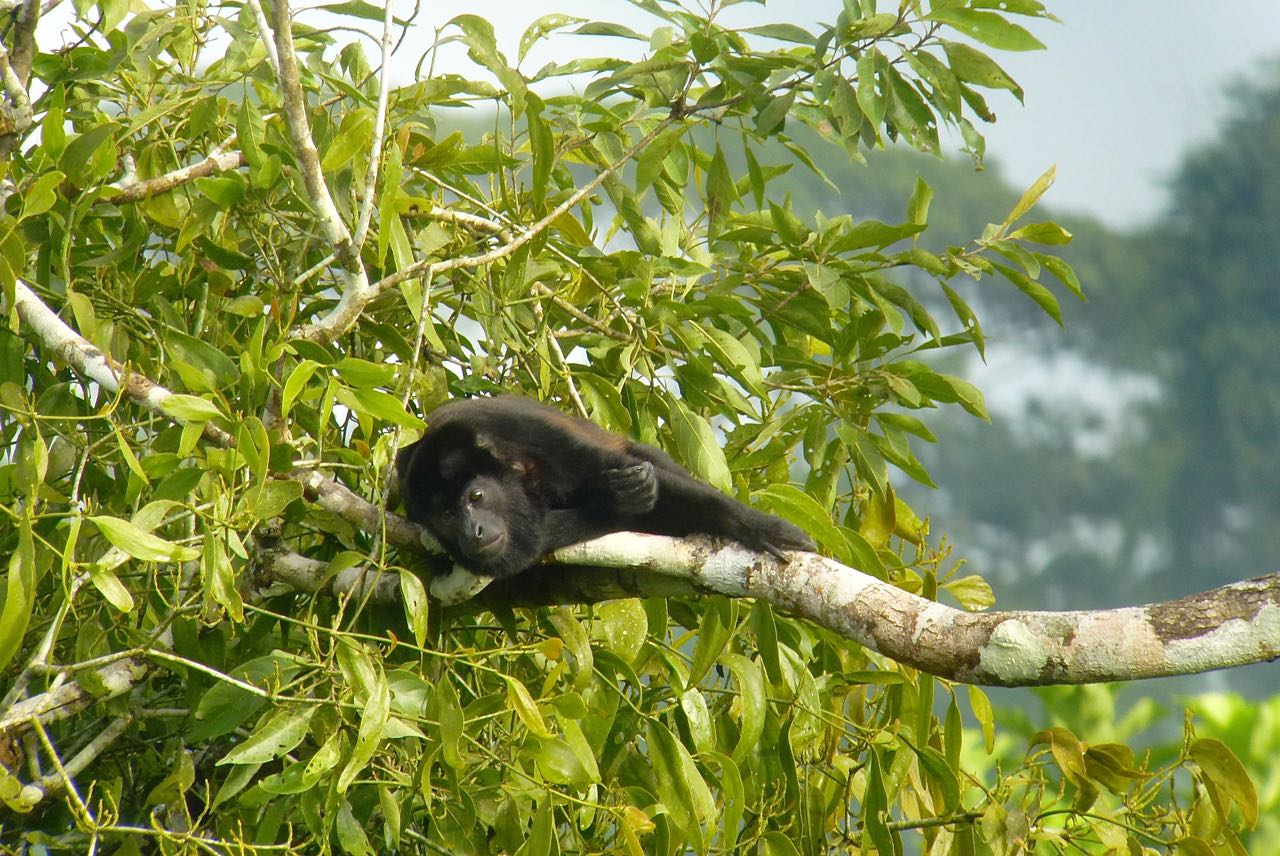 Mantled Howler - Photo by William Young
Mantled Howler - Photo by William YoungA lot of our time was spent trying to sort through swallows, swifts, and raptors. We had a distant look at Purple Martins who were not in breeding plumage. Mixed in were Bank Swallows, which are known here as Sand Martins. Barn and Northern Rough-wings were mixed in with a lot of Gray-breasted Martins. The swifts are much more difficult to identify, especially for someone who comes from a "one-swift" area. We saw a lot of Band-rumped Swifts, who have a band on the rump and have a light throat. The Short-tailed Swift, who is common, is completely dark below, except for the tail area. We saw Chimney Swifts, who have noticeably longer wings than the other two and have a light chin. The sky was full of vultures and one Anhinga, soaring like a giant plus-sign. Mixed in was an immature King Vulture, who had a dark head instead of a yellow one. We also saw a Hook-billed Kite, who has long, broad wings.
After more than two hours on the tower, we descended and went to the Discovery Center, where there are many hummingbird feeders. It was not as active as the patio of the Kaufmann House, but it had a lot of activity and about a half dozen species of hummers. The one we went to see was the Violet-bellied Hummingbird, a stunning bird with a deep purple belly and a green head. One of these hummers had a favorite perch in the sun which he kept returning to, and he glistened when the sun hit him. We saw the very big Long-billed Hermit, who is brownish, and the much smaller Stripe-throated Hermit, who used to be called the Little Hermit. The Stripe-throated Hermit was frequently driven away from feeders by the Blue-chested Hummingbirds. Near the patio, we saw a Black-headed Tody-Flycatcher, who has a white throat that distinguishes it from the similar Common Tody-Flycatcher. Before we left, I bought a tee-shirt that has a Streak-chested Antpitta on it — I must not be the only person who is enchanted by this species.
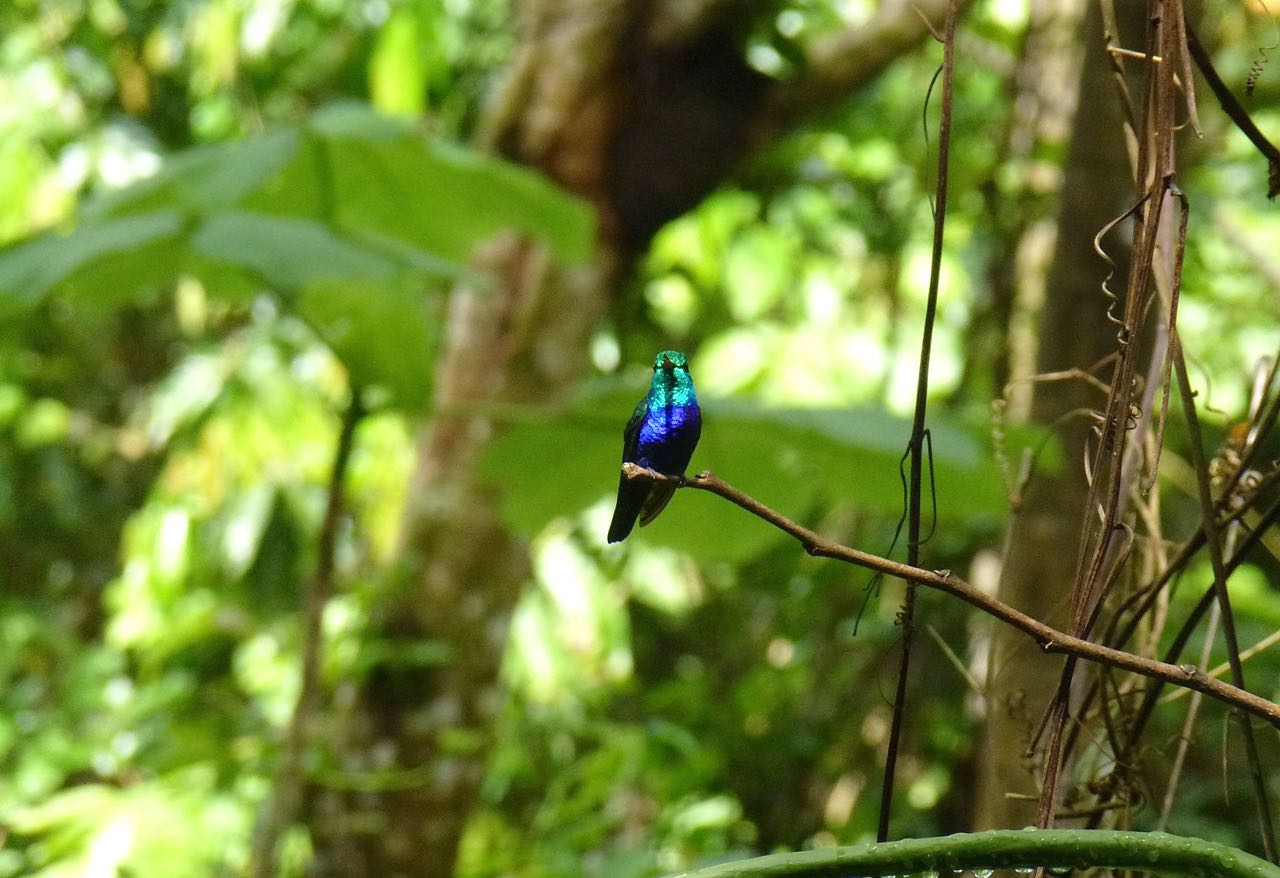 Violet-bellied Hummingbird - Photo by William Young
Violet-bellied Hummingbird - Photo by William YoungWe then went to a wetlands area. All of these places are within a short walk of the parking area, which makes this facility a treasure for bird diversity. Right after we arrived, an Osprey flew across. An Eastern Kingbird flew in to get a drink on the fly. Looking over the water, we saw a pile of brush covered with Black-bellied Whistling-Ducks. A young Snail Kite flew down to join them, while another Snail Kite flew low on the right. We could see the white rump band on both, and the young one was brown rather than slaty-gray. Some of the ducks were sleeping, while the young kite was preening. I saw a Lesser Kiskadee in the same scope field with the kite and a duck. A lot of other Lesser Kiskadees were around, and one was beating the stuffings out of a dragonfly. It eventually dropped the insect when another kiskadee came. A couple of Common Gallinules sometimes vocalized. There were some Wattled Jacanas, including a young one who was brown-and-white instead of black.
On the way back toward the vehicle, we saw a displaying area for male White-shouldered Tanagers. One female sat quietly about five feet from us while about six males tried to win her favors. Unlike many leks which tend to be relatively peaceful (albeit active) places, these tanagers were acting aggressively toward each other. They danced on branches, showed their bright white wing patches (which on a resting bird are partly hidden), and sometimes attacked each other in the air, going talon-to-talon like a couple of raptors. I was not aware that tanagers behaved in such a manner, and apparently, most tanager species do not. We saw a Black Hawk-Eagle soaring high in the sky. It has broad wings and a long tail. All of a sudden, it went into a dive and must have traveled a thousand feet straight down. We had an outstanding view of a Green Shrike-Vireo in the scope, and I saw much more detail on the bird than I had seen a few days ago.
We arrived back at Canopy Tower just as lunch was about to be served. After we ate, Martin and I were about to leave the table when I noticed some movement to my left. The three-toed sloth, who had been absent for the last couple of day, was not only back, but moving around. Martin and I shot video footage of him for about a half an hour. The sloth ate leaves, and he spent a lot of time scratching himself. Sloth fur contains a lot of vermin. He climbed and was about as active as one can expect a sloth to be.
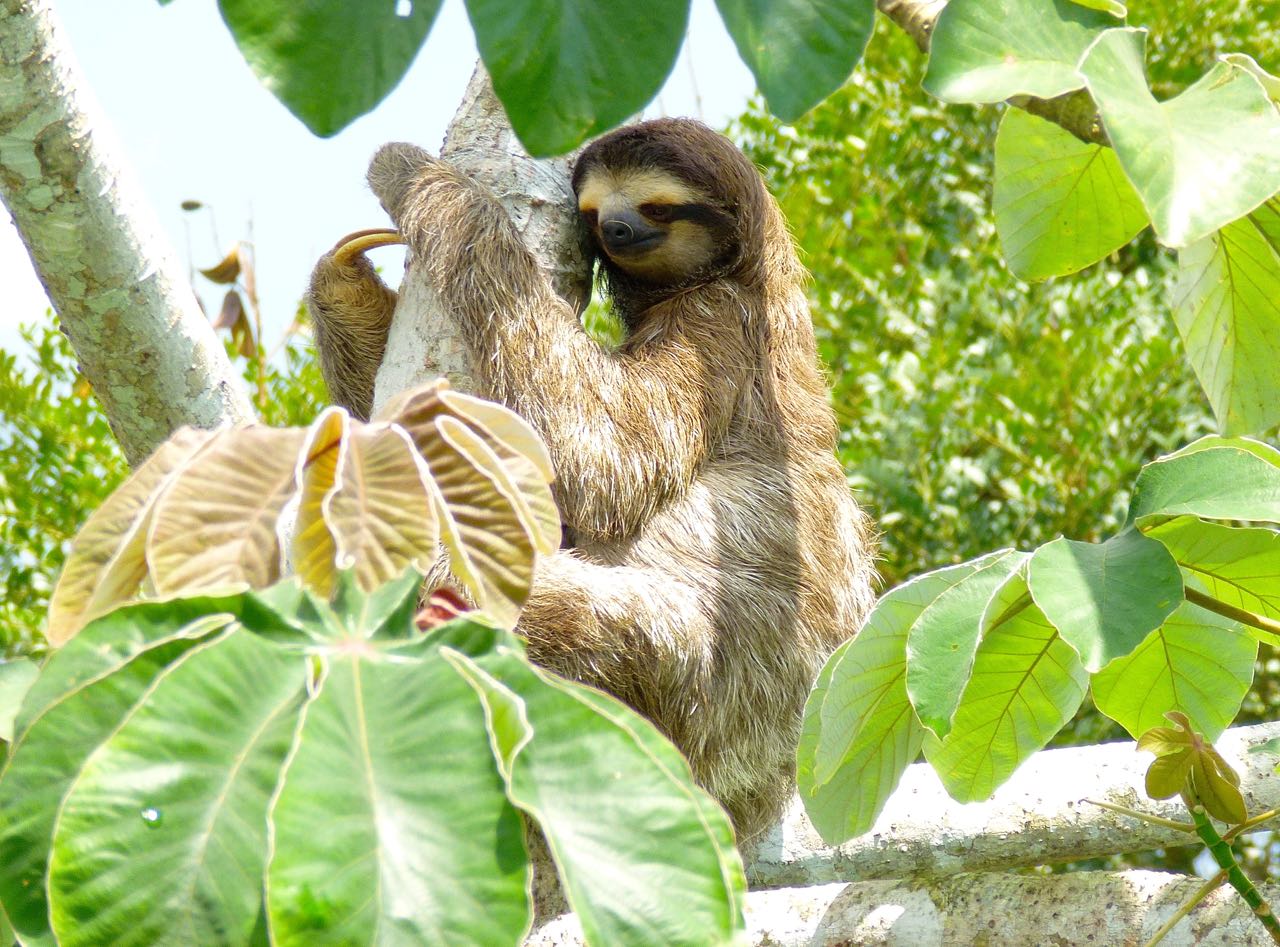 Brown-throated Three-toed Sloth - Photo by William Young
Brown-throated Three-toed Sloth - Photo by William YoungIn the afternoon, we went to the Summit Zoo, not far from Canopy Tower. Near the entrance are a lot of Little Tent-making Bats. They are small, and a number of them formed a chain underneath the leaves of a palm plant. The zoo is flycatcher heaven. We saw a Panama Flycatcher, which is a Myiarchus flycatcher, with more gray and less chestnut than the Great Crested. We saw a Yellow-Olive Flycatcher, who is similar to the Yellow-margined. The Yellow-Olive has a pale iris, while the Yellow-margined has a dark eye. There were many Rusty-margined Flycatchers, who are like the Social with a darker face. We saw a Yellow-bellied Elaenia, Great Kiskadee, Boat-billed Flycatcher, and Streaked Flycatcher. I also finally saw a Yellow-crowned Tyrannulet, which looks a little like a Golden-crowned Kinglet.
One of the best birds of the visit was an American Pygmy-Kingfisher, perched on the railing of a footbridge. It is rufous below, with a white vent. I had a scope view of a female Summer Tanager, with her pale bill. We also scoped a Chestnut-headed Oropendola and a Black-chested Jay. At one point, we saw about five different species of birds in the same tree, but instead of foraging, they were standing near each other. The group included Palm and Blue-Gray Tanagers, Thick-billed Euphonias, and others. There might have been a snake nearby.
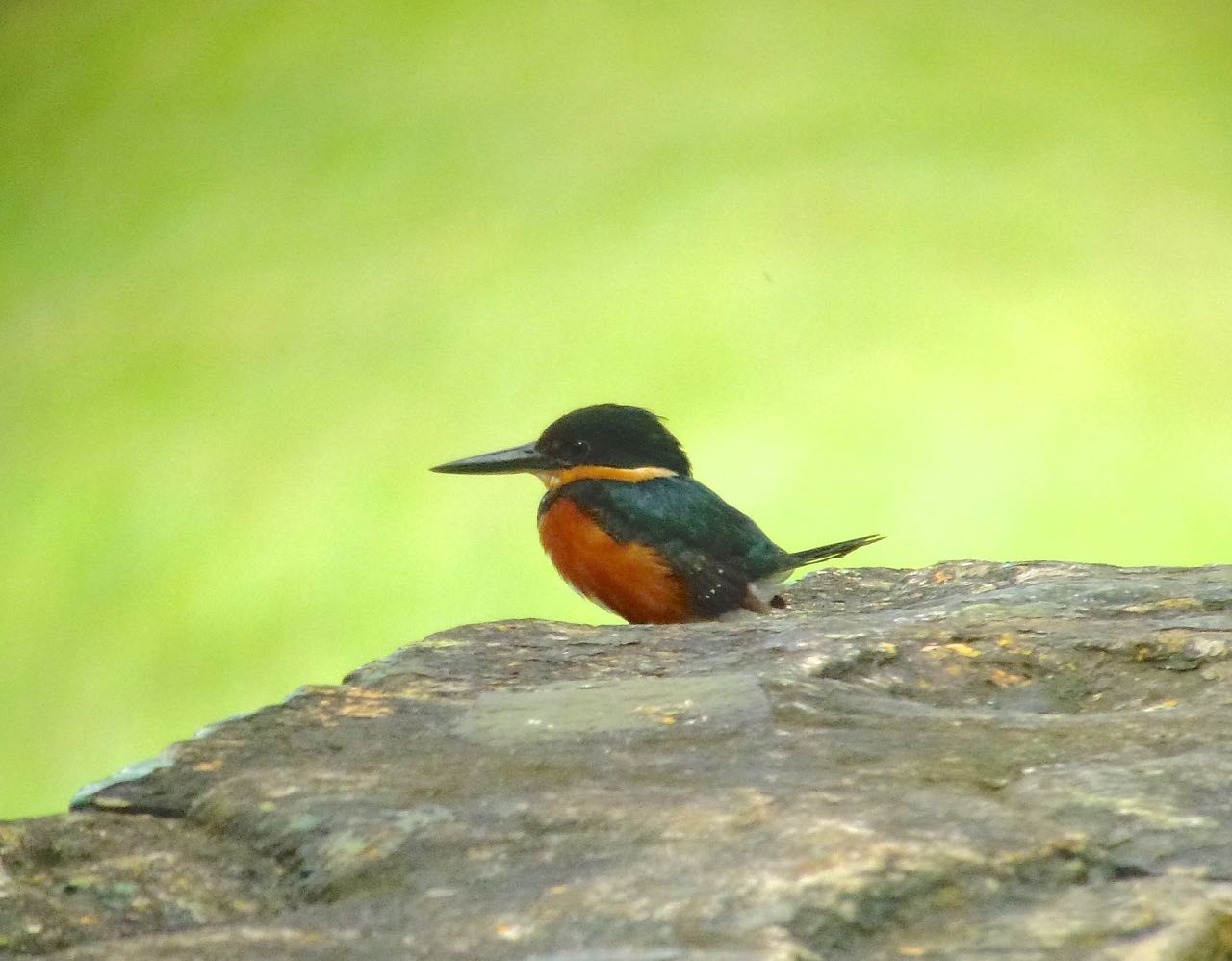 American Pygmy-Kingfisher - Photo by William Young
American Pygmy-Kingfisher - Photo by William YoungRegarding migrants and other wildlife, I saw four species of warblers today — Yellow, Canada, Chestnut-sided, and Northern Waterthrush. I saw a species of cattleheart butterfly, the enormous caterpillar of a Giant Swallowtail, a Gulf Coast Toad, and a Variegated Squirrel. We also saw a group of White-nosed Coatis on Semaphore Hill Road. They are related to raccoons and have long, ringed tails. Their faces look a bit like a bear's.
October 13
This morning, when I woke up, I was the only guest at Canopy Tower. Alexis and Martin had left at 5:30 to go to Cerro Azul, and a staff person was present to prepare breakfast. I went to the observation deck, and I watched the sunrise. It was clear around the deck, but the canal and the city in the distance were covered in fog. Mantled Howlers howled in the background. I heard parrots and pewees calling, and toucans were croaking. I heard the fast, three-note call of the Green Shrike-Vireo, and I saw two of them in the top of a tree. I heard the slower and more deliberate three-note call of the Black-faced Antthrush, whom I still have not seen. Band-rumped Swifts flew over. As the sun provided more light, I saw a male Summer Tanager in breeding plumage. There were Baltimore Orioles, including an adult male in shining plumage and an adult female. A lot of Red-eyed Vireos foraged in the trees, along with a female Yellow Warbler and a female Blackburnian Warbler. Mixed in with these migrant birds were residents such as the Golden-hooded Tanager, Blue Dacnis, Green Honeycreeper, and Common Tody-Flycatcher. I took a close look at the flycatcher to see the yellow throat, which distinguishes it from the Black-headed Tody Flycatcher I saw yesterday; they are tiny birds. The only new bird I saw was a Common Nighthawk flying by. The white on the wings looked pretty far from the tip, One never knows what will fly by the Tower.
I was soon joined by a young woman named Alva. She is a hawk counter, but since it was too early in the morning for much hawk action, she watched some of the songbirds with me. I had my breakfast, and then instead of waiting until 9 to leave for Canopy Lodge, we left a bit after 8. We drove northwest toward the highlands, crossing the Centennial Bridge over the canal — I had seen it many times from the Tower observation deck. At one point, the driver pointed out the Pacific Ocean. We passed two boys on the road, each holding a stick with two parakeets on it. I later asked one of the guides about this, and he said the boys capture birds just out of the nest and attach them to a stick with fine thread.
After a two-hour drive, we arrived in El Valle de Antón, also known as Crater Valley, which is the location of Canopy Lodge. It is in the crater of a long dormant volcano that last erupted five million years ago. The area around the lodge is filled with flowers, streams, and forests. The temperature is noticeably cooler. The rooms at the Lodge are more comfortable than the ones at the Tower. The Lodge was built from scratch for tourists, while the Tower is a retrofitted military facility.
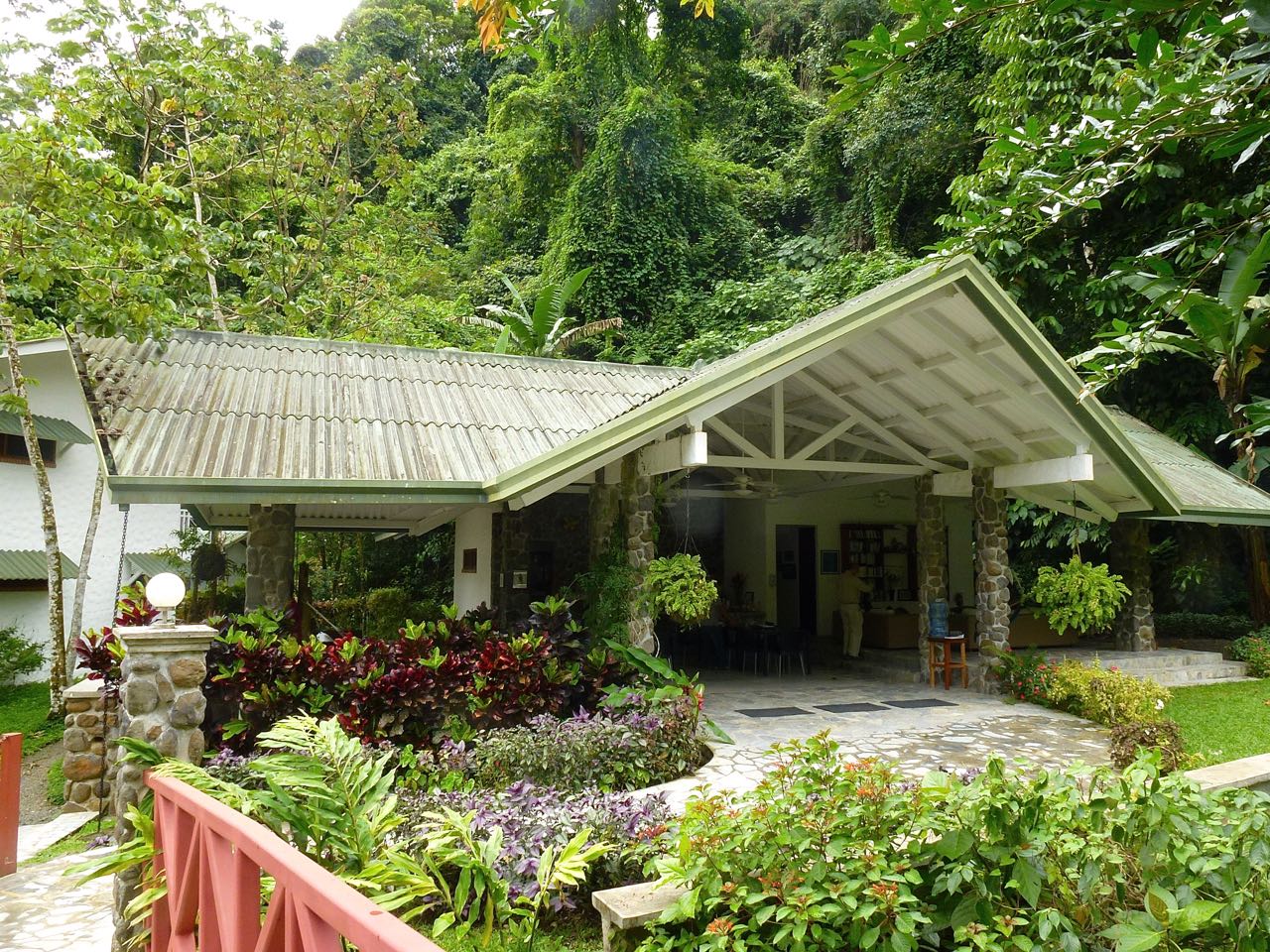 Canopy Lodge - Photo by William Young
Canopy Lodge - Photo by William YoungThe first hummingbird I saw was a Long-billed Starthroat, the same species we worked so hard to find when we were in Cerro Azul. The other common hummers around here are the Rufous-tailed and Snowy-bellied. Canopy Tower does not have feeding tables, but the Lodge has some. The most common visitors are Thick-billed Euphonias, Bananaquits, and Blue-Gray Tanagers. At the feeders, the only new species for the trip was a Rufous-capped Warbler, who is thin for a warbler and cocks its tail like a wren. I saw Crimson-backed and Flame-rumped Tanagers.
I had a couple of hours to kill after lunch, and so I asked my guide Eliecer to take me to the market in El Valle. There were a lot of stands, and I bought some mola items. Mola is a way of using appliqué on cloth, and it is a specialty of the Kuna Indians in Panama. There is a mola pillow on the bed in my room in the Lodge. If you try to walk away from some of the shops, the people there will haggle to try to get you to buy something. When we got back, Eliecer asked if I wanted to see a pair of Mottled Owls. They were roosting in a tree next to some of the cottages. These owls are mid-sized, have vertical streaks on their front, and have no ear tufts.
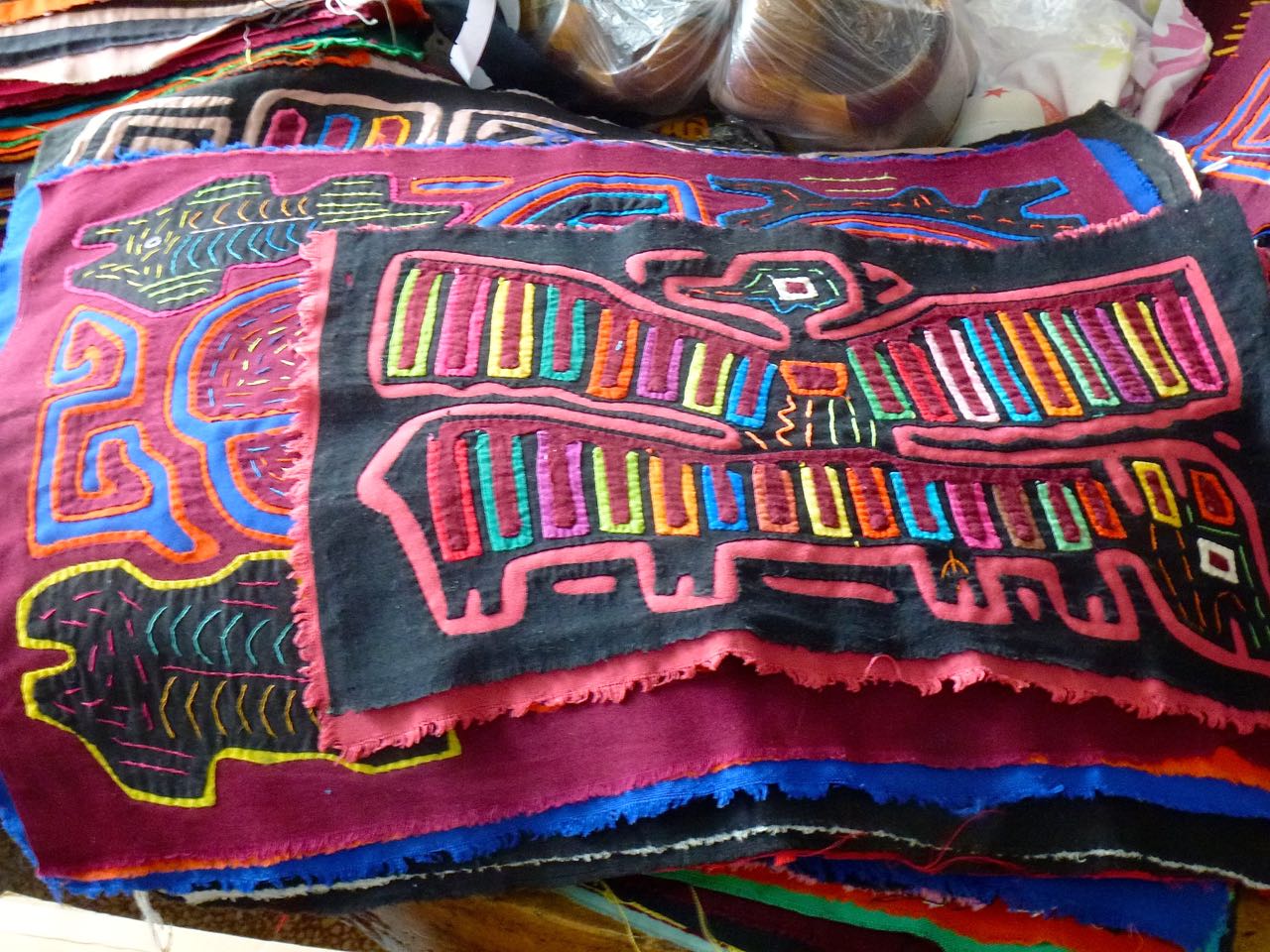 Molas - Photo by William Young
Molas - Photo by William YoungAt three o'clock, Eliecer, Tony, and I went to La Mesa Road, about fifteen minutes from the Lodge. The weather had worsened, and it began to rain. We drove past chicken farms and stopped in an area with rice fields. Some of the fields were covered with Southern Lapwings — too many to count — looking for insects. Along the way, we saw fruiting trees with a lot of birds. A new bird for the trip was the Silver-throated Tanager, who is dull-yellow, with a streaked back and a light throat. In the same trees, I saw a Bay-headed Tanager.
It began to rain hard just as we went into the rainforest. The normally dark conditions became even darker, but we were not getting all that wet. Most of the rain was hitting leaves. Still, it was difficult to bird, so we decided to call it quits. Before we did, I added a few new species. I saw an Orange-billed Nightingale-Thrush, who is brown on the back, with red legs, a red bill, and a red orbital ring. It looks much less robust than an American Robin. We had a quick look at a Ruddy Quail-Dove. We could not see the marks on the face. There was a Plain Antvireo, who as the name suggests, is plain-looking. I also saw a Western Pygmy Squirrel, who is small, brown, and has a tail that is not bushy. We saw impatiens flowers as well as blue hydrangeas. There were a lot of ant swarms. Some involved leafcutter ants, while others were army ants. A huge swarm of army ants was on one of the roads, but we did not see any birds following the swarm.
As I was returning to my room, I checked on the Mottled Owls, and they appeared to be a little more active than they had been previously. I later heard them call when I was in my room.
October 14
I woke up this morning a little before five and could hear a Mottled Owl calling. The call sounds like a hoarse HOO note being exhaled twice, and the vocalizations came every 30 to 60 seconds. By the time I got up, a Bay Wren was singing loudly. Before we left, our guide Eliecer scoped a Spot-crowned Barbet in a tree near the patio. I also saw some Striped Basilisk lizards on the rocks in the water.
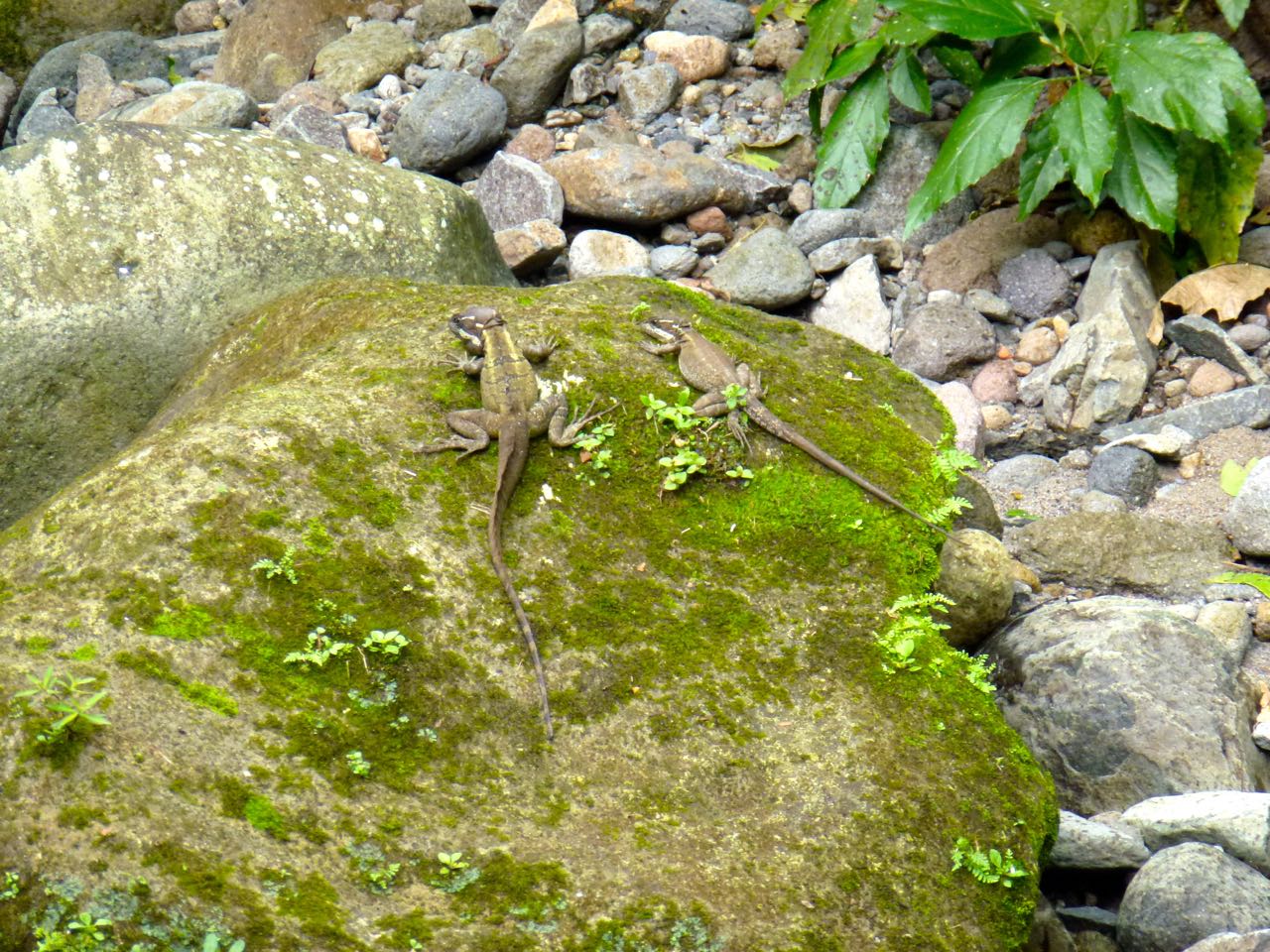 Striped Basilisks - Photo by William Young
Striped Basilisks - Photo by William YoungOur group of me, Eliecer, and three other people went to Rio Indio and Jordanal on the Caribbean slope on a beautiful sunny morning. As we were driving, a Gray-necked Wood-Rail ran in front of our vehicle. We could hear the song of a Bright-rumped Attila, which ascends to a climax. We heard a Buff-rumped Warbler, who sounds like a Northern Cardinal and forages along rocks in streams like a waterthrush. We stopped to look at Blue-headed Parrots in the top of a tree. We saw a pair of Plain Wrens, who do not seem more plain than a lot of other wrens. The House Wrens here sing a more musical song than the ones in the north. We heard a Little Tinamou calling from far away.
I finally had a good look at a Golden-winged Warbler. A female was foraging in a tree, and she came popped into the open. Other migrants we saw included a Rose-breasted Grosbeak, a Baltimore Oriole, Tennessee, Chestnut-sided, and Blackburnian Warblers, Northern Waterthrushes, a Summer Tanager, Red-eyed Vireos, and a lot more Eastern Wood-Pewees. We saw two Tropical Pewees, who look similar to the Eastern Wood-Pewee. Just as where I live, there are feeding flocks, but the ones in Panama have a remarkable diversity, and one finds them more frequently.
I saw a couple Scarlet-thighed Dacnises, who are small tanagers. They are blue on top and black underneath, and on one of them, I saw the scarlet thighs, which are often inconspicuous. The Tawny-capped Euphonia was a new bird for the trip and looked like a lot of other euphonias, but it has a tawny crown and a white vent. We scoped a female, and I could see her breathing. We later saw some males. We found a Streaked Saltator, who is smaller than the other saltators. It is white underneath and has fine streaks on its breast. We saw a lot of Buff-throated Saltators. We found a tree with a lot of hummingbirds feeding on white flowers. Among them was a male Green Thorntail, and I saw the thorn-like tail.
I had a much closer look at a Black Hawk-Eagle. It is a big, broad-winged raptor. I saw some black-and-white stripes on the underwing. We later saw a couple of Roadside Hawks fly by as well as a perched one. They have a gray back, and in flight, show a lot of rufous under the wings. We saw a Barred Puffbird, who resembles the White-whiskered. It has a large bill and a pale eye. Two were close together. We saw Blue Ground-Dove, who is uniformly blue-gray, with spots on the wings and a plain breast. We saw a Brown-capped Tyrannulet, who appeared to have a grayish cap. We also saw a Paltry Tyrannulet. Alexander Skutch called them Mistletoe Flycatchers, because they pass mistletoe seeds through their system; when they eliminate them, they wipe the sticky seeds from their bottom onto leaves. The Australian Mistletoebird behaves in a similar manner, as do various other species around the world. We saw a Jet Antbird, but the light was not good enough for me to see the white dots on his wings. We knew it was a Jet Antbird because it was vocalizing.
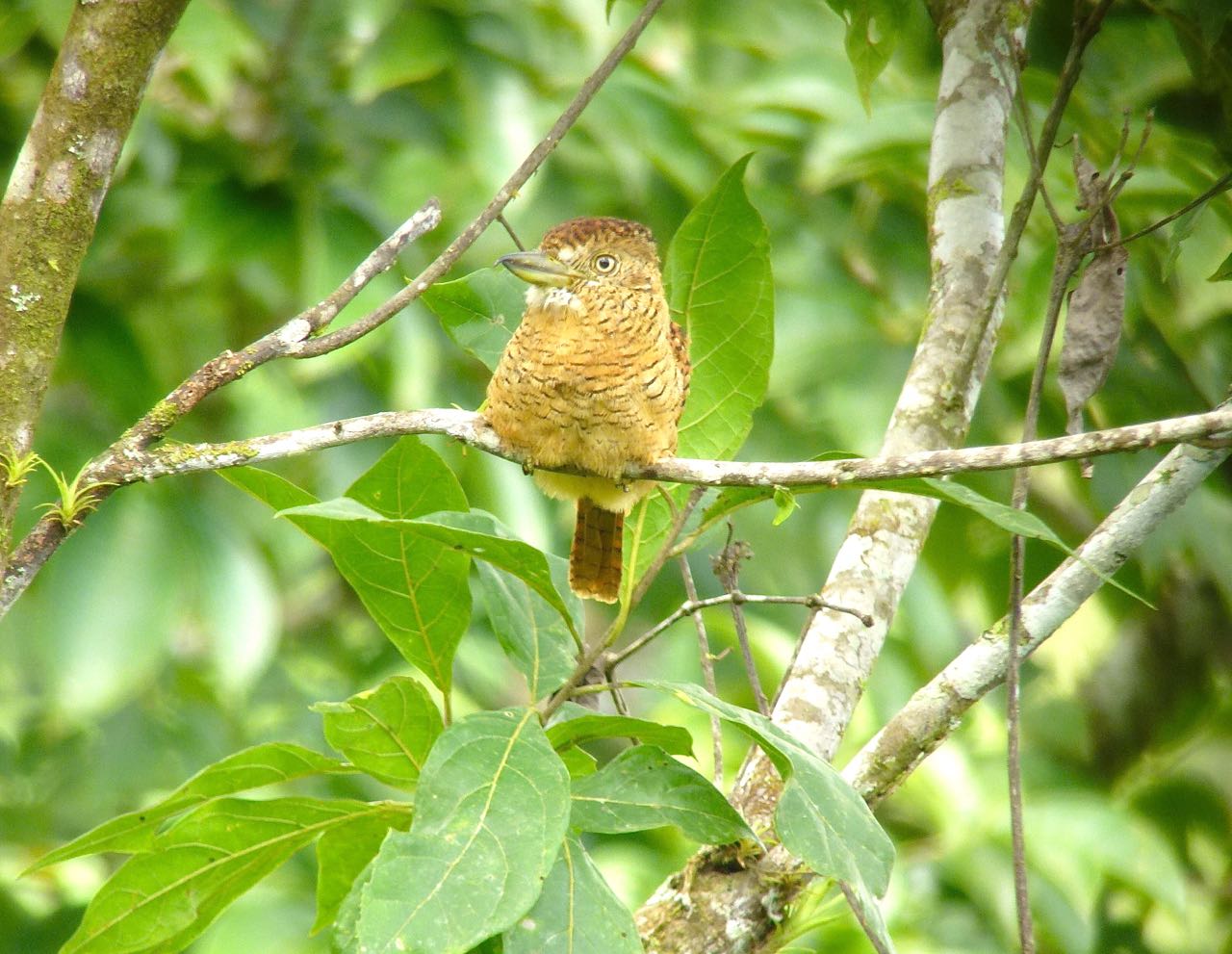 Barred Puffbird - Photo by William Young
Barred Puffbird - Photo by William YoungThe Slate-colored Seedeater looks like a junco, with a yellow bill that looks larger than a grosbeak's. I had a nice look at a Wedge-billed Woodcreeper, who is one of the easiest woodcreepers to identify because it is so small and has a small bill. We saw one of the long hanging nests of the Crested Oropendolas. We saw a tiny glass frog, who was less than an inch long. I saw a Banded Peacock butterfly. On some of the paths, we saw long lines of leafcutter ants carrying vegetation.
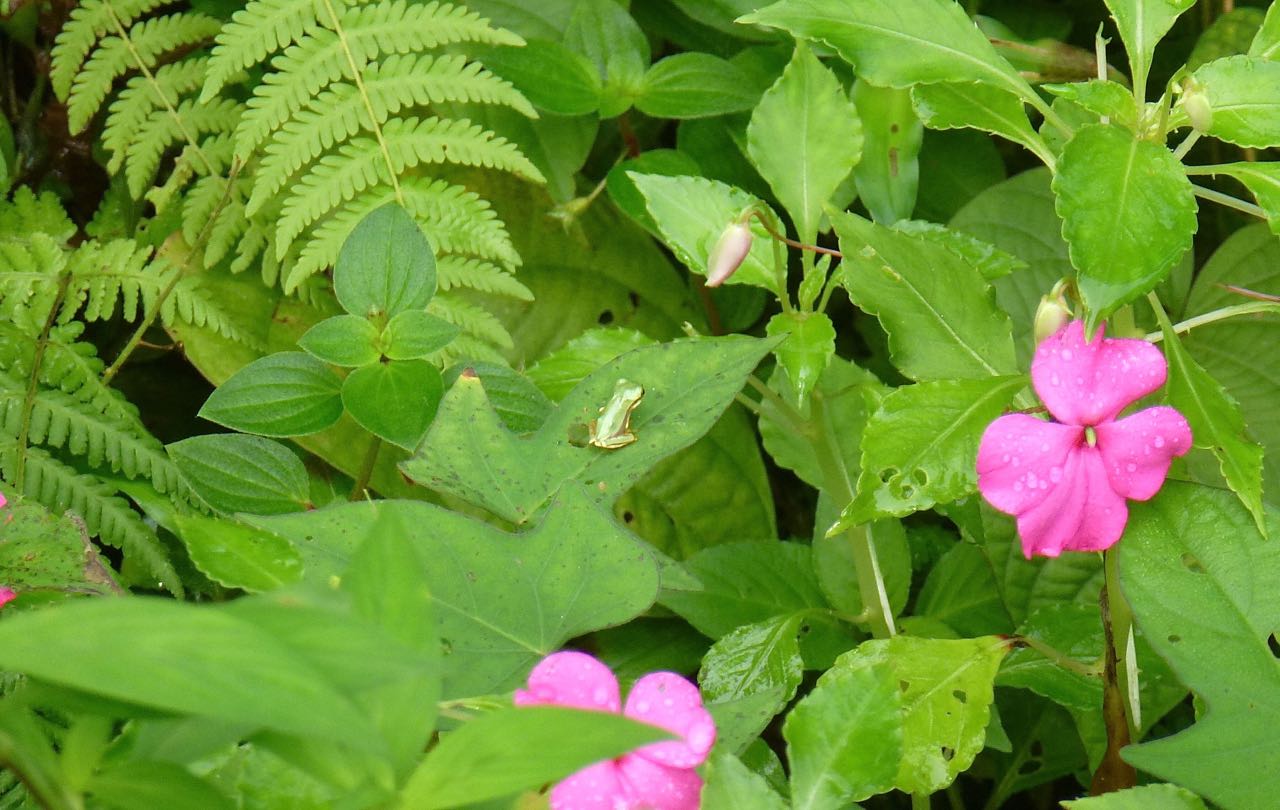 Glass Frog - Photo by William Young
Glass Frog - Photo by William Young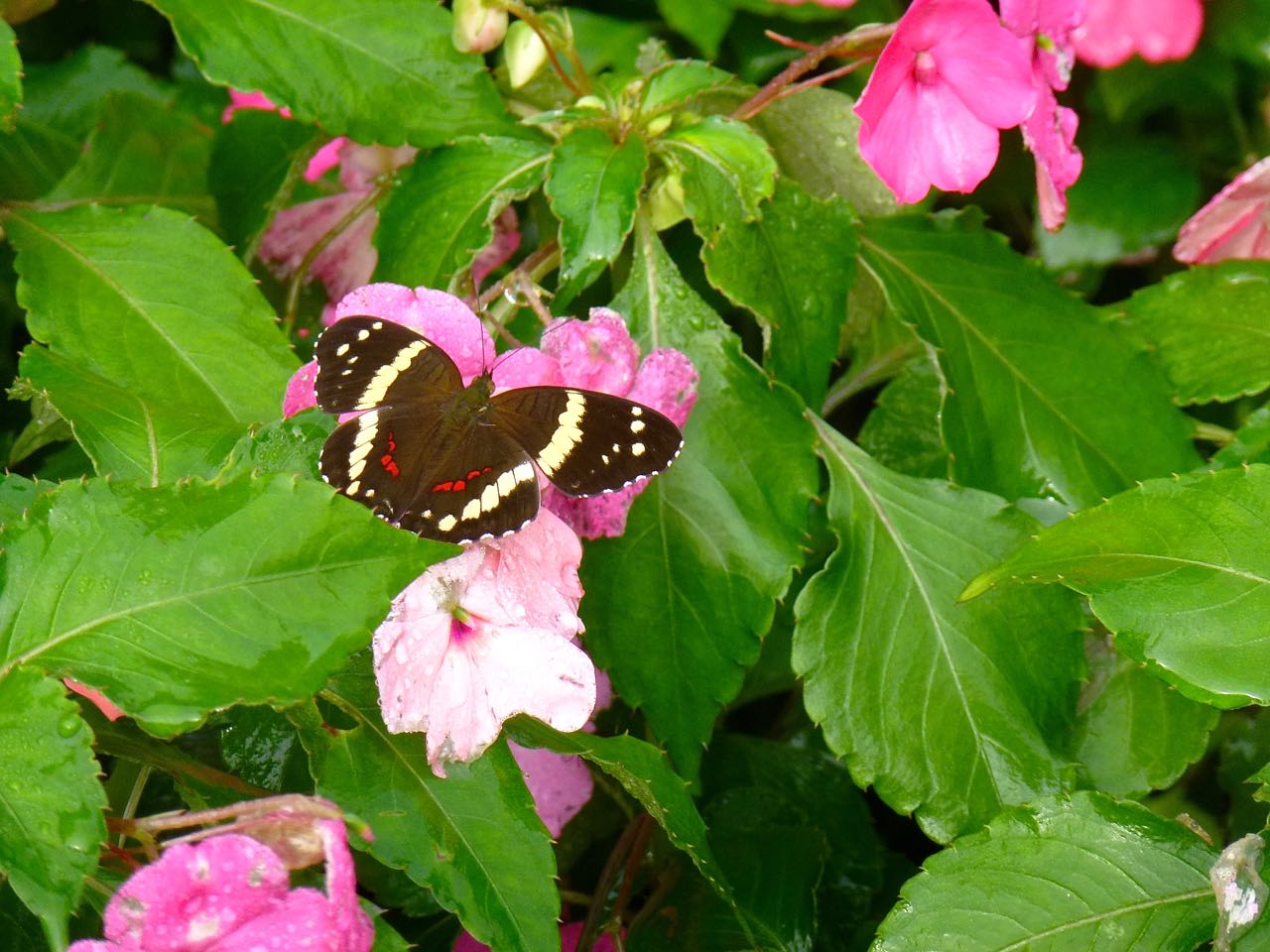 Banded Peacock - Photo by William Young
Banded Peacock - Photo by William Young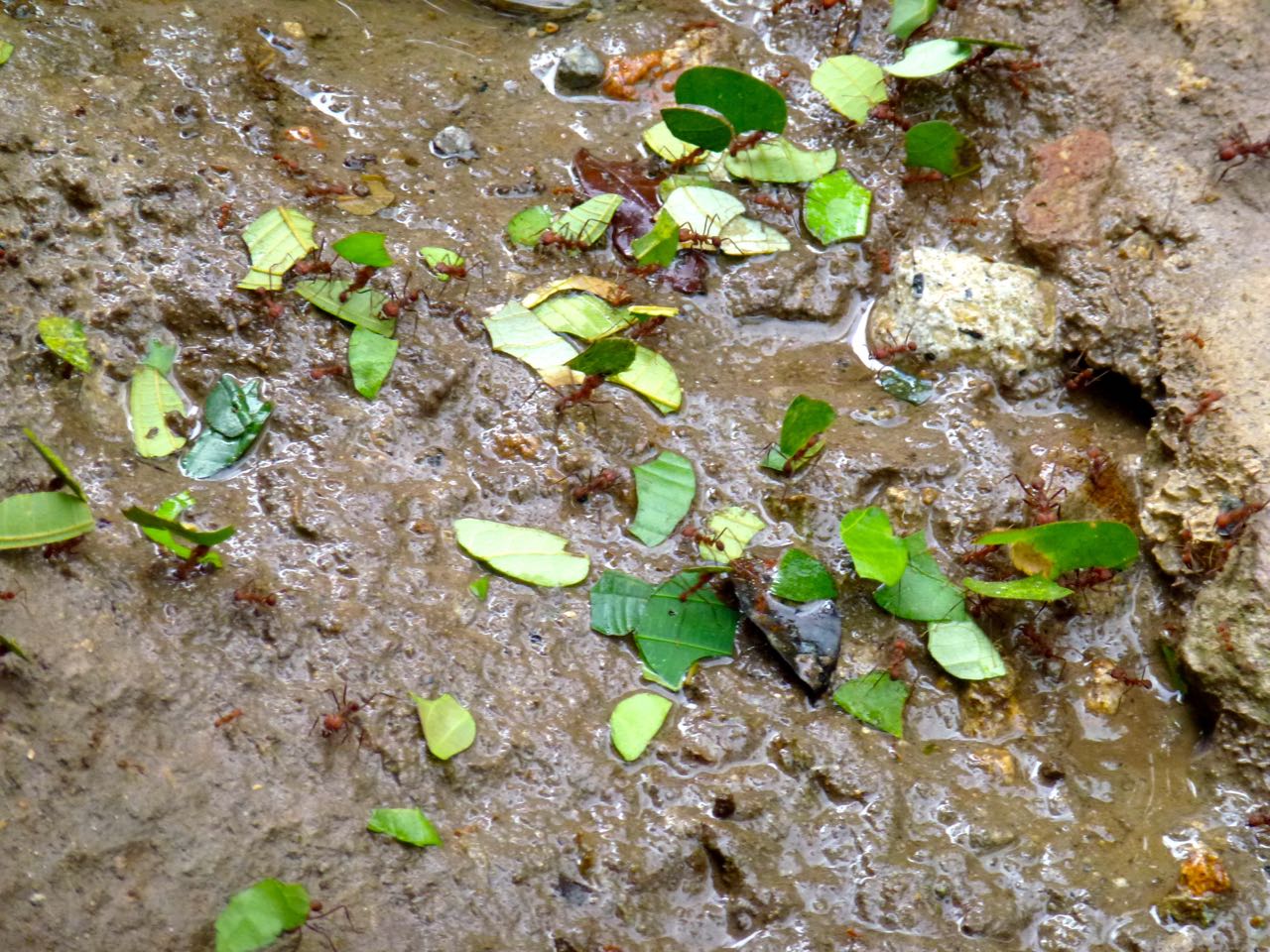 Leafcutter Ants - Photo by William Young
Leafcutter Ants - Photo by William YoungA little after noon, the skies opened up. Today, we pretty much had the gamut of weather conditions, including sunny, overcast, drizzle, rain, hard rain, really hard rain, and really really hard rain. The roads are not good in dry weather, which is why we were in four-wheel-drive vehicles. When you throw in heavy rains causing mud and, in places, knee deep water, getting around was an adventure. Likewise, walking on some paths was treacherous. But the birds were great. There is no way I could have done most of this trip without experienced guides.
We had lunch in a shelter by a fast running stream during the deluge. In the shelter, there was a bat roosting inside the roof which Eliecer tentatively identified as a Least Sac-winged Bat. When the rains became so bad that we had to seek shelter, Eliecer stopped at the house of a family he knew. The place had chickens (and little chicks), dogs, cats, and small children. There was also a feeding table where Eliecer bananas. Among the birds who came to the table were Flame-rumped, Blue-Gray, Crimson-backed, and White-lined Tanagers, the latter being a new bird for me on the trip. The male is all black, with a little white line showing on the top of the wing; more white shows when the bird flies. The female is a uniform rufous color. There were Thick-billed and Tawny-capped Euphonias, Green and Red-legged Honeycreepers, a Buff-throated Saltator, a Black-striped Sparrow, and a Tennessee Warbler. At one point, the table was cleared when a Rufous Motmot came to eat.
 Least Sac-winged Bat - Photo by William Young
Least Sac-winged Bat - Photo by William Young Crimson-backed Tanager - Photo by William Young
Crimson-backed Tanager - Photo by William Young
October 15
The Mottled Owl began his HOO HOO call this morning at about 5:40. It sounded as if one was right near my room, so I slipped on some clothes and went outside. I heard both owls calling, and one call was lower than the other. I went to the spot where the sound of the Mottled Owls was coming from, and one of the owls popped onto a branch about 12 feet in front of me. It then went up to a higher branch, and the other owl landed just above and to the right.
Today, Eliecer led a walk on the Las Minas Trail with me and three other people. The road follows the ridge line, with beautiful views of forested mountains, with some grassland habitat. At one point, we saw the Pacific Ocean. At the beginning of the trail, we saw Bay-headed Tanagers in good light. A much more difficult bird to see was the Chestnut-capped Brush-Finch, who darts around quickly and skulks in the underbrush. I had one good look at the chestnut cap, black face, and bright white throat. I also saw a pair of Mourning Warblers, and had a nice view of the male, who was chipping loudly. Considering I am originally from the Philadelphia area, I was glad to see both the Mourning Warbler, whose species name is philadelphia, and later a Chestnut-sided Warbler, whose species name is pensylvanica.
I saw a Spotted Woodcreeper, who has tan spots on its brown belly. It has a buffy eyering, and we were close enough to observe its feet while it crept up the tree. In the same area on the forest floor, we looked down on a Scaly-breasted Wren, who looked like a dark little bird from above. We had a scope view of a Spot-crowned Antvireo, and we saw the tiny white dots on its black crown. I had a closer look at a Paltry Tyrannulet in good light. I saw my first Yellow-bellied Seedeater of the trip (a male), and we had two good looks at a Wedge-tailed Brush-Finch. The finch sang from a perch on grass, and his gape was yellow. He has a large yellow bill, a sparrow-like back, a plain white breast, and an eyeline. We later saw a much closer one and could see the unusually long tail. We had a nice look at a Black-striped Sparrow, who has a similar plumage design to a Worm-eating Warbler.
We saw a soaring Ornate Hawk-Eagle; it has broad wings and is rufous underneath. We saw a perched Bat Falcon and a flying American Kestrel. We saw an Orange-bellied Trogon, who looks like an Elegant Trogon; it is not found east of the canal. There were young Silver-throated Tanagers, who are mostly green. I saw my first Common Bush-Tanager, a small tanager with a dark cap, green back, lemony breast, and a small white spot behind the eye. A Plain Antvireo was preening, and I saw its eyering.
We saw a Pale-vented Thrush, who is in the same genus as the American Robin. It has one of my favorite scientific names: Turdus obsoletus. When we scoped one, I could see the cloaca on its white vent. We saw a female White-ruffed Manakin, but I still have not seen a male. This manakin sat on a branch until it got buzzed by a tiny Scale-crested Pygmy-Tyrant. We saw a Tufted Flycatcher, one of the few flycatchers who has a few different colors on its palate. It has a lovely tawny breast with a lemony belly. In the scope, I saw its folded crest. As for migrants, we saw a Swainson's Thrush, an Olive-sided Flycatcher, an Eastern Meadowlark, Cliff Swallows, Baltimore Orioles, and Scarlet and Summer Tanagers.
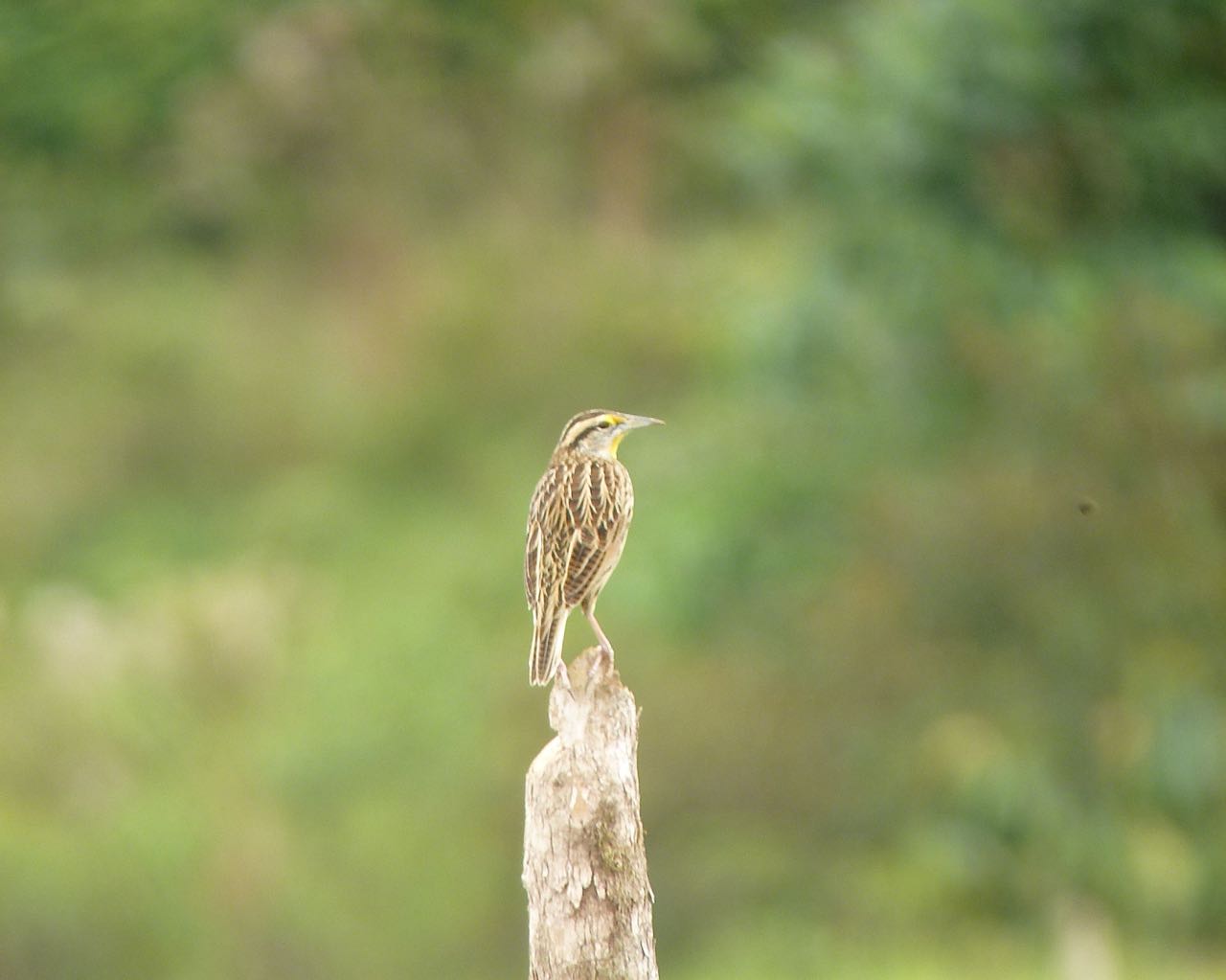 Eastern Meadowlark - Photo by William Young
Eastern Meadowlark - Photo by William YoungWe saw a pink banana plant. It has a lovely flower, and its fruits are little pink bananas that don't taste good enough for human consumption. We saw a satyr butterfly. A little later in the day, I saw an Aztec Ant nest high in a tree, resembling a round hornet nest. Eliecer said the ants live in the trees.
We got back to the Lodge around 12:30, when lunch is served. After I ate, I took a shower and had a one-hour massage, which felt good after 11 days of birding. When the massage was done, I got ready to go out on our 3 o'clock trip, but it was rained out. I was glad to take the afternoon off. When I go birding at home, I usually come home for lunch and do not go out again at 3. The days down here are so rich with experience that one occasionally needs some time to rest. We stayed around the Lodge and watched the feeders. One can identify the Rufous-capped Warblers by their silhouette because of the way they cock their tail. The Garden Emerald is a small hummingbird who is almost entirely green. A male Summer Tanager sat in a tree, and a Green Kingfisher perched by the stream. A Chestnut-headed Oropendola came to the feeders, as did Baltimore Orioles. I had an excellent look at a Bay Wren, who has more attractive plumage than most other wrens; I don’t know if this was the same individual whose song is so loud early in the morning outside my room. A female Red-crowned Ant-Tanager came to the feeders; she is brownish and has a small red crown on her head. An adult Buff-throated Saltator was feeding a begging youngster.
October 16
This morning, I heard the Mottled Owls again. I did not see them in the place they were yesterday. When I went to the dining area, I heard one calling nearby, and when I walked closer, one flew in front of me and behind the building. I went to the bridge where a Bay Wren was singing loudly. I waited a bit, and he popped up a few times.
After breakfast, Eliecer took me and two other people to a different area of La Mesa than we had visited previously. It was a bit down the road from the area where we birded yesterday. On the way over, we had a long look at a Gray-necked Wood-Rail walking in the grass by the side of the road. Eliecer found a Blue-throated Toucanet, who used to be called the Emerald Toucanet. This large green bird has a big bill with white at the base. A Bat Falcon flew by, flying like a bat. I saw two new tanagers for the trip. The Dusky-faced Tanager is dark like an Olive Tanager, but it has a Tawny crown and a black mask. It constantly gives harsh chip notes. These tanagers are usually heard before they are seen, We also saw a male Tawny-crested Tanager, who is jet-black, with a tawny crown. Red-crowned Ant-Tanagers were around, with the males looking like a large Hepatic Tanager. It is one of the larger and more robust tanager species.
We had good looks at two attractive wrens. The Rufous-breasted Wren has a black-and-white checkered throat and a rufous breast. The White-necked Wood-Wren has a checkered pattern on its face, a white breast, and a rich chestnut back. We heard the chink notes of a Rose-breasted Grosbeak and later saw one. The Sulphur-rumped Flycatcher has a yellow rump and dark wings and tail. We saw and heard quite a few Yellow-bellied Elaenias, flycatchers who have a one-note call. A Bicolored Antbird popped up on a stick a few feet from us before flying into the forest.
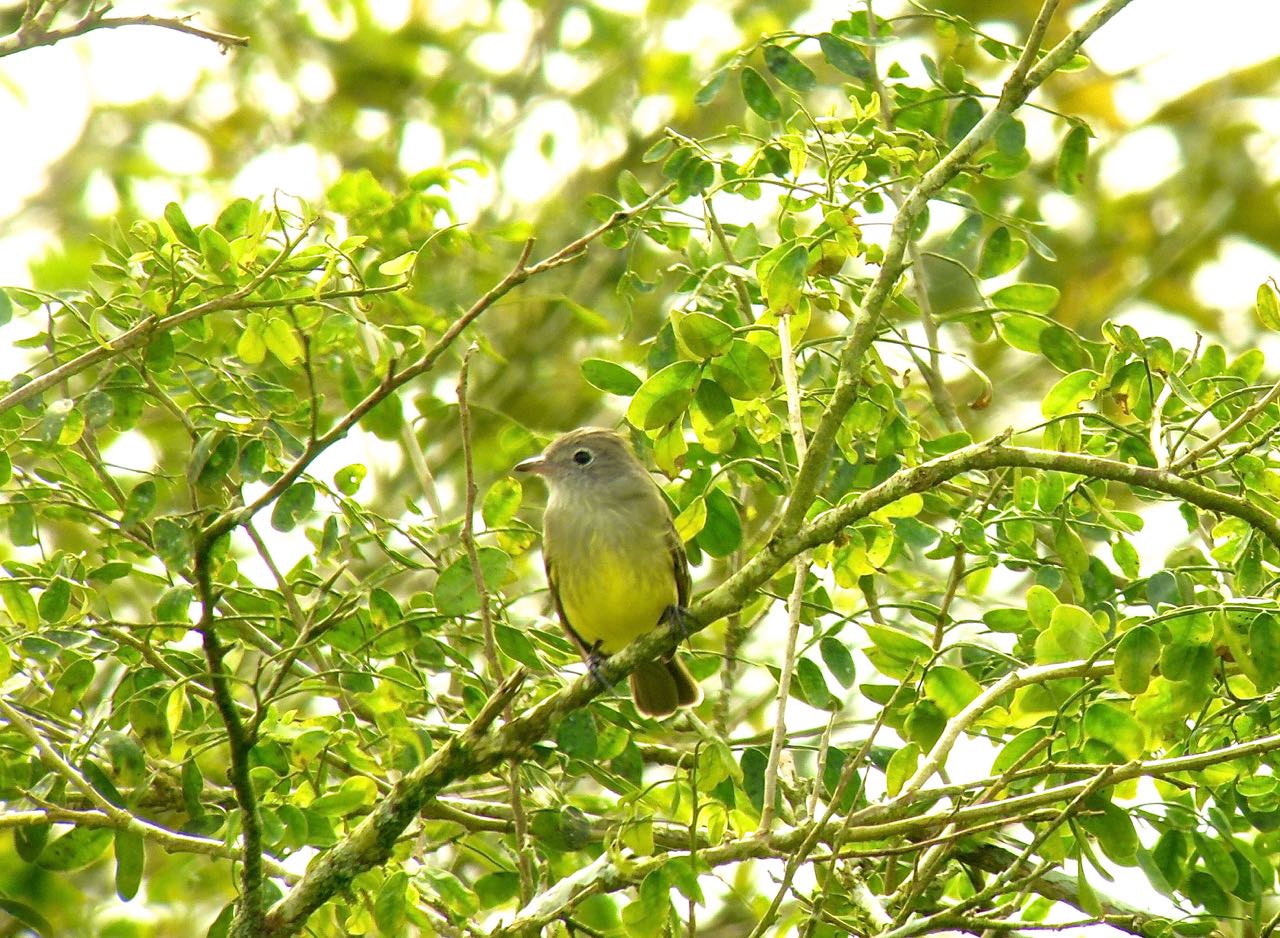 Yellow-bellied Elaenia - Photo by William Young
Yellow-bellied Elaenia - Photo by William YoungWe saw a Buff-throated Foliage Gleaner, who is dark brown above, light brown below, and has a buffy throat. It is an ovenbird, but it is not related to the warbler we call an Ovenbird. These ovenbirds are in the same family as woodcreepers. They are insect eaters who are confined to the Neotropics. They are all mostly brown birds and usually difficult to see. The only other ovenbird species I have seen on this trip is the Plain Xenops.
We returned to the Lodge before lunchtime. Martin had arrived from Canopy Tower and said that one day at the Metro Park, he saw about 100,000 Broad-winged Hawks flying over. After lunch, a few people wanted to go shopping in El Valle, so we stopped there before birding. I saw buses whose exterior was painted in a style that looked psychedelic; they looked even more psychedelic when lit up at night. In the background of this area was a mountain called the "Sleeping Indian", because the outline looks like a person lying down.
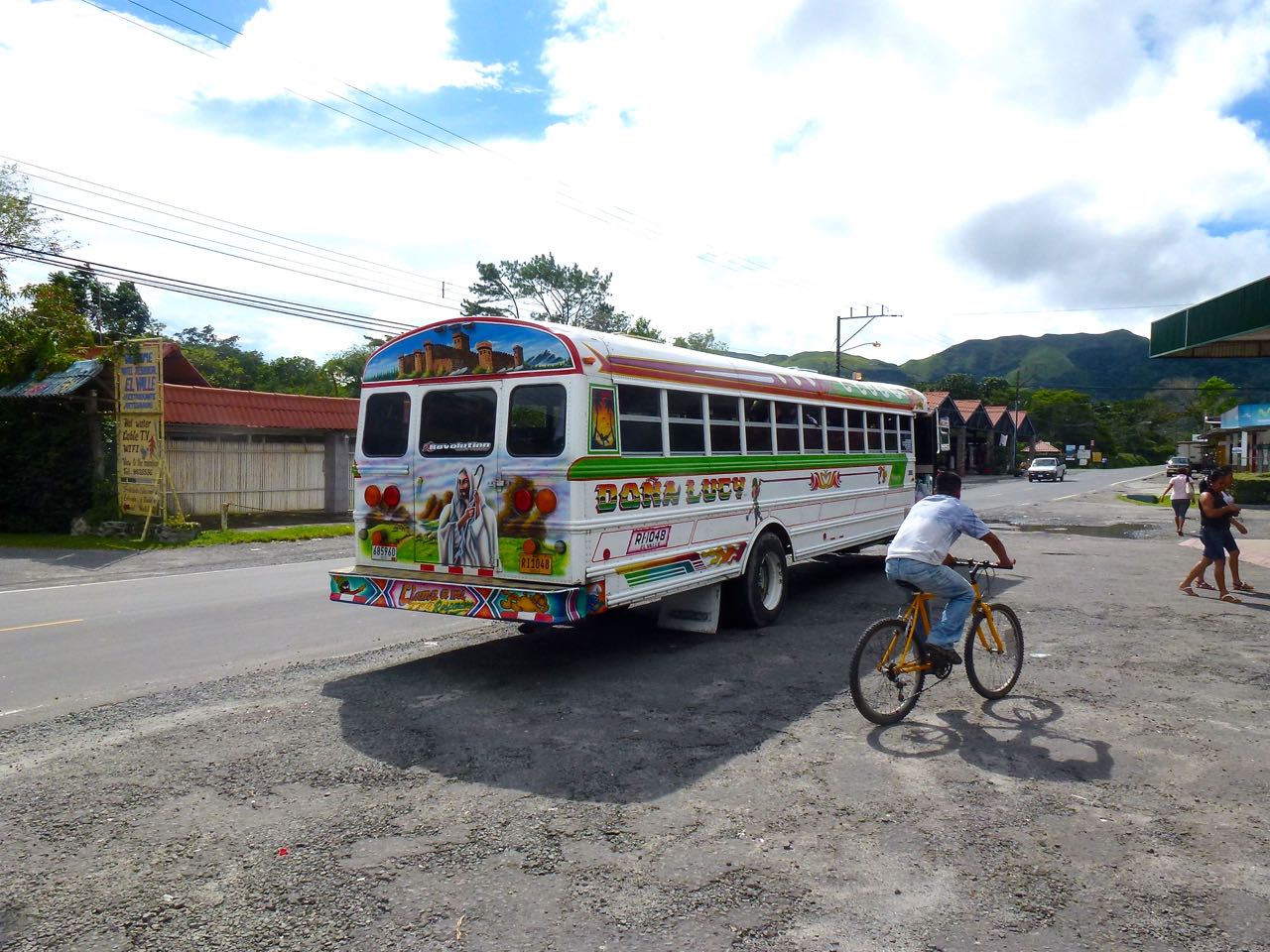 El Valle Bus - Photo by William Young
El Valle Bus - Photo by William Young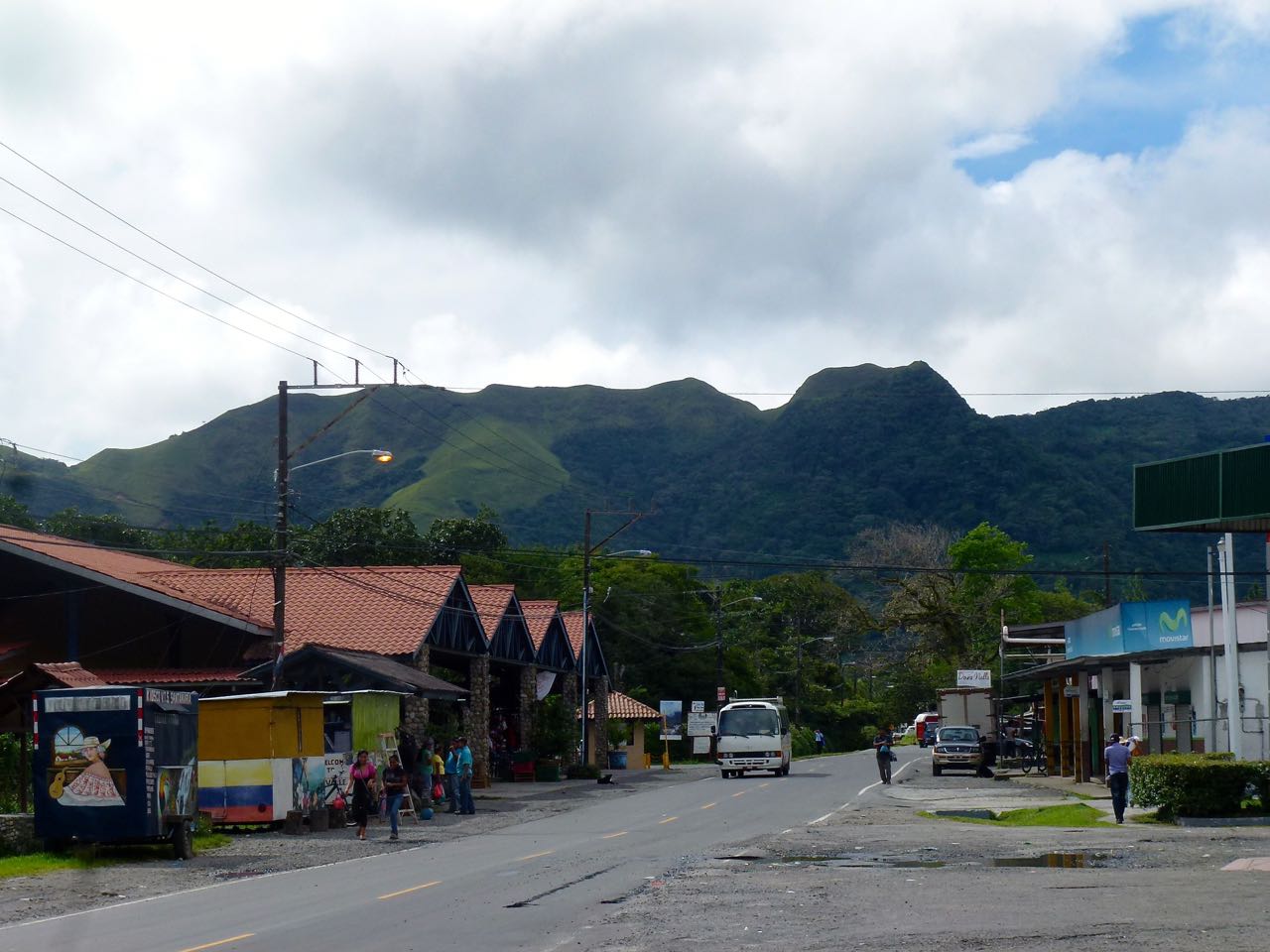 Sleeping Indian - Photo by William Young
Sleeping Indian - Photo by William YoungAfter shopping, we went to an area called Cariguana, which rhymes with "marijuana" and means "face of the iguana". We went on a street nicknamed Millionaire Road because it has a lot of big houses occupied by rich people. The roads in this area are well paved, and vehicles were driving faster than is typical in El Valle. Most of the roads in El Valle are not paved, and if you drove fast, you would damage your vehicle.
When we got out to bird, we saw a male Barred Antshrike, who has a pale eye. Martin must have brought his owl mojo with him, because within about three hours after lunch, we had seen three species of owls. Before we had left the Lodge, Eliecer located one of the Mottled Owls and had it in the scope. Later in the day as we walked down a path through the forest. I was behind Eliecer, and we saw a large owl with long, narrow wings fly ahead of us. It was a juvenile Spectacled Owl, the largest owl species in Panama. The adults have a brown head, with white crescents around the eyes. This bird still had some of its down feathers on its head — it looked as if it were wearing one of George Washington's wigs. We walked a little further into the woods, and just as it began to rain, Eliecer found a Tropical Screech-Owl. It was gray and sat primly and erect in a tree about 15 feet off the ground. We waited out the rain in the van and began to bird again. We heard an incredible racket made by Gray-headed Chachalacas. As we looked for a Rufous-and-white Wren, the skies became dark, so we decided to return to the lodge.
We had a good day for Neotropical migrants. We saw Tennessee, Blackburnian, Canada, Golden-winged, and Black-and-white Warblers, a Red-eyed Vireo, a Swainson’s Thrush, a Rose-breasted Grosbeak, a Summer Tanager, Barn Swallows, Eastern Wood-Pewees, Broad-winged Hawks, and an Osprey.
October 17
We had breakfast this morning at 5:30 and headed off for a day of birding in Juan Hombron, the beach at Santa Clara, and El Chiru. These areas have a different habitat than the area around the Lodge, featuring Pacific dry forest and wetlands by the Pacific Ocean. I went with our guide was Danilo, who is Eliecer's brother, and four other people. When we left, the weather was drizzly and misty. On the way to our destination, a peacock crossed the road in front of us, which turned out to be a good omen.
Juan Hombron provided one of the best mornings of birding I have ever had. When we arrived, the weather was bright and sunny. We started out seeing Southern Lapwings fly over; they have long wings. We saw a Roadside Hawk, appropriately perched by the roadside. It is a medium- sized hawk, with a gray back and rufous barring on the belly. It has a yellow cere, eyes, and legs. Its plumage is like a Cooper's, except that it has a gray throat. A lot of Groove-billed Anis were around, lacking the bulge in the upper mandible that the Smooth-billed has. Later, we came across a small group of Greater Anis, who look large by comparison. We saw a few Mouse-colored Tyrannulets, who did not look much more mouse-colored than a lot of other flycatchers. We saw a Lesser Elaenia, who compared to the Yellow-bellied Elaenia is smaller and has no crest. We had good looks at a pair of Barred Antshrikes.
One of the best birds of the morning was a male Lance-tailed Manakin. The male is black, with a red cap, turquoise back, and yellow legs. We were in an area that has Lesser Yellow-headed Vultures, who look like Turkey Vultures, but have yellow heads. We saw quite a few at relatively close range, because they often fly low. I saw one take off from the ground, allowing a good look at the head. There was a pair of Brown-throated Parakeets, who have yellow just below their eyes. We heard a Crested Bobwhite and saw one fly; the call sounds similar to the Northern Bobwhite. Many Sapphire-throated Hummingbirds were around. We had worked hard to find one at Fort San Lorenzo on my first full day of birding at Canopy Tower, but today, I saw a lot of them, including a couple in the scope.
Another good bird was an Aplomado Falcon. We saw one fly, and it landed on a branch next to its nest. It has plumage similar to a Bat Falcon, but it is 50 percent bigger and has a normal facial pattern for a falcon. It has reddish leggings. A lot of vultures were soaring, and once when we looked up, we saw an Osprey and a Wood Stork with them. The stork has a similar flight profile to an Anhinga. We later saw another stork flying, and it flew low and slowly, like a vulture. We saw an immature White Ibis flying, and later we saw an adult flying. We saw quite a few Panama Flycatchers, who look like washed out Great Crested Flycatchers, lacking the rufous in the wings and tail. There were flycatchers all over the place, including a Fork-tailed Flycatcher perched close to us.
We were able to find a Veraguan Mango, a hummingbird found mainly in Panama. Danilo imitated a Ferruginous Pygmy Owl, and the mango came to a perch at the top of a bare tree. It is mostly green, with a long curved bill. In the same area, we saw a Straight-billed Woodcreeper, who has a large straight white bill. We saw a Rufous-browed Peppershrike, who has a reddish stripe above its pale eye.
The wetlands areas were filled with Cattle, Great, and Snowy Egrets, as well as Green and Little Blue Herons. Perched on the ground in one area was a Crested Caracara. We later saw one flying, and we also saw Yellow-headed Caracaras. We had nice scope views of Savanna Hawks, and they appeared to have pale heads. We saw a couple of American Kestrels.
Before lunch, we drove to a wetland area near the Pacific Ocean. Many Magnificent Frigatebirds soared overhead, looking very Gothic. A Wattled Jacana was tending to her young. A flock of Black-bellied Whistling-Ducks jostled for positions on fence posts, which was a bit comical. We scoped a Yellow-crowned Night-Heron, and perched nearby were a Green Heron and an Anhinga. As we drove away from this area, we heard the two-note call of the Pale-breasted Spinetail. It is an ovenbird who likes to hide in the grass in wetland areas. When it popped out, I got a look at it perched on a strand of fence wire, and I could see everything but the tail. The bird called persistently, and when a noisy tractor passed by and beeped its loud horn, the bird did not flush.
We had lunch in an area called Santa Clara at the beach home of Raul Arias, who created Canopy Lodge and Tower. I had met Raul a couple of nights before and had given him a copy of the latest American Bird Conservancy magazine. He gave me an Espiritu Santo orchid, the national flower of Panama. The flower is so named because the inside looks like a dove with open wings. His beach house overlooks the Pacific, and while we were there, I took off my hiking boots and waded into the water. I later scanned the water, and flying with the frigatebirds and Brown Pelicans were Brown Boobies. I saw the brown bib on the birds as they flew. Perched on some pilings way out in the water were a group of Blue-footed Boobies, who were white underneath all the way up to the bill. They were too far away for me to pick up any foot color. On the beach were a lot of Black Vultures acting like beach bums. Running along the shore were a pair of Whimbrels and a pair of Willets. Earlier in the day, I saw a Solitary Sandpiper.
 Black Vultures - Photo by William Young
Black Vultures - Photo by William Young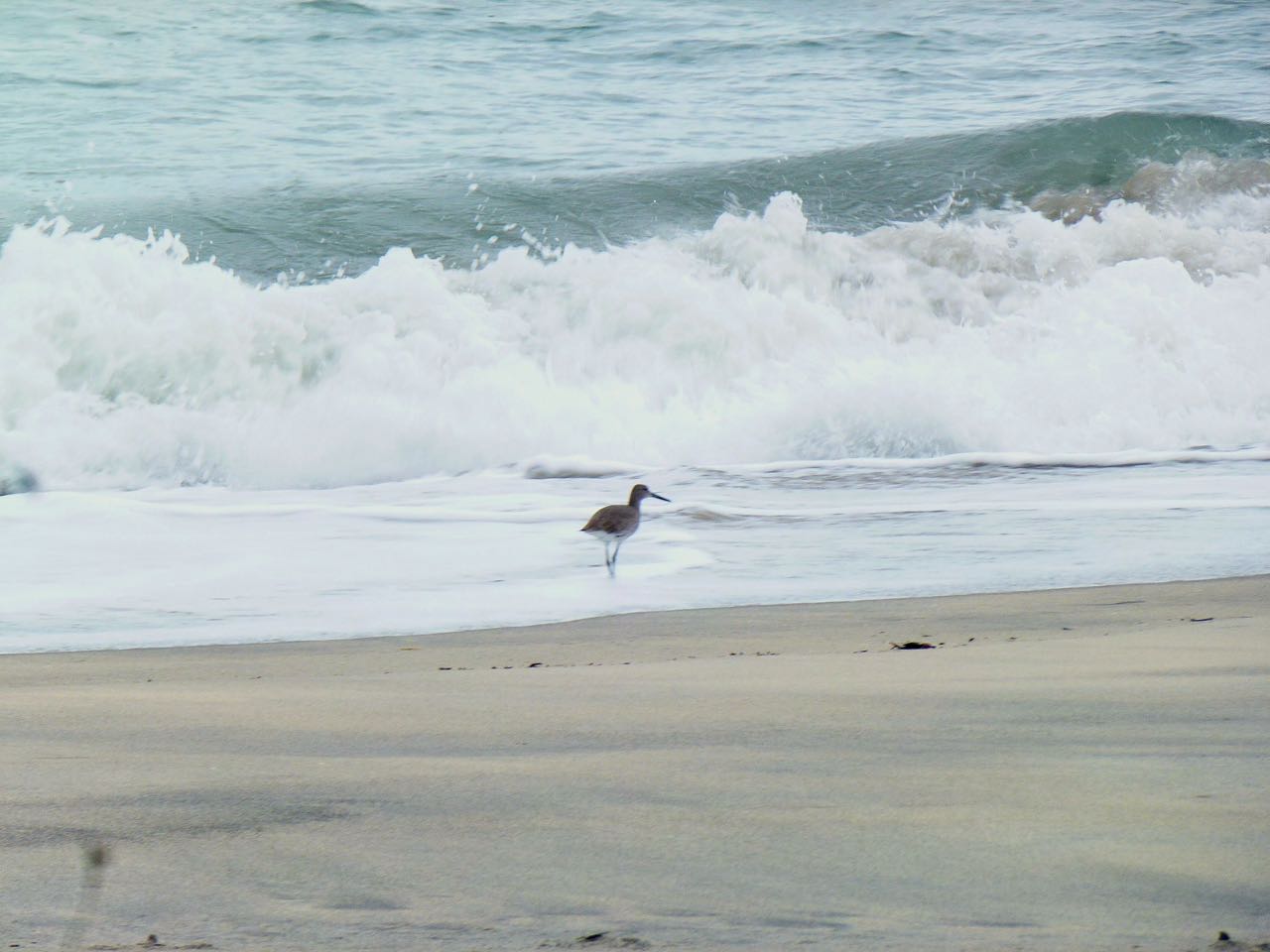 Willet - Photo by William Young
Willet - Photo by William YoungAfter lunch, we went to El Chiru. We arrived at about 3:30, but we had not birded long before it began to rain so hard that we decided to call it a day. Before we left, I saw my first Lesser Goldfinch of the trip. We saw a flock of Fork-tailed Flycatchers fly over. I saw a Plain-breasted Ground-Dove, who was slightly smaller than the countless Ruddy Ground-Doves we had been seeing all day. Regarding migrants, one of the big surprises was a Morning Dove. I also saw many Yellow Warblers, a couple Northern Waterthrushes, two Eastern Meadowlarks, many Yellow-billed Cuckoos, countless Barn Swallows, a Summer Tanager, a Swainson's Thrush, and an Olive-sided Flycatcher.
Today's birding provided a good mix of habitats combined with ocean air. We saw slightly more than 80 species, and many were new for me on the trip.
October 18This morning, we could sleep a little later. Breakfast was served at 6:30, and afterwards, Danilo took me and four other people to Chorro El Macho, (which has an 80 meter waterfall), Las Minas Road, and Candelario Road, all close to the Lodge.
When you bird in a rainforest, the light is not good, and many of the birds move quickly, so has to be quick with binoculars. You might have only a quick glance. One of the birds we looked for was the White-tipped Sicklebill, the large hummingbird with the semicircular beak. I had about a five second look at one at Cerro Azul, but today, the bird came in to feed at a large Heliconia, giving us a long look. A couple days ago, I had had a brief look at a Scaly-breasted Wren, but today, we watched two in a territorial squabble. Normally, they bob their tails when they walk, but the one I had a good look at today was too occupied with the other wren to behave that way. It was still difficult to see any pattern on their plumage in the low light of the forest floor. We looked for a Rufous-vented Ground-Cuckoo, who is like a big Roadrunner. They can be found at ant swarms, but we did not find any swarms. A couple days ago, Danilo saw two in the area where we were today.
At La Mesa, we heard someone driving around with a loud speaker, uttering what sounded like a Moslem call to prayer, but he was asking people to sell aluminum. Danilo came equipped with a machete, and he used it on a muddy path where we looked for a Black-crowned Antpitta. We did not find one. We then went to another area and saw a few feeding flocks. I ended up seeing three new antbirds for the trip. The Slaty Antwren is one of the dark antbirds with a few white spots on the wings. The female is a classic LBJ. I saw a Russet Antshrike, who is another LBJ. I would have enormous difficulty sorting these species out on my own. The easiest one to identify was a Dull-mantled Antbird, who has a dark gray cap, dark brown wings, and a red eye which stands out. We found two who were making a lot of noise on the forest floor.
While we were in the forest, I saw a Buff-throated Foliage-Gleaner, the same species I had a brief look at a couple of days ago. I saw the buff throat and the long tail. We had a much closer look at a Chestnut-capped Brush-Finch, who is a really big finch (about seven inches). I did not see the entire bird the other day. A family of Tawny-faced Gnatwrens was working one of the areas we visited. I saw the tawny face on one of them. When on the ground, they sometimes cock their tail like a wren. I had an excellent look at a Sulphur-rumped Flycatcher, and I saw the yellow on its rump. Regarding migrants, there were Canada Warblers in a few places. I had a fleeting glimpse of a Mourning Warbler and a nice look at a Blackburnian. I heard the whit note of a Swainson's Thrush. Flying high in the sky with some vultures were two Swainson's Hawks; I could see the rufous bib when looking at one in the scope.
As we were coming out of the forest, it began to rain, so we went back to the Lodge for lunch. By the time lunch was over, it was raining even harder. At three when we were supposed to go out birding, it was still coming down hard, so we stayed at the Lodge and looked at the feeders. Among the species seen around the feeders were: Collared Aracari; Rufous Motmot; Blue-Gray, Palm, Crimson-backed, and Flame-rumped Tanagers; Thick-billed and Tawny-capped Euphonias; Rufous-capped Warbler; White-tipped Dove; Clay-colored Thrush; Buff-throated Saltator; and House Wren. A Red-tailed Squirrel came to one of the feeders, and instead of nibbling on a banana as the birds do, it ran off with an entire banana. While it was on the feeder, it curled its tail backward so that it was resting on its back.
October 19
This morning, I got up at 4:30 to see if the Internet was working. I went to the dining area, which is the only place that gets Wi-Fi, and the signal was not yet up. However, I did find one of the staff busily reading through a couple of Panama field guides, with the pages opened to the Northern Scrub Flycatcher, one of the flycatchers that looks distressingly like a lot of the other flycatchers. Breakfast was at 5:30, and after we ate, Danilo and Eliecer took us to a remarkable, albeit strange, place called Altos del Maria. It is located in the mountains on the continental divide east of El Valle, and the beautiful scenery features mountains, cliffs, and valleys. Our destination was an expanse of cloud forest at 3,600 feet that has a lot of highland species not found near the Lodge. We needed four-wheel-drive vehicles, because although the roads are well paved, they are really STEEP, as in 30-degree-incline steep. To get into the area where we were going, we had to pass three security checkpoints. We drove past beautiful homes, but the place was somewhat eerie. The only people we saw were a few construction workers and the guards at the checkpoints. People use these homes for weekends and vacations, but the homes are not in an area that would allow many friends to visit, unless they have a four-wheel drive vehicle and can negotiate the steep inclines. There are a lot of introduced pines, and the number and uniformity of them sticks out after one has been in a rainforest where one does not see large groups of any tree species. The area features a lot of Neoclassical statues of women in various states of undress.
The birding was outstanding. We started out in a light drizzle, but it soon cleared, and we did not experience any rain for the rest of our birding day. At our first stop before Altos del Maria, we found a Tody Motmot, the species on one of the Canopy Lodge tee-shirts. It does not look like any of the other motmots, being small and having a prominent white stripe on its face. When we arrived at Altos del Maria, we found a young White-ruffed Manakin, a small round green bird with a white throat. We later found an adult male, who is black with a white throat. We saw both a male and a female Orange-bellied Trogon. The two sexes have different undertail patterns; the male's is heavily barred, while the female has only a few marks. I found a perched female Green-crowned Brilliant, and I later found a male. This hummingbird is large, with a spot behind its eye; the male is mostly green. About half the size of the brilliant is the Snowcap, one of the hummingbirds we went to this area to see. We saw a male at flowers about 50 feet up in a tree. The tiny male Snowcap is purple, with a white cap and a white vent, making it appear white on both ends and dark in the middle.
I saw two new wrens for the trip. The Ochraceous Wren has a little tinkling song compared to some of his loud relatives. The Gray-breasted Wood-Wren is much louder and looks a lot like the White-breasted Wood-Wren with a gray breast. I saw two new ovenbirds. While we were looking at some tanagers, a Red-faced Spinetail popped into the open. It has a red cap and face, and saw the long tail, unlike my view of the Pale-breasted Spinetail the other day. I saw a Spotted Barbtail, who is brown on the back and heavily spotted underneath; the spots are light. At times, it behaved like a cross between a xenops and a woodcreeper. There were quite a few Black-and-yellow Tanagers, who are bright yellow with black wings and tail. I enjoyed seeing a male Blackburnian Warbler in breeding plumage. I have seen quite a few Blackburnians since I have been here, but this was the first male in breeding plumage. As much as I have enjoyed seeing so many new birds, I still get a thrill whenever I see that orange throat.
Before lunch, we looked for a Black-crowned Antpitta. This species is very secretive and walks along the ground at a fast pace. We saw one cross an area twice, but all that I saw was a black blur. Danilo took some people to look for it. I did not go, because the area where they went was down a steep, muddy hill, and I did not want to risk hurting myself for the final week of my trip. The area where we ate lunch was up more than a hundred steps. When we finished, we walked still higher to once again look for the antpitta. This time, one walked along the forest floor and eventually crossed the path on which we were walking. Unlike the field guide image, which shows a bird with a dark brown back, this bird had a rufous back. It has long legs and no tail. It tends not to fly much and seems to get around mostly on foot. Its behavior is not much like the Streak-chested Antpitta, who so captured my imagination when I saw it last week.
After lunch, we went to the foot of the steps, and we encountered a nice feeding flock. Among the birds were a male Summer Tanager, a Yellow-throated Vireo, a Bright-rumped Attila, a Great Crested Flycatcher, and a Sulphur-bellied Flycatcher. The Sulphur-bellied Flycatcher was streaked below, with a rufous tail. We later saw a flying Great Black Hawk, who showed a white rump and a white tailband. On the way home, we stopped and saw a pair of Peregrine Falcons. While we were watching one perched at the top of a tree, we also saw a Bat Falcon fly by. We then stopped at the place where we saw the Tody Motmot this morning, and Danilo put the scope on a male Rosy Thrush-Tanager. I saw the rosy throat and the red over the eye. At the same stop, we saw a perched male Long-tailed Tyrant. As we were driving back to the lodge, Danilo somehow managed to see a tiny hummingbird perched up in a bare tree. It was a female Rufous-crested Coquette. She had a white band above her tail like a male coquette and like the Green Thorntail. She was tiny, only slightly bigger than a Snowcap. When we got back to the Lodge, we saw both Band-rumped and White-collared Swifts. The latter are larger and have longer wings.
Among the migrants we saw were Broad-winged Hawks, an Olive-sided Flycatcher, Eastern Wood Pewees, Golden-winged and Tennessee Warblers, Red-eyed Vireos, Barn Swallows, Hepatic Tanagers, and Swainson's Thrushes. I also saw a leaf katydid.
 Leaf Katydid - Photo by William Young
Leaf Katydid - Photo by William Young
October 20
Today was a travel day. I had breakfast at 6:30, and there were two women named Martha and Maria who were with us. They are from Miami by way of Cuba. At 7, Eliecer (whose birthday was today) and Martha were leaving for a walk up the road from the lodge, and because I did not have much to do until 10, I asked to join them. Martha is not a birder, but she is very interested in nature, and we had a pleasant walk on a sunny morning.
On the walk, I saw two new birds for the trip. The Buff-rumped Warbler, along with the Rufous-capped Warbler, is a resident warbler in the vicinity of the Lodge. It is brown, with a buff rump and a buff undertail. It is generally found around streams, and because it darts around, it can be difficult to see. I had not had a good look at one, but today, I saw one foraging amid the large rocks in a stream. In the same stream was an anole lizard, who at times was expanding his red throat pouch. Later, we saw another Buff-rumped Warbler foraging in a drainage gully by the side of the road.
Another new bird was the Orange-billed Sparrow, who does not look like any of the sparrows where I live. It is mostly green, and its black head has narrow white stripes, unlike a White-throated whose black-and-white crown stripes are about the same thickness. This sparrow has a large orange bill. Most of the ones I have encountered in Panama have been skulking along the forest floor, but today was the first time I had a good look at one.
As we walked down the driveway to the Lodge, Eliecer said that the flowers across the road sometimes attract Rufous-crested Coquettes, the tiny hummingbird who a specialty of the highland. He said he had not seen one here for a few months. As we walked a little further, Eliecer spotted a male in the top of a bare tree. I had a brief look at the backlit bird before it zoomed away. We had seen a female yesterday, also perched in the top of a bare tree. We later saw a Green Thorntail, a small hummer who resembles the coquette, with a white stripe on the rump. We saw a male and female Crowned Woodnymph. The male fed on purple flowers very close to us.
We saw a Gray-necked Wood-Rail scurry across the road behind us. It appeared to be the size of a chicken, with long legs. We went to the Chorro El Macho waterfall, and Eliecer asked where we had seen the White-tipped Sicklebill when we were with Danilo. I told him that it was just across the bridge we were about to cross. When we got to the flower, the sicklebill popped up and fed for about two minutes. I had a long look at the big curved bill and the white-tipped tail feathers.
I soon left Eliecer and Martha to head back to the Lodge. While I waited to get into the van to leave, I spent some time around the feeders and saw a lot of tanagers, euphonias, and other birds. We left a little after 10 and began the long drive from the Lodge to Canopy Tower. The scenery around El Valle is beautiful, and there are vistas where one can see the Pacific Ocean in the distance. I used to have a drama professor in college who talked about elaborate theater productions where you leave the theater "whistling the scenery". The drive today provided the natural equivalent for the first hour or so. As we got closer to Panama City, the beautiful scenery disappeared, and we became stuck in traffic a number of times, mostly due to Saturday road construction. As we drove through the city, we went past some mudflats that had a lot of shorebirds, but our vehicle was moving too fast to allow us to identify them. After dropping some people off at the airport, we reached Canopy Tower a bit after 1:30. The staff prepared lunch for us.
When we arrived at Canopy Tower, some heavy rains began. During heavy rain, it is difficult to hear any birds, even though some remain active. We decided not to go out for our 3 o'clock walk, which is probably just as well. At about 5, the weather cleared, so I went up to the observation deck. I was able to get reacquainted with some of the birds at the Tower. I saw a couple of Chestnut-sided Warblers (I had seen one at the Lodge this morning) and a Canada Warbler with a nice necklace. We stayed out until six, watching the clouds and the changing light over the beautiful scenery in the distance.
October 21
This morning featured some of the best weather since I arrived. It was clear and warm when we went up to the observation deck at six to watch the sunrise. I saw a good mix of migrants, including a Blackburnian Warbler, Chestnut-sided Warblers, a Swainson's Thrush, Eastern Wood-Pewees, a Rose-breasted Grosbeak, Yellow-throated and Red-eyed Vireos, and a Summer Tanager. The residents included Golden-hooded, Plain-colored, and Palm Tanagers, a Green Honeycreeper, Keel-billed Toucans, Dot-winged Antwrens, a Black-breasted Puffbird, and a Lesser Greenlet. A male and female Blue Dacnis perched at the top of a tree, and Michael calls the male Dacnis a "baby cotinga", because it is an electric-blue like the Blue Cotinga. We saw a Brown-capped Tyrannulet and a Black-capped Pygmy-Tyrant, both of whom are tiny with yellow bellies. A female Red-capped Manakin perched on a branch; she is a plain, round olive bird.
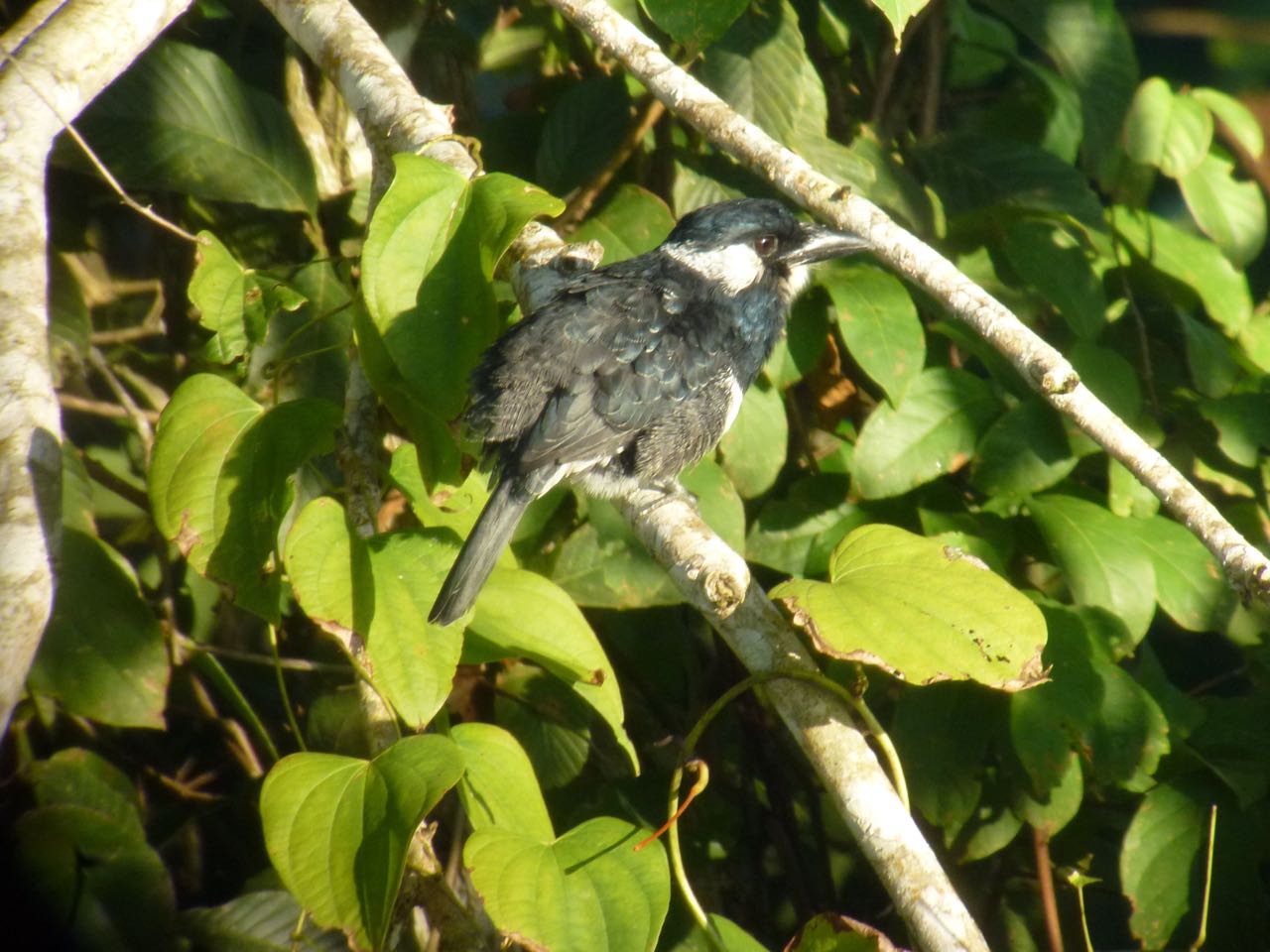 Black-breasted Puffbird - Photo by William Young
Black-breasted Puffbird - Photo by William YoungAfter breakfast, Michael took me and five other people for a walk down Semaphore Hill Road. Before we left, we saw a Tiger Longwing butterfly. A bit after we started, we found a large land snail in the road. One of the first birds we saw was a Rufous Mourner, and we heard it singing its mournful long single note. It is a brown bird with barring on the breast, like a Northern Barred Woodcreeper. Michael said it is only the third time he has seen one in fifteen years of birding. We saw two Cocoi Herons fly over; they look like Great Blue Herons. I got a fleeting look at one, and then the pair flew into the open. I could see the white feathering on the upper legs, unlike the Great Blue whose upper legs are the color of cooked turkey drumsticks. In the trees, we saw both two-toed and three-toed Sloths, as well as coatis. The Canopy Tower area has many more mammals than the area around the Canopy Lodge. We saw a couple of agoutis scrambling around.
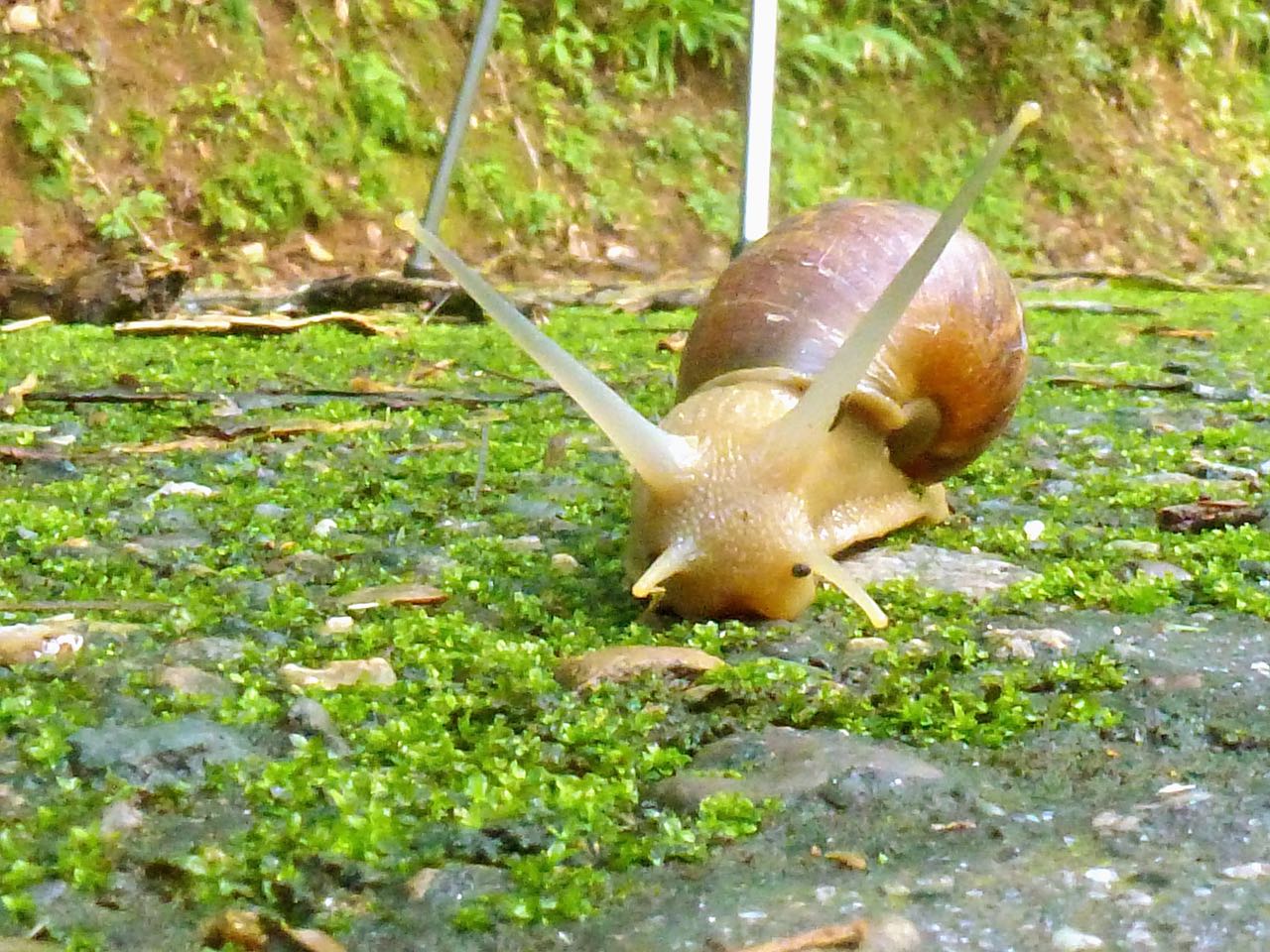 Snail - Photo by William Young
Snail - Photo by William YoungBeing in Panama right now is like being in the middle of a three-ring circus. The first ring is the forest birds. The second ring is all of the wonders of the rainforest. And the third ring is all of the hawks that are flying over. Some tour groups come here only for the hawks. This morning did not have a great flight, but there were a lot of raptors and vultures in the air. In one spot, we saw two Peregrines mixed in with the Broad-winged Hawks and vultures. We later saw a Gray Hawk, who appeared to have slightly darker patches near the end of its wings. Later back at the Tower, we saw a lone Swainson's Hawk circling in the distance.
A species I really wanted to see was a Black-faced Antthrush. I had heard the slow three-note call on many days of my trip, and today, I saw one. Like the Black-crowned Antpitta two days ago, it walks along the forest floor and has a very short tail which it often cocks. Its back is much more rufous than in field guide, and it has a black mask. We saw a male and female Chestnut-backed Antbird; I saw the blue orbital skin, which the similar Dull-mantled Antbird does not have. We saw a female White-tailed Trogon perched; like the Orange-bellied Trogon, the female's undertail pattern is different from the male's, showing some barring rather than being all white. A Dot-winged Antwren foraged in the same area. A female Blue-crowned Manakin perched on a branch — another round green bird. We saw wild papaya, which is different from the fruit people eat. We had a nice look at a butterfly that might have been a Cyan Emperor.
 White-tailed Trogon Female - Photo by William Young
White-tailed Trogon Female - Photo by William YoungI saw a male Slate-colored Grosbeak. He is almost entirely slate gray, but he has a huge red bill like a male Northern Cardinal. The chip note sounds like a cardinal's, and the song sounds like a Baltimore Oriole's. We also saw a Black-capped Pygmy-Tyrant, a bird whose name is almost as long as its body. It is one of the smallest songbirds, measuring 2.5 inches. It is white below, with a yellow undertail and dark cap. One of the reasons it looks so small is that it has virtually no tail. I am not sure what advantage there is to having such a short tail.
After lunch, we went to the Ammo Ponds and surrounding areas. I saw a lot of birds I had previously seen, but I saw a few new ones. I saw a perched Amazon Kingfisher, who is the size of a Belted Kingfisher, but green. Another difference is that the male we saw has a rufous breastband, and the female does not. With the Belted, the female has a rufous breastband, and the male does not. We saw a single Purple Martin among the many Barn Swallows and Gray-breasted Martins. The Purple Martin was bedraggled and looked as if it had just come out of the water. Mixed in with the swallows and martins was a Mangrove Swallow. While we were returning to the van, Michael saw an American Crocodile. It started to swim toward us, went totally underwater, and then resurfaced toward the middle of the pond.
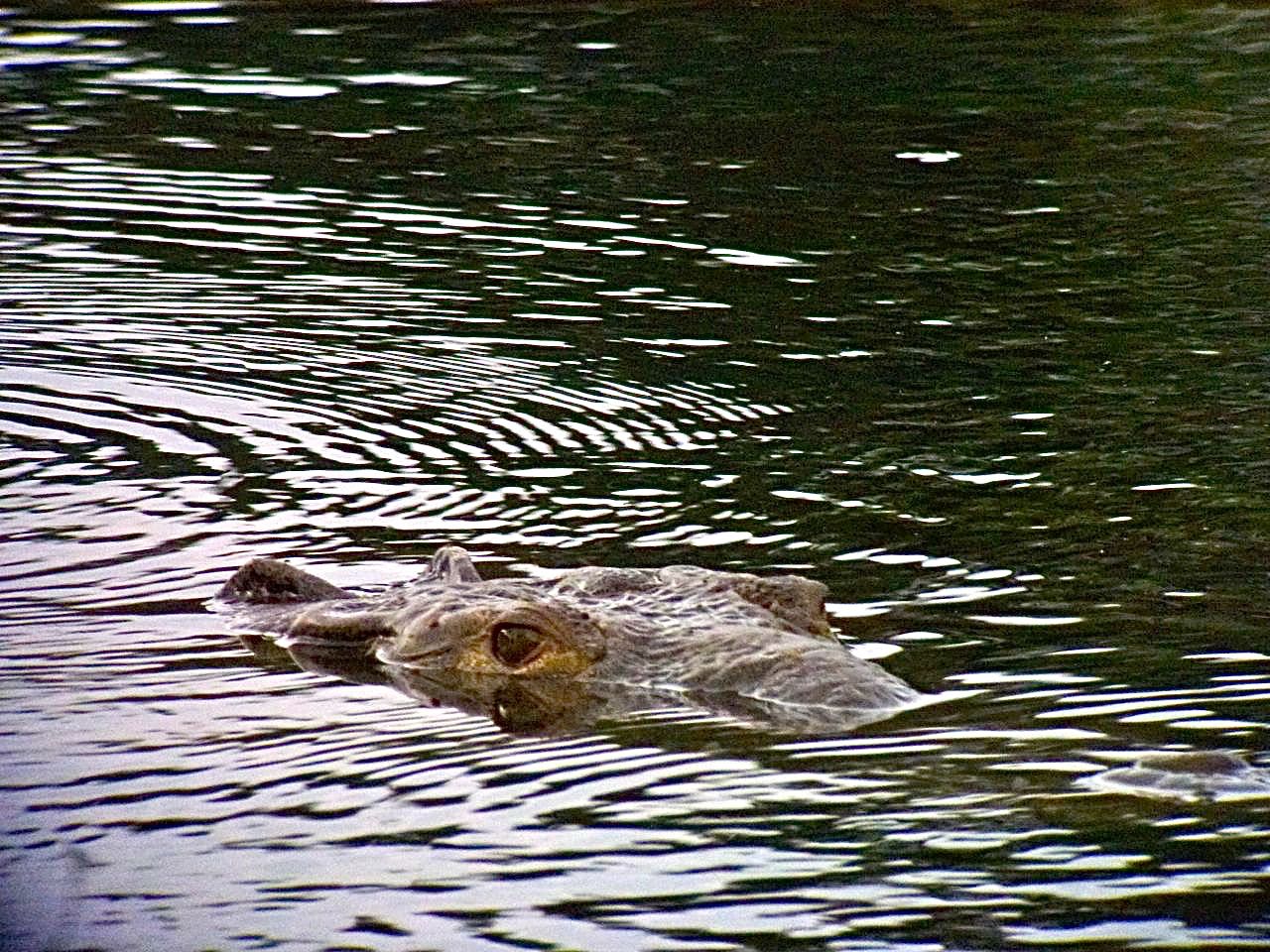 American Crocodile - Photo by William Young
American Crocodile - Photo by William YoungBefore we left, we saw a male Golden-collared Manakin. This was the first male I had seen. The weather had become dark and threatening, and we were looking into a dark patch of forest. The manakin has a golden collar and throat along with a black cap. He sat on a branch and preened.
As I was getting ready for bed, I heard some owls calling outside my window. It sounded as if the area around Canopy Tower had been invaded by Black-and-white Owls. At least four were giving their rising six-hoot call, which places extra emphasis on the final hoot. I went to the top floor to get a flashlight. I then went outside and looked in a number of trees, and as I was shining my light toward the eastern side of the Tower, I saw one fly. Another one was calling from nearby, and as I looked for it, Michael came out. He was able to mimic the call of the owl, and one flew right over our heads. It landed in a branch near the raised platform in front of the Tower, and we had some nice views. Michael went and got a telescope, and when he came back, the owl had not moved. The bird is larger than the Mottled Owls, but smaller than the Spectacled Owl. It has dark wings and heavy black-and-white barring below. It does not have ear tufts. The owl presented a fine ending to another wonderful day of birding. When I finally went to bed after midnight, the owls sounded as if they were even closer than when I was outside. They were hooting frequently when I fell asleep.
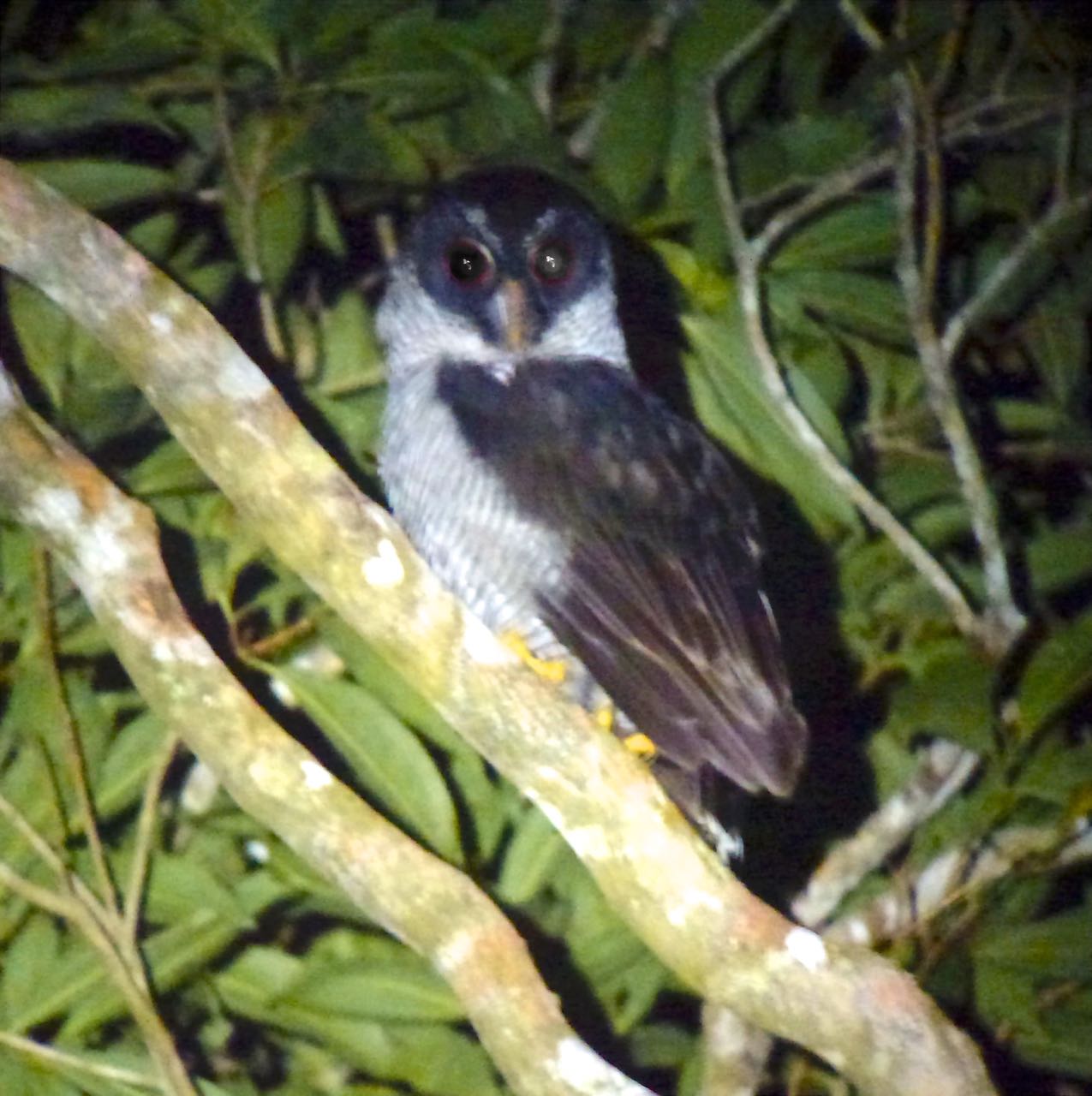 Black-and-white Owl - Photo by William Young
Black-and-white Owl - Photo by William Young
October 22
This morning, we were up on the observation platform at our usual time of 6 a.m., but we could spend only a half an hour there before we ate breakfast. A new bird for the trip was a Bay-breasted Warbler. I looked down on the bird and saw some bay on the sides and a streaked back. Michael took me, Martin, and some other people to the Pipeline Road. Included in the group was a couple of naturalists/videographers from Bulgaria named Boris and Iva. Also there was a couple from England named Matt and Nicola. Last night while I was up on the third floor trying to get a stronger Wi-Fi signal, Matt came down from the fourth floor with a vial which contained a small spider he thought might be related to the black widows. Nicola is more interested in moths and was especially interested in a moth that landed in Martin’s cereal bowl after he had finished eating.
When we reached an area just before the Pipeline Road, the trees were filled with birds. I spotted a Golden-winged Warbler. One of the best birds of the morning was a Little Tinamou, crossing the road. It has a gray head and a rufous back, and it is much smaller than the Great Tinamou we saw on our last trip to the Pipeline Road. We saw a Black-bellied Wren, who is dark brown on the back and has a white throat. A Lineated Woodpecker popped onto a branch at eye level, and we saw the sun showing through its bright red crest.
A new bird for the trip was a Rufous Mourner, a bird whose plumage is entirely rufous or a variation of it. It was flycatching — it is a flycatcher. The Speckled Mourner I saw yesterday is included with the becards and tityras, but taxonomists are not sure how to classify these species.
We spent a lot of time today looking at wildlife other than birds. We saw some small frogs, one of whom was a poison dart frog. Another was a leaf frog, who looked like a leaf. We saw a lot of beautiful butterflies and a Helicopter Damselfly, who moved around on its delicate wings. There was a giant spider on a pink ribbon — I am not sure of the species of the spider or why the ribbon was there. We saw an array of remarkably well camouflaged insects. And we saw a number of flowers of the Hot Lips plant, which is in the coffee family.
A highlight was a young Variegated Squirrel. The Gray Squirrels at LBJ Grove in Washington can be fairly aggressive when approaching people for handouts. This Variegated Squirrel actually climbed onto people. He first went to Iva, who was carrying a video camera on a tripod, and climbed up one of her legs and kept going until he reached her shoulder. He also explored her camera. Then he jumped down and climbed up my leg and torso. This little guy seemed to be hungry, thirsty, and curious.
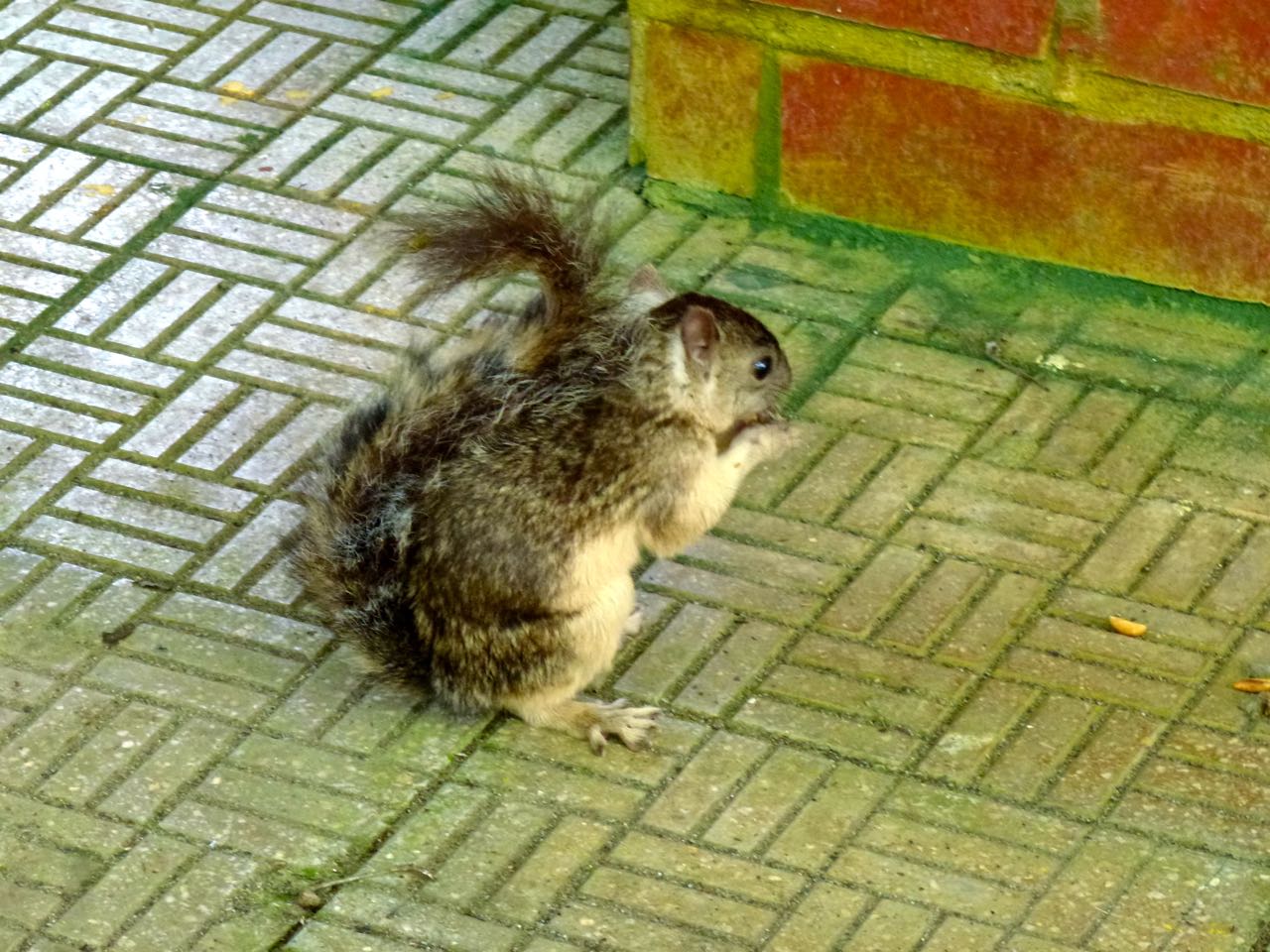 Variegated Squirrel - Photo by William Young
Variegated Squirrel - Photo by William YoungWe finished our morning of birding and headed back to the Tower along a road that runs by the canal. We watched a Yellow-headed Caracara taking a dust bath. As we were stopped for the light to get onto the one-lane bridge, we saw a large cruise ship in the canal called the Peace Boat, advertising the goal of ending world poverty by 2015 and spewing a lot of smoke into the air. We arrived back at the Tower in time for lunch.
After lunch, a thunderstorm blew in, and it began to rain heavily. I went to my room and fell asleep. I woke up at three, which is when our trip to the zoo was supposed to begin, but we waited another hour or so for the rain to let up. We finally left a little after four, and when we drove to the zoo, we found it had closed at 4. We then drove across the road to the Summit Ponds. It is in an area where the national police train, and a lot of them were just getting off duty when we arrived. Between the traffic and the rain, birding was difficult, so we decided to call it a day. As we were returning to the van, we saw a tiny frog no bigger than a piece of gravel. When we tried to look at it more closely, it flattened itself out and blended in with the road.
October 23
I woke up around 2:30 this morning and heard a Mottled Owl calling. I went back to sleep, and when I eventually got up and went to the observation deck at six, I could still hear it. We did not stay on the deck long, because we had to eat breakfast and leave Canopy Tower at seven. On the observation deck, I looked down on a Bay-breasted Warbler and saw the streaks on its back. This species is now starting to come into Panama. I saw a male and female Summer Tanager. After breakfast, as we were preparing to depart, I saw a silhouette of a bird in a tree near the Tower. When it flew to a closer tree, I saw it was a female Blue Cotinga. She was brown, with a spotted breast.
Michael took me, Martin, Nicola, Matt, Boris, and Iva to a section of the Pipeline Road different from yesterday. Getting to our destination was difficult, because the heavy rains last evening made the dirt road very muddy. A couple of times, Michael had to get out of our vehicle and chop away fallen tree limbs with a machete. We got off to a good start birding when we saw a male Great Jacamar. He had iridescent green plumage, was rufous below, and from certain angles, I saw white on the throat. It looked like a large hummingbird. A few times, it uttered its plaintive whistle. In the same area was a Checker-throated Antwren. A Plain Brown Woodcreeper was trying to swallow a large wolf spider, and there was also a Broad-billed Motmot. For the second consecutive day, we found a Rufous Mourner. We found an ant swarm, and had nice looks at a Bicolored Antbird. I also got my first look of the trip at an Ocellated Antbird. I saw the orbital ring and the light brownish breast. The light was not good on the forest floor.
 Great Jacamar Male - Photo by William Young
Great Jacamar Male - Photo by William YoungDuring our visit to the Pipeline Road, we saw many unusual insects in addition to the birds. One looked like the Darth Vader of bugs. Someone found a walking stick insect, and I held it on a leaf while everyone else photographed it. At one point, the insect walked off the leaf and climbed onto my head.
We soon found a pair of Streak-chested Antpittas, which remain my favorite bird of the trip. One ran across the road, and another stayed on the forest floor and sang. I saw one raise its wings, but I did not see it inflating itself. I later saw a Black-faced Antthrush. A Song Wren was on the forest floor, tossing leaves. We heard its haywire cuckoo-clock song; it is one of the species who is better to hear than see. A Spotted Antbird stood on a rock and took advantage of an ant swarm. We saw a male Blue-crowned Manakin after having seen the female. We had nice looks at a Buff-throated Foliage-Gleaner, and it is one of many species who is more rufous than is pictured in the field guide. I once again heard a Scaly-throated Leaftosser, but did not see one.
We had lunch in a small clearing on the Pipeline Road and had a nice scope look at a Tamandua. It eventually went up into a tree and took a siesta. We then had to say good-bye to Martin, who was heading back to England on a flight this evening. The remainder of the group then headed over to the Rainforest Discovery Center. There were Mantled Howlers in the trees in the parking lot. We went to the hummingbird feeders and saw many different species. The White-necked Jacobins were the most noticeable. I sat an arm's length from one feeder, and it is amazing how small the hummers are.
We then went up the tower at the Discovery Center and looked for a male Blue Cotinga, but had no luck. Two Blue-headed Parrots flew over, showing a much deeper wingbeat than Amazona parrots such as the Red-lored. We found a White-necked Puffbird, and near the bottom of the tower, we saw a female White-whiskered Puffbird. On the Pipeline Road, we had seen a Black-breasted Puffbird, so we had a good puffbird day. We also saw three species of Motmots. We later went to the wetland area and saw a pair of Snail Kites. It was getting late and the skies were threatening. Because we were riding in an open-air vehicle, we decided to return to Canopy Tower before the rains came.
October 24
We intended to get an early start this morning to go to the Metro Park before the rush hour traffic became bad. When we were about to leave at 6:30, I saw a hawk moth caught in an orb-weaver spider web, struggling to get free. After awhile, it managed to get one wing free, and just before we left, it became totally free. Michael was leading the trip for me, Matt, and Nicola. We ended up in about four traffic jams, and a trip that normally takes 25 minutes took an hour and 45. On the way, we saw more of the psychedelic buses, including one with a photo of very young Sylvester Stallone on the back. While we were stopped in traffic, I saw a Baltimore Oriole perched on razor wire and a Yellow Warbler foraging in bushes.
When we arrived at the park at about 8:15, we saw a nice mix of resident and migrant birds. Among the migrants were Eastern Wood-Pewees, a few Bay-breasted Warblers, a Black-and-white Warbler, a Northern Waterthrush, and an Acadian Flycatcher. A new bird for the trip was a Yellow Tyrannulet, which looked like a warbler. I saw a Rufous-breasted Wren; its black throat has white streaks. We had close looks at a female Slaty-tailed Trogon, a female Gartered Trogon, and a Whooping Motmot, who used to be part of the Blue-crowned species. The Common Potoo was in the same tree I had seen him previously. I noticed it had a bit of white near its wing.
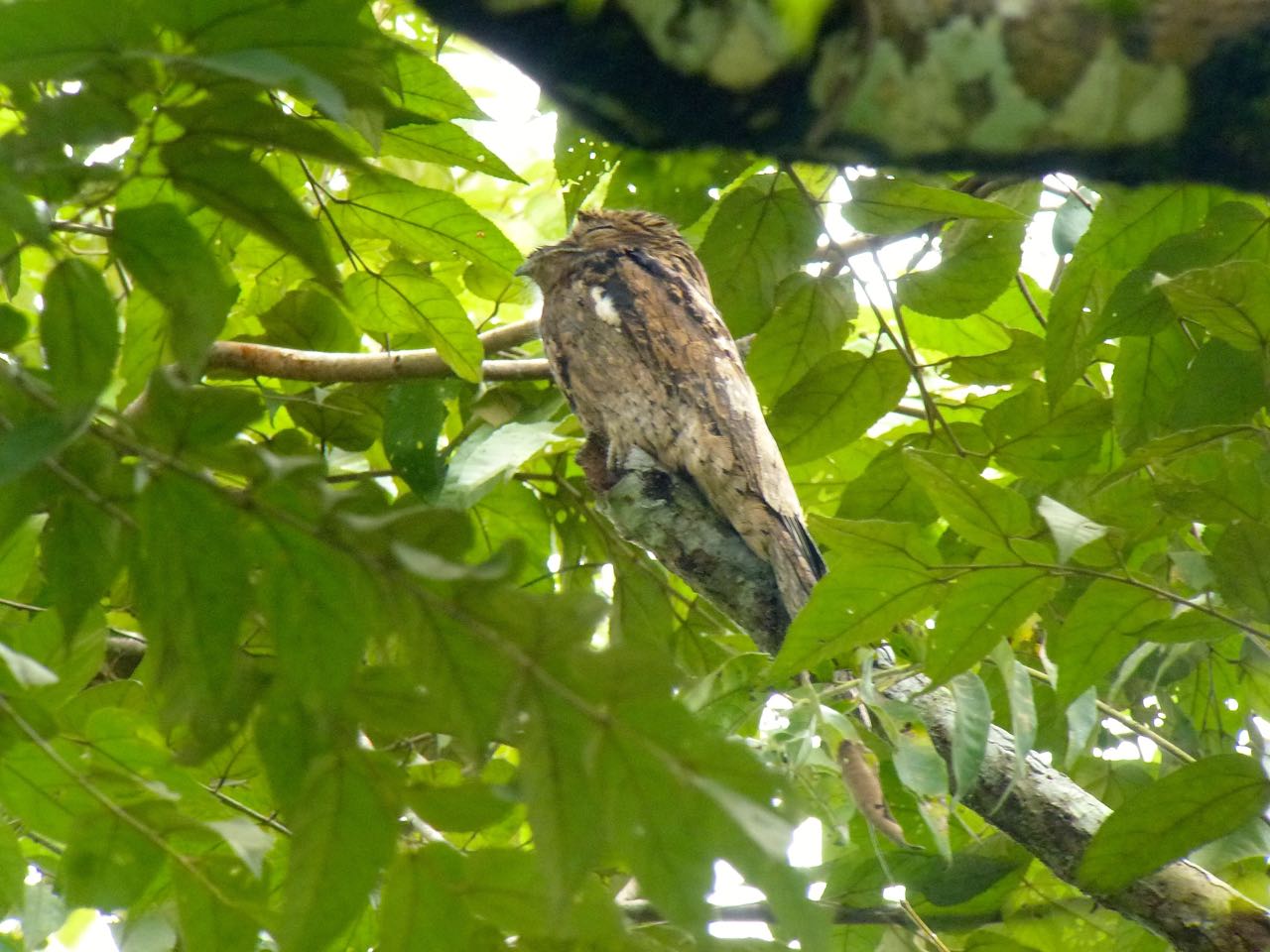 Common Potoo - Photo by William Young
Common Potoo - Photo by William YoungWe walked through the forest and saw wild cashew trees, the fruit of which is not eaten by humans but enjoyed by other mammals. It also is a favorite food of the Great Tinamou. We saw an Orange-billed Sparrow on the forest floor. We saw a Yellow-crowned Tyrannulet, who looked much paler below than in the field guide. We saw Social Flycatchers, who are one of the common flycatcher species in this area. For Panama, the birding was slow, even though we saw a lot of species. We occupied ourselves looking at insects, spiders, plants, and other things. We saw a damsel fly that appeared to be about four or five inches long. A strangler fig had enveloped one of the trees. A collection of Bonsai trees appeared to be an attempt to create a dwarf rainforest. And we saw a pond that had a lot of Red-eared Slider turtles.
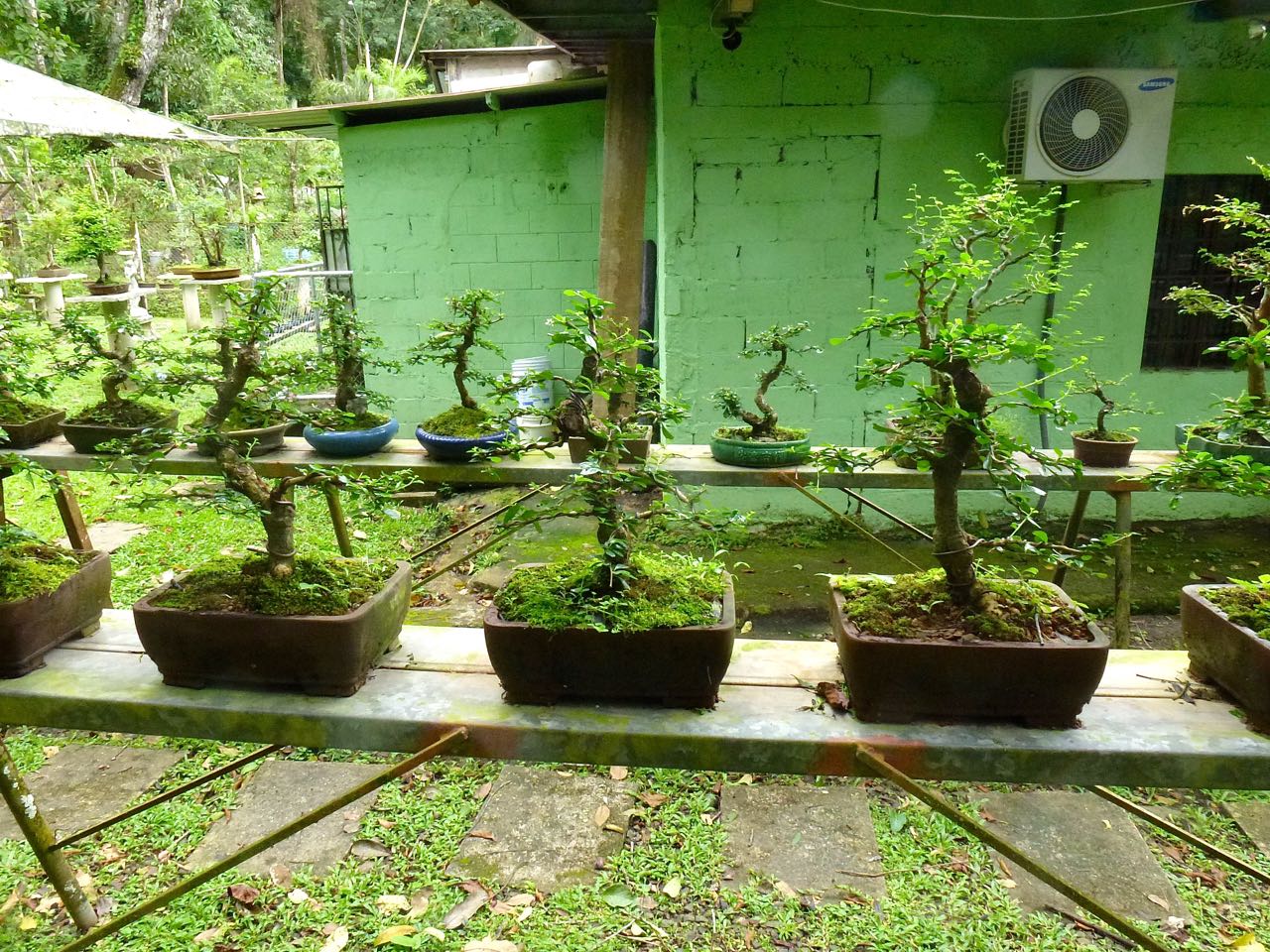 Bonsai Garden - Photo by William Young
Bonsai Garden - Photo by William YoungAs we prepared to return to our vehicle, we suddenly encountered a large feeding flock with a lot of species. Some of the migrant species were Blackburnian and Prothonotary Warblers and a Yellow-throated Vireo. The flock included Dusky Antbirds, a Fasciated Antshrike, Red-throated Ant-Tanagers, Crimson-backed and Carmiol's Tanagers, a Forest Elaenia, a Golden-fronted Greenlet, a Gartered Trogon, a Tropical Gnatcatcher, a Southern Bentbill, and a Cocoa Woodcreeper. One bird who stood out from the group was a Sulphur-rumped Flycatcher. It has a yellow rump, and it kept its tail fanned while it foraged like the fantails in Australia.
The Metro Park was where Martin had seen the 100,000 Broad-winged Hawks. We did not see any sign of hawk migration, but on the way back to the Tower, we saw a large kettle of vultures. At one point in our drive back, we were again stopped in traffic. This time, people were intentionally blocking the roads to protest the sale of state-owned land in Colon to private interests. The protest did not delay us long, and we were back at Canopy Tower a bit before one. We were supposed to go to the zoo in the afternoon, but it was closed because of the protest. Instead, we went to the area around the Chagres River.
Matt spotted a distant Peregrine Falcon perched on a tower. There was a road sign about crossing iguanas, and we saw one fall from a considerable height into the water. We found a Streak-headed Woodcreeper; I saw the streaks on its breast and how it is smaller than the more common Cocoa Woodcreeper. We saw a Rose-breasted Grosbeak, a Common Tody-Flycatcher, and a flyover Fork-tailed Flycatcher. We found a Northern Tamandua sleeping in a tree and a family of Purple Gallinules, with a male, female, and small black downy chicks.
 Northern Tamandua - Photo by William Young
Northern Tamandua - Photo by William YoungDuring the drive through the resort, we saw a lot of agoutis. For a lot of the trip, Michael and I had a running joke about counting agoutis. One day, in a relatively short period of time, we counted more than twenty. There is no shortage of them, especially at the resort.
We went down to a field and saw about 20 Lesser Capybaras. They are much bigger than agoutis and can weigh up to 80 pounds. Nearby, two Black Vultures perched on the railing of a gazebo. On the other side of the field, a flock of Band-rumped Swifts flew around. A few appeared to dive into the grass and stay there. I did not see where they landed. I had never seen swifts do this.
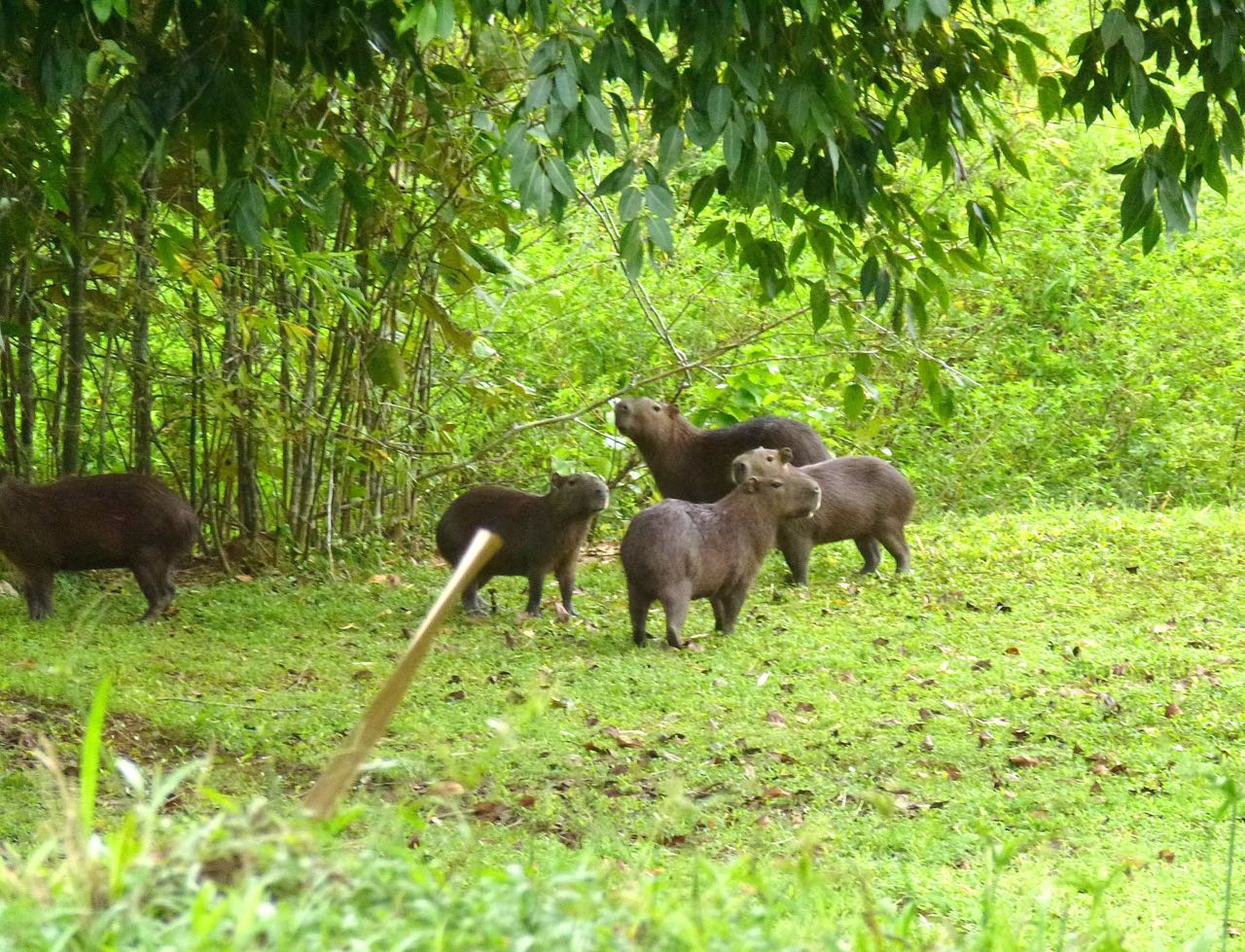 Lesser Capybaras - Photo by William Young
Lesser Capybaras - Photo by William Young
October 25
Today was my last full day in Panama, and it was a full day indeed. Michael took me, Matt, and Nicola to Cerro Azul. We left at 5:15 to avoid both the rush hour traffic and the demonstrations around the city. We did not encounter either, but the weather did not cooperate. We were at a higher altitude, and for most of the day, there was mist in the area that was absent around the Tower. Today also featured the windiest weather I had seen in Panama, and the light conditions were not always good for seeing color and detail on birds. Still, we saw a lot of birds. We did not get back to Canopy Tower until 5:15 in the afternoon.
One of the birds I saw at our first stop was a Black Phoebe, the first of this trip; it was on a rock in a stream. We looked in this area for a Fasciated Tiger-Heron, but we were not successful. We then saw some bay-colored birds. We saw a Bay Wren near the stream with the phoebe, and it was uttering loud chip notes. We then saw Bay-headed Tanagers and a Bay-breasted Warbler. We also saw a Swainson's Thrush, a Tennessee Warbler, a Gray-headed Chachalaca, and a male Blue-black Grosbeak. We saw a Shining Honeycreeper, who has yellow legs. We saw a Scarlet Tanager and a male Summer Tanager and two Black-cheeked Woodpeckers. A young Palm Tanager was begging for food. We found a male Gartered Trogon saw the green back and blue eyering. Lesser Goldfinches foraged in flowers and were squabbling with a Tennessee Warbler. A couple of Broad-winged Hawks flew over, and we scoped a distant White Hawk, who looked like a small white dot in the forest.
At 8:45, we went to the home of Jerry and Linda Harrison, who are biologists. Jerry compiled the plant list that is on the Canopy Tower website. They have many hummingbird feeders, and they usually put out bananas, but they did not have any. Instead, they put cooked rice on a feeding table, and Black-cheeked Woodpeckers spent a lot of time eating it, as did Yellow-faced Grassquits. A Tennessee Warbler searched all the baskets and tables where the bananas usually are before flying away; they eat bananas in the winter. We saw a White-vented Euphonia in a tree, and I saw the vent. We heard a Scaly-breasted Wren, formally know as the Southern Nightingale-Wren. Jerry said it has one of the longest songs in the bird world.
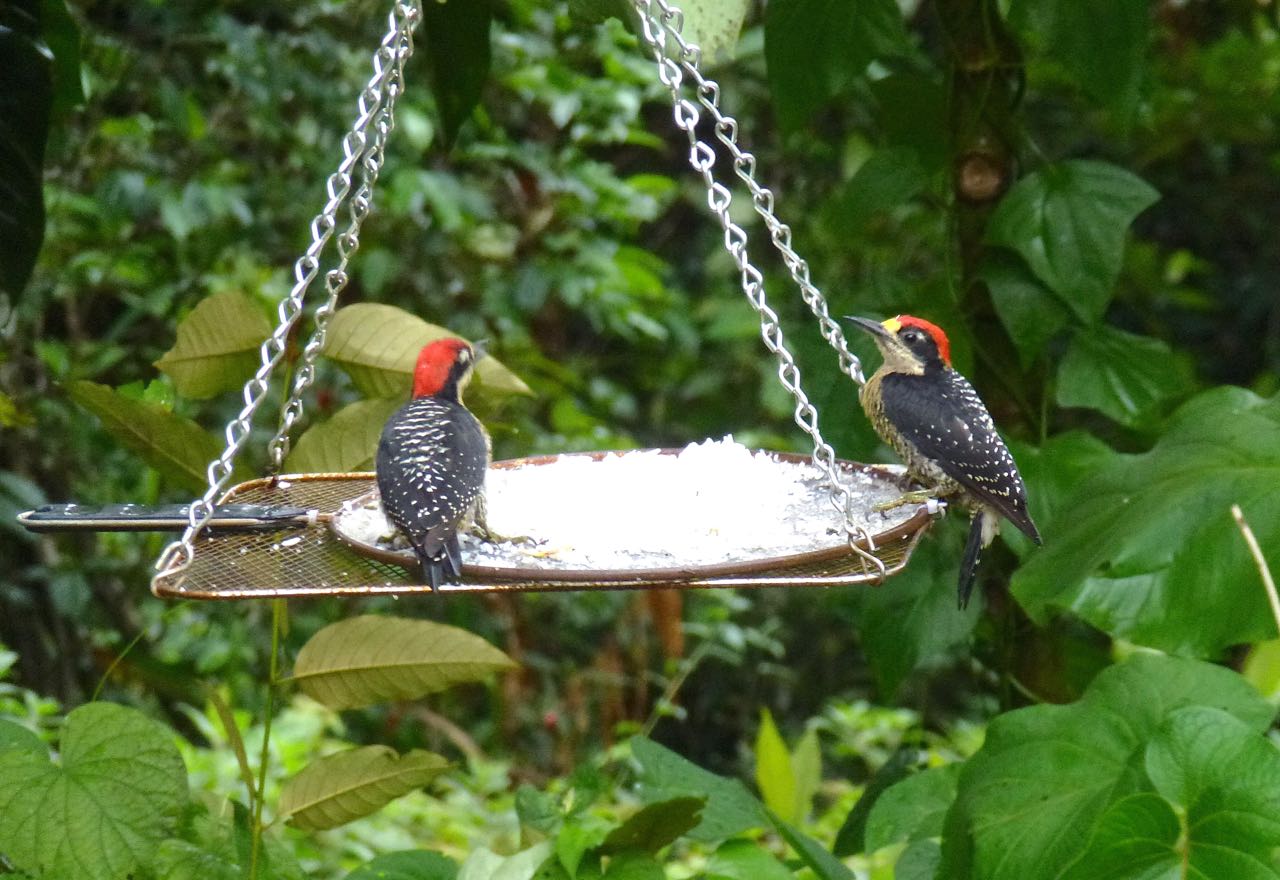 Black-cheeked Woodpecker - Photo by William Young
Black-cheeked Woodpecker - Photo by William YoungWe then headed to the Kaufmann House, which has eight busy hummingbird feeders. The visit was not quite as good the second time around, because the beautiful vista of the valley was covered by fog and mist. Still, we saw some nice birds. An Emerald Tanager was new for the trip. It did not look very green, because the light was not great. But the hummingbirds were still great. The Violet-crowned constantly squeaks, so you would know when one was near the feeders. Unlike last time, the Brown Violet-ears came to the feeders. After we ate lunch, we headed down a path from the side of the house to look for the White-tipped Sicklebill. We did not see it at the heliconia flowers on which it sometimes feeds.
When we left the Kaufmann House, we went down a hill and found a busy feeding flock. It featured Bay-headed, Hepatic (male), and Golden-Hooded Tanagers, an American Redstart, a Yellow-bellied Elaenia, and a House Wren. The elaenia had its crest up. We saw a Paltry Tyrannulet, who shows yellow edges on its primaries when its wings are folded. The weather was still foggy and windy when we went to look for the endemic Stripe-cheeked Woodpecker, but we did not see one. We stopped near our first stop of the day and saw a female Green Kingfisher standing on a rock. The kingfisher walked across the rock, and I don't remember ever before seeing a kingfisher walk.
We headed home past the airport, and along the way, we saw some birds. A White-tailed Kite was flying, as was an adult Snail Kite. We saw a Fork-tailed Flycatcher perched on a fence wire, with an Eastern Meadowlark perched on a post on the other side of the road. We saw a group of Greater Anis, who have long tails. Among the birds that Michael saw in the front seat that I could not see well from the middle of the second row were Black Terns and a couple of flying Yellow-crowned Parrot, the latter of whom are in the same Amazona genus as the Mealy and Red-lored. We then looked for shorebirds, but the tide was so low that many of the birds were too far away to identify. Among the closer species were Black-necked Stilt, Southern Lapwing, Whimbrel, Willet, and Short-billed Dowitcher. We had gone to one shoreline to look for birds, but the banks of the river were covered with trash. There was also a lot of trash on the beach where we were looking at the shorebirds.
 Trash on Beach - Photo by William Young
Trash on Beach - Photo by William YoungAfter dinner, Alexis and Michael took us spotlighting. We saw a two-toed sloth and then found a Common Potoo calling. The potoo's call consists of five long and sad notes that descend in pitch. It was good to see this species active by night instead of only seeing it sleeping on a perch by day. We found a Central American Woolly Opossum, an attractive brown creature with pink ears and a pink nose. And I saw my first snake of the trip — one of the bird-eating snakes. We could see the eyeshine as the snake stretched across a limb. Others saw a Boa Constrictor wrapped around a branch. While we were in the open-air vehicle, I felt something fall around the collar of my shirt. When I tried to brush it off, I discovered it was one of the small caterpillars that sting wherever they touch you, so I got stung on the right side of my neck and on a few fingers on my left hand. The stings hurt for about 30 minutes, but then stop.
October 26
On my final morning in Panama, I went to the observation deck of the tower to look and listen. Last night before I went to bed just before 1 a.m., I heard a Mottled Owl hooting. We had not heard any owls when we were spotlighting. This morning, I heard a Bright-rumped Attila, a Green Shrike-Vireo, Keel-billed Toucans, Mantled Howlers, and Eastern Wood-Pewees. I saw a toucan, and I saw yet another Bay-breasted Warbler. At breakfast, Matt said that Palm Tanagers would sometimes wait outside a window while people were eating breakfast and come inside to steal table scraps after people left.
Michael found the same species of moth that I had looked at with Matt and Nicola last evening. It has big red eyespots that you cannot see when the wings are folded. At 7:30, Michael took us to the Gamboa Resort. On the way over, we saw both a Yellow-headed Caracara in the road and a perched Broad-winged Hawk. Around the parking area of the resort, we saw Crimson-backed and Flame-rumped Tanagers, Southern Rough-winged Swallows, and Variable Seedeaters. A Red-crowned Woodpecker quietly perched at a hummingbird feeder, drinking sugar water. A Ruddy Ground-Dove and a Tropical Kingbird were on the wires, and I heard a Purple-throated Fruitcrow. We walked down by the water and saw a Common Tody-Flycatcher and a Buff-breasted Wren. A Spectacled Caiman swam near the far shore, and Lesser Kiskadees were on the near shore. We saw a group of Black-bellied Whistling-Ducks and a Wattled Jacana in the distance. When we walked back to the road, we saw a Yellow-crowned Tyrannulet, who looks similar to the Paltry Tyrannulet. We saw a first year Rose-breasted Grosbeak. A Boat-billed Flycatcher sat on a wire next to a Purple Martin.
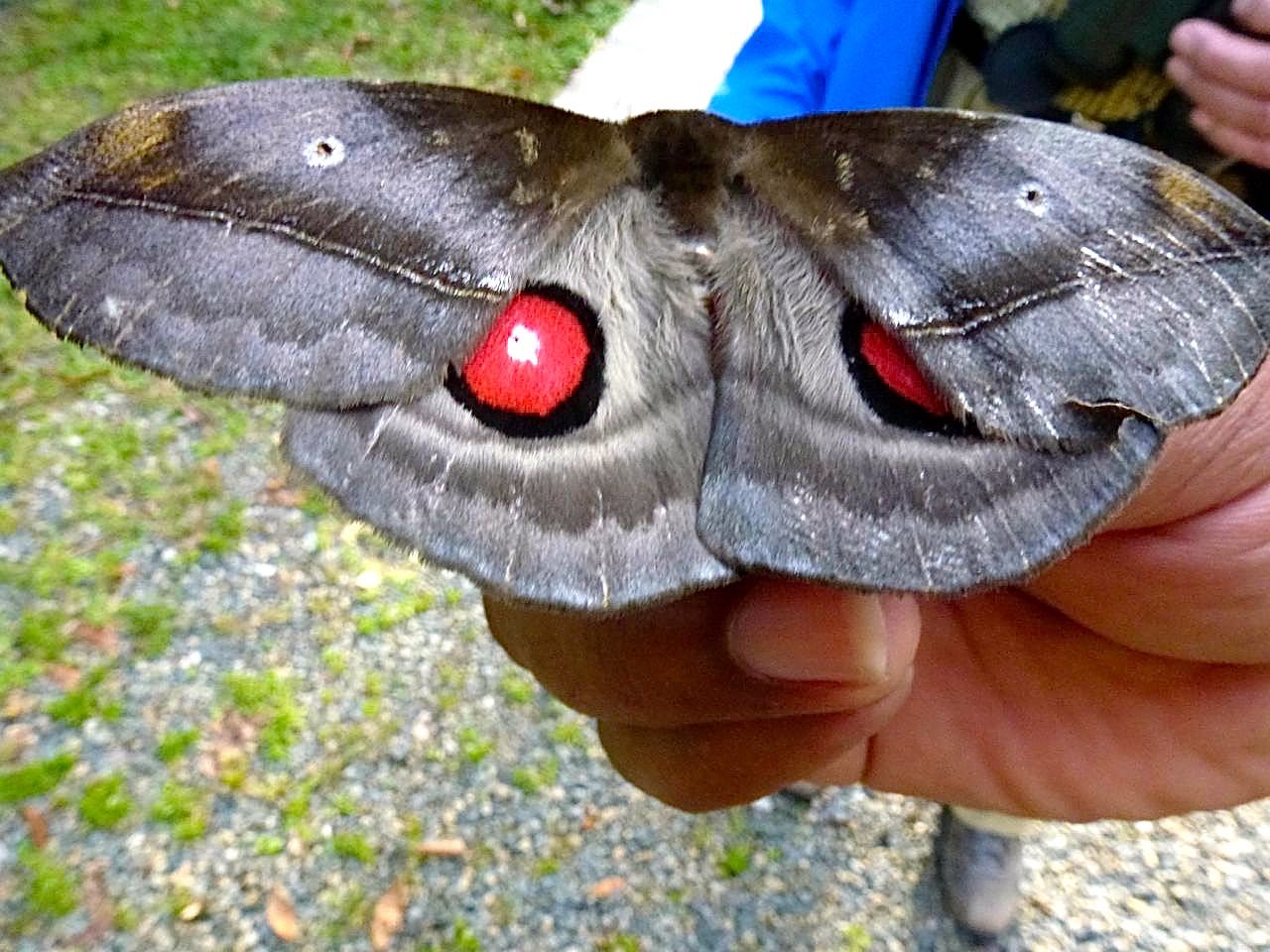 Moth - Photo by William Young
Moth - Photo by William YoungWe were in an area near an educational facility called the Serpentarium where people can learn about snakes. Two of the people who worked there had found a Boa Constrictor who was only a few days old. It was on a stick, and we had to be careful when taking pictures, because it was coiled in a position from which it could strike. In a nearby bush, we saw a pair of Black-striped Sparrows, while a Keel-billed Toucan called from the top of a tree. Noisy Great Kiskadees were in the area, along with a Clay-colored Thrush and Lemon-rumped and Plain-colored Tanagers. Michael showed us a tree that had some mistletoe growing on it, probably from seeds deposited by a Paltry Tyrannulet.
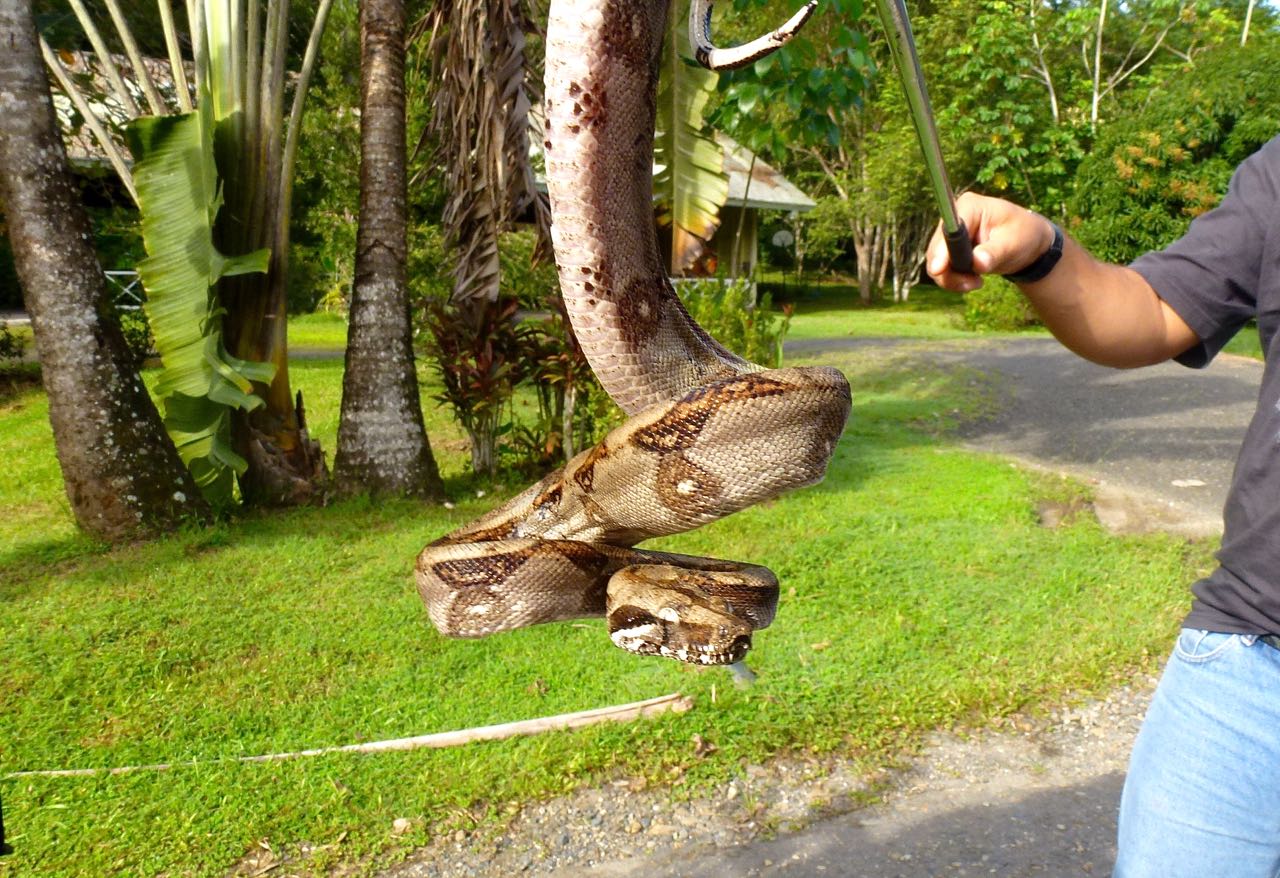 Boa Constrictor - Photo by William Young
Boa Constrictor - Photo by William YoungWe walked up a road where I had on a previous visit seen workers eating raw sugarcane. We saw a pretty butterfly Michael identified as a Gray Cracker, so named because of noises it makes during its breeding season around April. It was on the multi-colored bark of a tree; Matt said the colors represented different communities of lichen. We then walked along a path into the woods. A new bird for the trip was a Black-headed Saltator, who looks like a Buff-throated Saltator with a white throat. Seeing this bird meant that I would see at least one new bird for the trip every day I was in Panama. There was a handsome female Dot-winged Antwren, who is rufous below. A large kettle of migrating Turkey Vultures soared overhead. I saw a Cocoa Woodcreeper and noticed that they go down a tree feet first. We saw a White-whiskered Puffbird, a Gray-headed Tanager, a Checker-throated Antwren, and a female Spotted Antbird. A small group of Orange-chinned Parakeets flew over. We heard the loud song of a Bay Wren and had a nice look at a Western Slaty Antshrike. We saw the two-toed tracks of a peccary. A Plain Xenops was behaving like a woodcreeper. We found a Lineated Woodpecker, and saw an Olivaceous Flatbill, who was calling frequently.
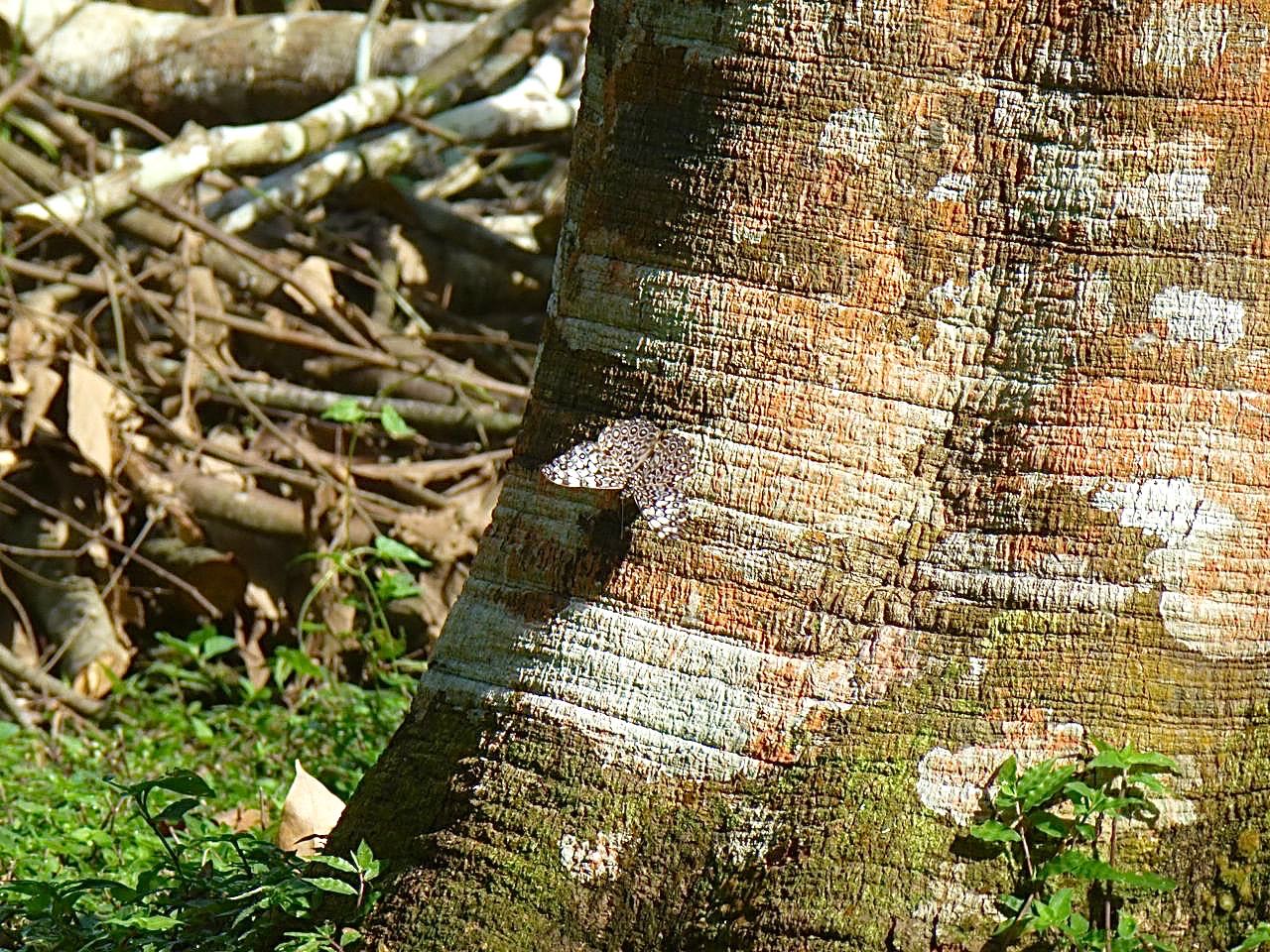 Gray Cracker on Lichens - Photo by William Young
Gray Cracker on Lichens - Photo by William YoungToday was sunny and clear, which made a huge difference when looking at birds. One of the birds I saw differently was a male Golden-collared Manakin. The other one I had seen was on a branch deep in the woods in fading daylight. This one was in bright sunlight, and I saw the beautiful yellow collar and neck, along with his bright red legs; the collar really glistens. I saw a Southern Beardless-Tyrannulet, a Yellow Tyrannulet, and a Forest Elaenia. A Scrub Greenlet was in a nearby tree, singing persistently; we had a really good look at its pale eye and pink bill. A Cinnamon Becard foraged actively on the other side of the road. We saw a male Fasciated Antshrike and both Yellow and Chestnut-sided Warblers.
As Michael drove up Semaphore Hill Road for my final time, he stopped so that we could see two lovely birds. A Blue Dacnis foraged in a tree, and the same tree contained a male Blue-crowned Manakin close to the road on a bare branch. I'm glad that the final species of my final trip turned out to be a manakin.
When I got back to the Tower, I had a number of things to do relatively quickly. I had to shower and get cleaned up for my flight home. My flight was scheduled for 6:48, but Panama continued to have demonstrations about the Colon land sale legislation. I was told I should leave the Tower as soon as possible. I said my good-byes to people, including Michael, who is an excellent guide. He never uses tapes, and I assume that he must have perfect pitch, because he is capable of imitating a remarkable number of birdsongs and other animal sounds. I also said good-bye to Matt and Nicola. It was great to bird with them after they arrived on Monday night. They added many dimensions to the way I experienced the rainforests with their knowledge and interest in spiders, insects, plants, mosses, and a lot of things that I would have glossed over while looking for birds. And I went to the window in the dining area to say good-bye to the sloth, whom I enjoyed watching so much during my visit.
Our ride to the airport turned out to be uneventful. We took a longer route that avoided Panama City, so I arrived at the airport a bit after two. It gave me time to write the final installment of my field notes.
The trip was much more physical than I anticipated, but I held up pretty well. Today was a fairly ordinary day in Panama, but compared to what I am used to, it was extraordinary. The word "galore" comes from a Gaelic word that means "enough". Somewhere along the line, the meaning changed from being enough of something to being a profusion of it. In Panama, I saw birds and nature galore, in both meanings of the word.